African Bowhunting
the theory and the practice
Compiled by Harry Marx
3rdEdition
Revision 2011/03/24 07:47:28 AM
This book is also used by the South African Bowhunter's Association for its Bowhunter Proficiency Certificate (BProC)

In this introduction to bowhunting the focus is on the theory, practice, reasons and larger picture for the curriculum. These proposed practices for bowhunting are implemented in SABA's Bowhunter's Proficiency Certification (BProC). Later on we talk about the animals themselves, hunting tips, etc. The idea of self regulation can only work if you have the tools with which to make informed decisions. The attitude we take in this book is therefore to provide you with these mind tools, and not to define rules.
 |
| After two years this project finally came to print. We as the bowhunting community of South Africa would like to thank all the people who contributed willingly or not, wink-wink, to it. Many names come to mind, but to name any would be unfair to a lot. So rather I will stand with "Thank you all." Also, to my family and friends, who frequently had to listen to, and endure my enthusiasm on a new find or contribution, thank you. |
<%
Dim AnchorCount
Dim Content
AnchorCount = 0
%>
Contents:
1 Foreword
| This book, or project, is very much a product "in the making". It is also a
product that evolves with new technology and insight. And then it is not a
product of one person, but rather a collaborative work by many bowhunters and
technical minded ones. It contains a lot of theory, to underwrite two concept we
followed: one - we question every opinion and try to find scientific evidence
for or against it, and two - we test the outcome of the theory against what is
seen in practice. It is not needed to know or understand this theory to hunt
successful, but if you want to tell someone how they should hunt, you better
have some scientific backing. Some of the ideas is still very speculative, and
lacks experimental backing, but the major thrust is to build theory that
explains, and not only describes, what we see. And then it contains lots and
lots of practical information. The practical side of it also growing, evolving,
and adapting... |
2 Introduction
 A note on conventions: All the text that is marked like this, is considered as crucial to bowhunting.
A note on conventions: All the text that is marked like this, is considered as crucial to bowhunting.
2.1 Why Bowhunt?
| Bowhunting can be easy, or very difficult, as you choose. Sitting in a hide, you
only need to have lots of patience. Hunting by "walking and stalking", with a
bow however, can be very challenging. You need to get very close to the animal,
and then draw the bow, and shoot, without being seen.
But in general, hunting with a bow is a much more intimate process than doing it
with a rifle. You need almost to smell the animal before you can shoot.
Frequently the hunter sees the bleeding animal, and sometimes sees the animal
goes down. However the bowhunter strives for a quick kill, which is the very
central objective of this book.
|
Further Reading: Engee Potgieter, AB&A, Feb 2008, p19, "Why Bowhunt?"
Ricardo Rademeyer, AB&A, Feb 2009, p27, "Respect your quarry"
Seppie Celliers, AB&A, Apr 2009, p53, "Jy moet eers kruip voor jy kan loop"
Herman Brand, AB&A, Apr 2008, p54, "Waar is die pret?"
2.2 Is "minimum requirements" for hunting sensible?
| Before we can discuss the theory of penetration, we need to make a judgment call
on a more fundamental issue - when do we consider penetration as "enough"? In
other words, when do we consider an arrow that hit its target, as lethal? This
sounds rather strange, since we all know exactly when an animal is dead or not.
The question we are posing is of a slightly different nature. Yes, we know
whether a particular animal is dead, but we need to determine when it would have
died, before we make the shot! Hindsight is not allowed.
In general, when measuring any attribute of a system, you will probably get a
slightly different reading each time you do the measurement. And getting a more
accurate chrony will help only slightly, since it only measures the differences
with more accuracy. Such measurements usually group around an average, which is
usually very close to the "real" value. What is very important to notice about
this situation, is that no matter how many times you measure an attribute there
is always a chance that the next measurement will be smaller than the smallest
you have made so far. And the more measurements you make, the bigger the chance
you will get an even smaller one...
In contrast to this, the more measurements you make the better these values
group around the real value. In more scientific terms, the error you make on
using the average of the measurements to predict the real value, decreases with
an increase in the number of measurements.
In bowhunting terms, this simply means that no matter what minimum value you
quote, based on the success of a hunt, someone will kill the same species with a
lesser arrow.
We can compare this dilemma with a similar one faced in the pharmaceutical
industry when they try to define exactly how lethal a poison is. One solution
they found was the so called LD50 value. This is a dose at which half the
animals died, and half survived, when tested. But we are interested in what
dosage will in "all" cases results in death. Clearly, there are people that
survive even severe overdoses. Likewise in hunting, we would like to apply an
arrow that in "most" cases, results in a quick kill.
The question we therefore ask is what percentage of the experimental animals
must have died before we as hunters would call the arrow "enough"? (Enough then
being the "minimum requirement".) Let us just for the sake of argument consider
a LD80 as "enough".
The next step would then be to classify all hunts in two categories, kill or
wound. We can then simply draw a graph of all the arrows against these two
categories, and thereby see where 80% of the hunts were successful. But here we
run into a slight problem.
LD50 values are no longer generated for new chemicals. Anyone can guess why? For
one it is extremely expensive, and for two, it is not a very humane procedure.
Likewise, I doubt if even a few of us has a budget to do this on a hunting
scale, let alone the time, and the animals.
Another approach would then simply be to use all the data as reported by all the
hunters. Problem with this is that one, the number of wounds are always under
reported, and two by the nature of hunting, hunters try and avoid the wounding
half. So we are left with data that portrays only one side of the coin, lethal
hits.
This brings me back to the general observation made previously, we have only
lethal hits, and forever somebody will have a successful hunt with a lesser
arrow/bullet. But we know, there is some minimum value where the arrow will
simply bounce of the animal, and determining it is not really difficult. We
would need to start with a ten pound bow, and slowly increases the poundage,
until the animal dies from the wound in an acceptable time.
Research done by Friis-Hansen (1990) indicated that a 15mm wound diameter
penetrating to half the thorax's depth is lethal generally within 10 seconds. A
7.5mm wound needs to traverse the whole thorax before it is as effective. The
problem is therefore not to determine the minimum required damage, but what's
the minimum required arrow that will cause it. The cutting diameter suggested is
much less than what we would consider a standard hunting tip - 1" (25mm). Which
is good - we are on the safe side. The question however is how deep can our
equipment push it? For the average senior male compound hunter, this question is
of less importance, but to women, younger, and traditional hunters, this
question is crucial. Also, if accuracy is affected by too much draw weight, a
good approach to regain it is to reduce the poundage - but how far can we go?
More on this later, see Required Penetration Depth.
There is a more fundamental issue with minimums - everybody (as per human
nature) would adapt to simply satisfy this minimum value. You can imagine the
increase in wounds, even with good shot placement (bear in mind that the
arrow/bullet, although aimed at the lethal area, and even hitting it, is not
guaranteed to penetrate "as advertised".)
We would like to suggest an alternative with this book, to use the average of
the ballistic attributes of all lethal shots, as an optimum value. The closer
your setup is to this optimum, the better your chance of using equipment that is
"enough". This may indeed lead to a situation where some people, by choice or
ignorance, accept these values as absolute minimums. We therefore try to
indicate with each optimum value, the range of acceptable values, by providing
some measure of the minimums as well. (Again, by definition, minimums are very
unreliable and unpredictable.)
We then suggest that as a hunt is planned with each hunter's accuracy in mind,
likewise it comes natural to consider the degree to which the hunter's equipment
satisfies this optimum. |
3 In Theory
3.1 Penetration Ability
 The biggest factor affecting a hunt is shot placement. The meanest arrow that misses a vital organ is going to cause great suffering. Therefore the first general guideline is always to choose the highest poundage that can still be shot accurately. Accuracy should never be compromised in favor of penetration ability (PA) (or generally referred to as KE or momentum). The target species should then be limited as suggested by your set-up.
As a general rule of thumb, it is proposed to shoot with the heaviest arrow that still attains about 240-250fps. A quicker arrow will not be a safeguard from string jumping (where the animal being shot at tries to escape when hearing the bow or arrow's sound), instead the best protection is to limit the distance of the shot (or to make the bow as quiet as possible). The effect of increasing the speed or decreasing the distance will theoretically have the same influence on the animal's time to react. However, to gain speed a compromise with lower arrow weight or higher draw weight has to be made, which in turn effects penetration ability (PA) or accuracy.
Further Reading: Koert Pretorius, AB, Nov/Dec 2000, p19, "Jumping the string"
The biggest factor affecting a hunt is shot placement. The meanest arrow that misses a vital organ is going to cause great suffering. Therefore the first general guideline is always to choose the highest poundage that can still be shot accurately. Accuracy should never be compromised in favor of penetration ability (PA) (or generally referred to as KE or momentum). The target species should then be limited as suggested by your set-up.
As a general rule of thumb, it is proposed to shoot with the heaviest arrow that still attains about 240-250fps. A quicker arrow will not be a safeguard from string jumping (where the animal being shot at tries to escape when hearing the bow or arrow's sound), instead the best protection is to limit the distance of the shot (or to make the bow as quiet as possible). The effect of increasing the speed or decreasing the distance will theoretically have the same influence on the animal's time to react. However, to gain speed a compromise with lower arrow weight or higher draw weight has to be made, which in turn effects penetration ability (PA) or accuracy.
Further Reading: Koert Pretorius, AB, Nov/Dec 2000, p19, "Jumping the string"
| There are people that propose that the biggest factor is actually not shot
placement, but penetration ability. They are not wrong. (We will discuss it as
the 2nd biggest factor.) The reason for this divide is simple. Hunters with
above adequate equipment, have less problems with penetration, and more with
shot placement. Hunters with marginal equipment have more trouble with
penetration than shot placement. We simply believe the majority of people do
have adequate equipment.
In defining the minimum recommendations, no absolutes can be stated, since there
is simply no minimum force which will result in death. For ex., a knife can be
used to kill extremely successful. When we are talking about the minimum
recommendations for hunting, of course a knife is generally not acceptable. So
an assegai can also be subject to analysis. Spears carry between 100 and 160
ft.lbs of energy and about 4 slug-feet/second of momentum, and they weight about
2 to 5 pounds. This is far beyond all generally suggested minimum
recommendations even for hunting elephants and hippo. Clearly, the particular
tool has a major influence on our opinion as to its suitability. In fact this
hints to the unsuitability of energy or momentum, and suggests rather a new one
of optimum penetration ability (PA), that will become the focus of this book.
This optimum values should suggest values that reduce the risk, and are close to
generally used values.
At the same time care should be taken that these optimum values are not
interpreted as "minimum" by the casual reader. If we for example look at arrow
weights as recommended for buffalo, a value of 900gr may seem excessive. Again,
this should be seen as an optimum value. A sensible absolute minimum would
probably in the region of 720gr, or about 80% of the suggested value. Therefore,
although 900gr is suggested, the software accompanying this manual uses 80% of
this recommendation as minimum value for all values.
Of course absolute minimums do exist, and can easily be demonstrated with the
inability of a blunt stick thrown at an animal. We will try and answer this as
well.
|

 The second biggest factor affecting a hunt is this penetration ability(PA).
The second biggest factor affecting a hunt is this penetration ability(PA).
| Although kinetic energy and momentum are traditionally used as indicators in the
hunting community, it has severe shortcomings when applied to low energy weapons
as discussed above, and is being replaced by something called momentum density,
but more about his later. High energy projectiles kill not only due to the
passage of the projectile, but also due to the cellular damage caused by high
energy shock waves generated by these projectiles. In most cases, this secondary
effect of the shockwave is by far more disruptive than the passage of the
projectile, and a direct result of high kinetic energy. In low power projectiles
like spears, arrows, knifes and darts, no such secondary effect exists - only
the primary damage of the projectile's passage is relevant.
Poncelet published an equation that describes penetration long ago in 1850. In
recent times the American Air Force Research Laboratory used this equation as
bases for their work in maximum penetration depth. In 1996 at the 7th
International Symposium Of Weapons Traumatology And Wound Ballistics a paper was
presented, and also published in the Journal of Trauma-Injury Infection &
Critical Care. 40(3S) Supplement:50S-52S, March 1996. The authors developed a
model to simulate a person, with and without protective armor, being subjected
to an impact of a high speed, rigid projectile. Target resistance force was
obtained from a generalized Poncelet equation. Good agreement between observed
and computed penetration phenomena was obtained.
Dr. Ed Ashby published results indicating that arrow mass of about 650gr is
needed to crush heavy bones, and that increasing the weight further did not
greatly increase penetration. This result is predicted exactly by Poncelet, in
that the equipment used by Ashby reaches a maximum predicted penetration using
650gr. and any further increase in arrow mass does not predict any deeper
penetration.
This equation, SABA applied to archery, not with the purpose to calculate
penetration, but for investigating the relationship between speed and weight and
its correlation to penetration. The result of investigating penetration into
bone tissue, showed a relationship between weight, speed and penetration that
exactly mirrored weight x speed squared, or kinetic energy. The result for soft
tissue was totally different and there the relationship closely resembled
momentum: weight x speed to the power of 1.3, where momentum is of course weight
x speed to the power of 1. This clearly demonstrates the reason why different
researchers favour different indicators (momentum vs. kinetic energy) as
penetration indicators.
Bradly Hunt from Alkali International, published an article on AmmoGuide.COM
called A New Concept in Deep Penetration of Solid Rifle Bullets in Large
Animals. He describes a penetration index used in the big game hunting community
where PA equals the square root of Kinetic Energy X Sectional Density / Frontal
Area.
This immediately can lead to the false impression that they are using kinetic
energy! In fact, in his own words, this equation can be shown through
dimensional analysis to be identical to that of momentum density: Penetration
Index = Momentum / Frontal Area. And finally, Dr. Ed Ashby with numerous and
long term studies found penetration of arrows from traditional bows to be highly
correlated to momentum.
Looking at this issue from the view point of physics, on first inspection when a
mass is accelerated with a force, the energy transferred is the sum of the force
at each point differentiated on the distance it travelled. In other words, the
energy is what makes it possible to continue travel against a force. Or to put
it even more simple, the force multiplied with the distance. Momentum is in fact
very similar, but it looks at the force applied multiplied with the time it was
applied. Energy looks at the force from the perspective of the distance, and
momentum from the perspective of time. However, physics also defines energy is
the ability to do work. According to physics, we must start from energy.
On deeper inspection, two things work against this simplistic model. The force
that resists the movement for an arrow is proportional to its speed squared
(friction between lubricated surfaces). This implies that the friction component
of the force stopping the arrow, increases with the same rate as the energy
increases if it's due to speed being increased!
The second complicating factor is "collisions". In physics all collisions are
somewhere between purely elastic collisions (as when two billiard balls collide
and bounce of each other), and non-elastic collisions (when two sticky balls
collide and sticks together, traveling as one blob).
If you calculate the energy and momentum of the balls before and after the
collision, you will find an odd difference between the two cases. During elastic
collisions, kinetic energy and momentum is preserved, however during non-elastic
collisions (when arrows "get stuck" in the animal) only momentum is preserved,
and a certain amount of kinetic energy is lost.
When doing an experiment to test penetration, experiments are usually done in a
homogenous medium like ballistic gel. For material that is the same all over,
the amount of kinetic energy lost during such "collisions" are constant.
Therefore a good correlation is found with kinetic energy. However, when doing
this test with live animals, the amount of kinetic energy that is lost during
each shot differs greatly and unpredictable. However, the momentum is not lost,
and therefore shows a much better correlation to penetration.
Also if we look at Ashby's results more critically, he divided all the arrows
into two groups. Those that penetrated the ribs and flesh thereafter, and those
that was stopped by the ribs. After penetrating the bone (using kinetic energy),
he measured penetration into flesh, where friction turns the correlation to
momentum.
 The problem with defining penetration ability (PA) recommendations
is the great many factors influencing it, and the huge variation of penetration The problem with defining penetration ability (PA) recommendations
is the great many factors influencing it, and the huge variation of penetration
in different tissues by projectiles with marginal abilities. Factors affecting
arrow penetration, excluding the tissue type, as found by the studies of for
example Dr. Ed Ashby to have a high correlation, is momentum, and arrow design.
In arrow design are included the number of blades, the angle of the blades, the
cutting diameter, surface area, and the diameter of the shaft relative to the
hunting point's shaft diameter.
In an effort to quantify all these measurements, Dr. Ashby suggests the use of a
tissue penetration index ( TPI = length/(BladeCount x Cutting diameter/2) ).
This index captures most of the listed attributes, but excludes the effect of
the general size of the hunting point (see next table). It also fails to provide
for modern multi-blade hunting points with so called "bleeder blades."
 If you alter just the blade height, you also alter the blade angle, or as
If you alter just the blade height, you also alter the blade angle, or as
discussed here, the blade length. The last factor, which we actually already
quantified as blade angle, can also be understood in very simple terms. Short
and wide blades tend to "chop" into flesh, while longer blades with a smaller
cutting diameter tend to "cut" more. It is much easier to cut a steak by sliding
a knife over it, than trying to push the knife through without any sliding
movement.
And now we come to the broadhead's tip. There are even in something as simple as
broadhead tip, many flavors and types. The decision on the tip is usually a
compromise between penetration and durability. There are two major designs,
cut-on-contact tips, and chisel-tips.
|
 The chisel tips are very strong, and very robust. There are conical ones, square ones, triangles, and some have the flat areas of the tip machined out. The main advantage of these tips is their strength. You can break bones with them, and they will still have cutting edges to penetrate flesh thereafter.
The chisel tips are very strong, and very robust. There are conical ones, square ones, triangles, and some have the flat areas of the tip machined out. The main advantage of these tips is their strength. You can break bones with them, and they will still have cutting edges to penetrate flesh thereafter.

 The cut-on-contact (coc) types are less durable, and may fail on hitting bone. However, their penetration in hide and flesh is by far superior to the chisel nose broadheads.
The cut-on-contact (coc) types are less durable, and may fail on hitting bone. However, their penetration in hide and flesh is by far superior to the chisel nose broadheads.
| The difference in penetration can be demonstrated very easy. Put a rubber
padding on a bathroom scale to receive the nock of an arrow, and push a piece of
leather against the tip trying to measure the force needed to get penetration.
Chisel nose tips frequently needs more than 20 pounds of force to penetrate into
a piece of deer skin leather, while coc tips may need as little as 2 pounds of
force for complete penetration. So if you are sure about shot placement (which
you actually should be), coc tips do wonders; if you are afraid of leg bones,
the chisel nose tips are better.
Another idea that can be pushed too far is to make the blade VERY long, like for
example 3 or more inches. The question that comes up then is when does the
surface friction of this long blade cancel the advantage of the very low blade
angle?
|
 You must remember that all animals are very heterogeneous, and consists of very hard bones, very tough sinews, muscles that move across the arrow's path, and right at the other end of the scale, tissue that is largely just airbags (lungs and genuine airbags in birds). The ability of an arrow to penetrate these is dependent on the arrow's mass and its speed. The importance of mass vs. speed changes as the hardness of the material changes. For some materials kinetic energy, where speed is much more important than mass, will be indicative. For other materials, speed plays a relatively small role in relation to mass.
You must remember that all animals are very heterogeneous, and consists of very hard bones, very tough sinews, muscles that move across the arrow's path, and right at the other end of the scale, tissue that is largely just airbags (lungs and genuine airbags in birds). The ability of an arrow to penetrate these is dependent on the arrow's mass and its speed. The importance of mass vs. speed changes as the hardness of the material changes. For some materials kinetic energy, where speed is much more important than mass, will be indicative. For other materials, speed plays a relatively small role in relation to mass.
| If we look at the VERY heavy caliber hunting rifles, used for the real LARGE
animals, penetration of 2 meters can be attained, and the best indicator thereof
is momentum density. This very much underlines SABA's recommendation to focus on
momentum, as mass and speed, to be used as primary indicator of penetration
ability.
But let us look at the broadhead blades in more detail. I guess you would not
easily catch a bowhunter reading articles on kitchen practices, but one
particular subject is very relevant - how much force does it take to cut meat
with a knife? Apparently, for somebody doing this job for a life, it means quite
a lot. Anyway, the answer is relevant to broadheads too. Using very
sophisticated equipment (no, really!), they measured this force to be
proportional to the tangent of half the angle between the blade, and the
direction it travels. The exact value is not surprisingly influenced by the
cut’s direction in relation to the muscle fibers, and how tough the meat is.
Values like 10 to 20lbs per inch across the grain are typical. (In experiments
we describe later, a value of 8lbs/inch was measured, but do notice we were
cutting with the grain.) This force can also be called the cutting resistance
(R), and it is mathematically much easier to work with this resistance, rather
than ease of penetration (its inverse).
The cutting force is directly proportional to the tan of half of the angle of
the blade to the direction of the cut: tan(A/2). This value can be approximated
to a fair degree using the Sin of the full angle, or exactly as Dr. Ashby
reported, the cutting length of the blade divided with the blade height. A more
accurate way to calculate it is to use the height squared and then divided with
the length of the blade's edge added to the length of the blade's base. This
relationship is also applicable to the angle used to sharpen the blade at, and
the angle at which chisel points are made. |
Further Reading: Cleve Cheney, AB, Jan/Feb 2001, p24, "Arrow penetration - Is there more to it than kinetic energy and momentum?"
3.1.1 Penetration Index - A new formula
 In an effort by SABA to define a more comprehensive index, a new formula is suggested. Herein the following assumptions are made about the hunting point:
1) The larger the point size (cutting diameter), the more difficult it will penetrate,
2) The larger the angle of the blades with the shaft, the more difficult it will penetrate (reaching a maximum at 90°),
3) The more blades it has, the more difficult it will penetrate.
In an effort by SABA to define a more comprehensive index, a new formula is suggested. Herein the following assumptions are made about the hunting point:
1) The larger the point size (cutting diameter), the more difficult it will penetrate,
2) The larger the angle of the blades with the shaft, the more difficult it will penetrate (reaching a maximum at 90°),
3) The more blades it has, the more difficult it will penetrate.
| Going from #1 to
#2, you would
expect the force
needed to cut flesh
to half, from #1 to
#3, it should
double, and from #3
to #4 it should
also about double
(or be about 4x
that of #1). Using
the relationship of
H.tan(A/2), which
is the same as
H2/(L+x), where x
is the length of
the blade along the
shaft, we can see
this pattern,
except for #4, |
| which results in just more than 3.5x the force needed than for #1. For our
purposes it will suffice. |
| If you look at the
table below (made
with the Tan(A/2)
principle), you
will see that
increasing the
blade length
(changing from
blade #1 to blade
#2 as in the above
picture), reduces
the force needed
to cut (going
right on any row).
I.e. double the
blade length, and
the force needed
is halved. |
| When going from #1 to #3, as in the above picture, you can see that what we did
was in effect to add another blade - doubling the force needed. This you can
follow in the table below by travelling diagonally to the right and down.
And lastly going from #1 to #4, you can see we doubled the blade height and the
angle, so the resistance or cutting force needed almost quadrupled. This you can
follow in the table by dropping down straight in each column. The resistance of
each blade is theoretically proportional to H2/(L+x), or its height multiplied
with itself, divided with sum of the length of the cutting side and the shaft's
side. This index directly mirrors the tangent rule as measured with knifes. (It
is also an extension of Ashby’s method, which employs H/L, but which is
insensitive of changes from #1 to #3).
The cutting resistance of the whole broadhead then becomes the sum of all the
blades’ resistances. For example, taking a two bladed broadhead with a cutting
diameter of 1", and blade lengths of 1", each blade’s resistance index is 0.063,
and the total blade resistance is then 0.13.
(Keep in mind we are talking about resistance here, and want a small as possible
value.)
A table of various blade designs is provided highlighting the sensitivity and
variation in this index:
Blades CD L CD(mm) L(mm) H(mm) TPI H2/(L+x)
The first 3 rows increase the cutting diameter. The new factor is
slightly more critical of cutting diameter than TPI.
2 1 1 25.4 25.4 8.9 1.00 1.00
2 1.25 1 31.75 25.4 12.1 0.80 0.71
2 1.5 1 38.1 25.4 15.2 0.67 0.54
In these 3 rows we only increase cutting blade length. Same as TPI.
2 1 1 25.4 25.4 8.9 1.00 1.00
2 1 1.25 25.4 31.75 8.9 1.25 1.26
2 1 1.5 25.4 38.1 8.9 1.50 1.53
In these 3 rows we only increase the number of blades. Same as TPI.
2 1 1 25.4 25.4 8.9 1.00 1.00
3 1 1 25.4 25.4 8.9 0.67 0.67
4 1 1 25.4 25.4 8.9 0.50 0.50
In these 3 rows we increase the overall size of the broadhead.
PI is sensitive to size while TPI is not.
2 1 1 25.4 25.4 8.89 1.00 1.00
2 1.25 1.25 31.75 31.75 12.07 1.00 0.91
2 1.5 1.5 38.1 38.1 15.24 1.00 0.86
CD: cutting diameter, L: Blade length, H: Blade height
Please note that H2/(L+x) were adjusted to the same scale as TPI in order to
compare their sensitivity.
But what about the tip? We can again employ the tangent rule where the more
acute the angle of the point, the less force is needed to cut and push the flesh
away. A 45° chisel would for example thereby penetrate 2.4x deeper than a flat
point. Cut-on-contact tips (where the broadhead has a blade at its tip) can then
be presented with two angles, one for the tip angle (usually about 60°) and the
other for the edge angle (usually about 20°). So the tip’s resistance becomes
something like k.Diameter2.Tan(A/2), where we still have no idea what the value
of k is. Now we have a total blade resistance, and a tip resistance. But how do
these relate together to penetration?
The force needed to penetrate is of course directly related to the resistance
the point feels when penetrating. A formula was derived from experimental data
that best describes the relationship between the dimensions of the blades, the
tip, and the resistance:
 St is the frontal surface area of the tip,
At the angle of the tip,
As the blade’s sharpened angle,
H the blade’s height,
L the length of the cutting edge
Ats, is At for chisel points and As for cut on contact points, and the result is
St is the frontal surface area of the tip,
At the angle of the tip,
As the blade’s sharpened angle,
H the blade’s height,
L the length of the cutting edge
Ats, is At for chisel points and As for cut on contact points, and the result is
in pounds. The resistance (Ro) is also the resistance at very slow speeds of
penetration - from there the zero on its toe. For how this relates to resistance
at speed, read on...
|
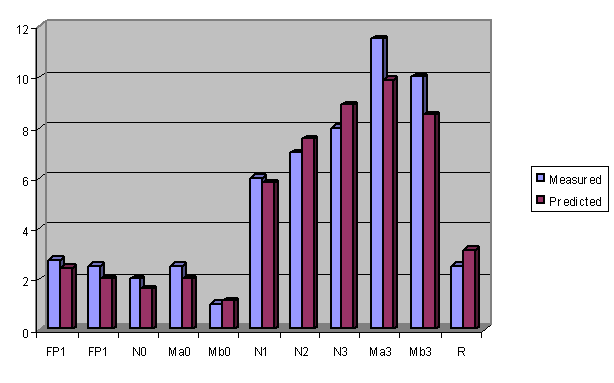
| This equation predicts how much resistance a broadhead of a particular design
will experience when pushed through muscle tissue very slowly. The graph on the
left is of predictions compared to actual measurements. This was for 2 different
fieldpoints, a Nitron with no blades, a chisel point mechanical with no blades,
a cut-on-contact mechanical with no blades, a Nitron with 1,2 and 3 blades, the
mechanical with chisel tip and 3 blades, the c-o-c mechanic with its blades, and
lastly a Razor Back 2 bladed c-o-c broad head.
So as a recap, we now are able to relate the blade's design directly to its
resistance to penetration. But we are still looking at the force needed to
penetrate. We are actually interested in how deep it will penetrate.
To calculate this we may want to start with kinetic energy, and divide it with
the resistance it experiences during penetration: D = Ek/Ro, as is done using
the basic laws of Newton. But this is where most kinetic energy disciples make a
fundamental error. This is only valid if the resistance was constant, and in
our case it is not. According to this erroneous assumption a 400gr arrow @
280fps (70vt.lbs), with the Ro = 2.75 + 0.5 pound fieldpoint, would penetrate
257 inches (yes, hundreds). The Nitron would go about 104"! But these numbers
are "slightly" too big, because the resistance we used is from slow penetration,
and ignores the effect speed has on friction.
In (Oct 2009) The Bowhunter magazine, it was discussed that friction is
proportional to the speed squared (v2). From our reasoning so far we can also
approximate that it will be proportional to the force needed to push the
broadhead slowly through the medium, plus a so called drag factor. This drag
factor is also called the skin friction, and grows with the speed squared. It is
also proportional to the surface area of the broadhead and shaft that is in
contact with the target. Lastly it contains a "form factor" that captures the
effect of the form. For this form factor, we can use an approximation or an
already known factor, that should follow it closely, the Ro.
For this growing resistance we will use Ro + (Ro.A + a)v2.
|
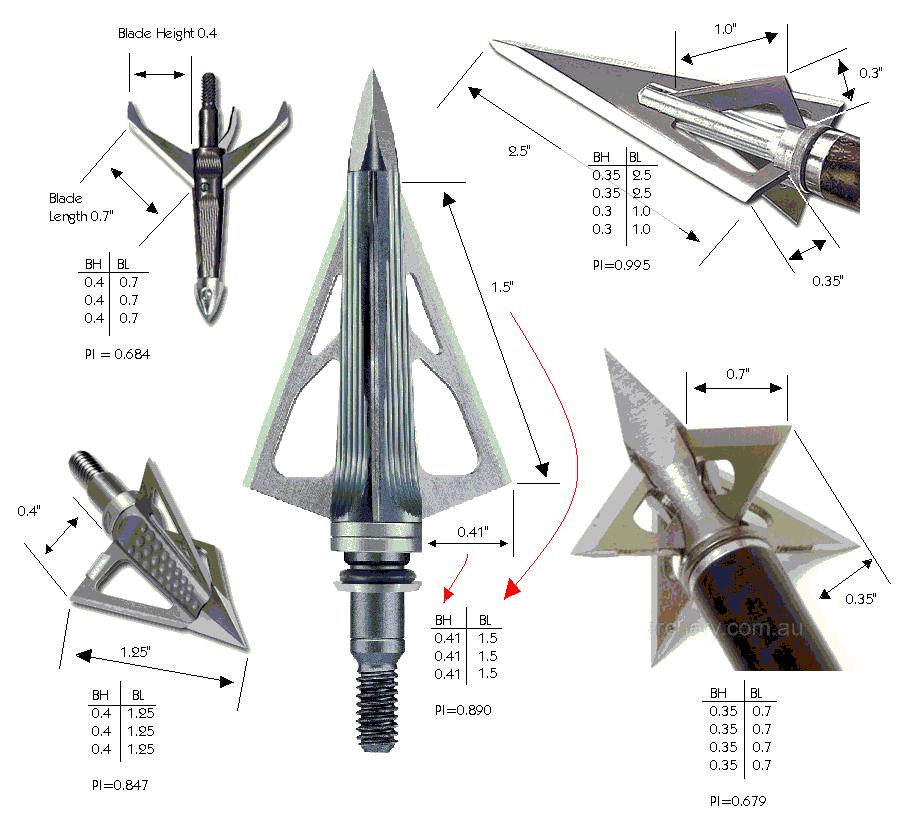
| The surface area for the broadhead is A, while the surface area for the shaft is
a. Note that Ro is applied as form factor only to the surface area of the
broadhead, as the form of the shaft for all arrows is constant, and not related
to it.
|
Here is the function developed for MicroSoft Excel:
Function PDepth( _
ByVal Ro As Double, _
ByVal m As Double, _
ByVal v As Double, _
ByVal dia As Double, _
ByVal a As Double, _
ByVal ds As Double, _
ByVal c1 As Double, _
ByVal c2 As Double, _
ByVal c3 As Double, _
ByVal KELoss1 As Double, _
ByVal BodyDepth As Double, _
ByVal KELoss2 As Double)
Dim s As Double, d As Double, PI As Double, KE As Double, vv As Double
PDepth = "err"
PI = 3.141592654
s = 0 'initialize distance penetrated
If Ro < 2 Then Exit Function 'too little Ro, model will crash
If ds <= 0 Then ds = 0.001 '1 mm steps
'limits the minimum speed to about 140 fps
v = v - ((c1 / v) ^ c2 - 1)
If v < 0 Then Exit Function
'SI units
Ro = Ro / 2.2 * 9.8 'lbs to Newton
m = m * 0.065 / 1000 'grains to kilogram
v = v * 12 * 2.54 / 100 'fps to meter per second
dia = PI * dia * 2.54 / 100 'shaft dia in inches to shaft area in
'meter squared per meter shaft
a = a / 1550.0031 'inches squared to meter squared
BodyDepth = BodyDepth * 2.54 / 100 'inches to m
KELoss1 = KELoss1 * 1.359431604 'foot pounds to J
KELoss2 = KELoss2 * 1.359431604 'foot pounds to J
If KELoss1 > 0 Then 'modeling bone penetration as loss of energy
' this is valid as penetration into bone is related to KE
KE = m * v ^ 2 / 2
KE = KE - KELoss1
If KE < 0 Then Exit Function 'if we don't get through the bone, done
v = (KE * 2 / m) ^ 0.5 'get the speed exiting at back of bone
End If
vv = v ^ 2 'meter per second squared - we will loop using vv
s = 0
Dim aa As Double
Do While vv > 1 And s < 10
If s > BodyDepth + 0.75 Then ' [ ] ------------->
Ro = 0
a = 0
aa = 0
PDepth = 999
Exit Function
ElseIf s > BodyDepth And s > 0.75 Then ' [ ----]------->
aa = (0.75 - (s - BodyDepth)) * dia
a = 0
Ro = 0
ElseIf s > BodyDepth Then ' --[-------]--->
aa = BodyDepth * dia
a = 0
Ro = 0
If KELoss2 > 0 Then ''exit rib breakage energy loss
KE = m * vv / 2 - KELoss2
'if we don't get through the bone, done
If KE < 0 Then exit do ' --[-------]
vv = (KE * 2 / m)
KELoss2 = 0
End If
ElseIf s > 0.75 Then ' [ ------------> ]
aa = 0.75 * dia
Else ' ------[----> ]
aa = s * dia
End If
d = (Ro + (Ro * a + aa) * vv) / m
vv = vv - 2 * d * ds
s = s + ds
Loop
If s >= 10 Then
PDepth = 999
Else
PDepth = s * 100 / 2.54 'and return the result in inches
End If
End Function
|
| A similar modal was previously used by the author to predict the trajectory of
an arrow through the air, based on this same friction principle. The friction
(Fr) the arrow experiences at various speeds changes, so it also changes as the
arrow decelerates during penetration. This model involved simulating the arrow’s
path in small steps, and to calculate the friction at each step. But it requires
a "friction constant" (k). For the trajectory we could calculate k using two
measurements, at 1Y and 20Y, and adjusting k until it predicted the same speeds
as measured.
With penetration this is a bit problematic, since there doesn’t exist a reliable
measurement of penetration. So we will have to make use of "experience" to tell
us if it works or not. So far the best recorded experience we have is of Dr.
Ashby’s research. He found that between kinetic energy and momentum, the latter
showed a better correlation to penetration. Likewise, Poncelet predicts
theoretically a relationship of mv1.4. This is about halfway between momentum
and KE, just slightly closer to momentum.
Any IT-developers looking at the code, will notice that the current model does
NOT contain any constants that "scales" the results into "acceptable" values. In
fact rather the opposite, we have an arbitrary factor that increases the speed.
The reason for this is that the speeds at which adequate penatration is
achieved, is much less than what you would hunt at - due to string jumping and
arrow deflection issues.
In this model, we decided to make k=1, and see what happens. To our surprise,
the model predicts that for penetration into soft tissue, the relative
importance of mass to speed of the arrow is 1:0.998. I think you will agree with
me this is as close to 1:1 as a Robin Hood is to a nice grouping.
On the next page is an extract of some penetration predictions (in inches) of
the model
In this case we used a typical mechanical broadhead (3 blades). We also did not
hit bone on entry, and the soft tissue is always deeper than the penetration.
If we put a "real" animal in the model, this time an impala, the model makes
suggestions as below.
Here we see it asks 250fps for a 300gr arrow to stop against the far side rib.
This is by the way why you see such interesting values. All arrows seem to have
either too little penetration, enough to be stopped by the far side rib (8"), or
enough for a total pass through (999.0). As mentioned earlier, it is much more
difficult to break the far side rib than the rib on entry.
|
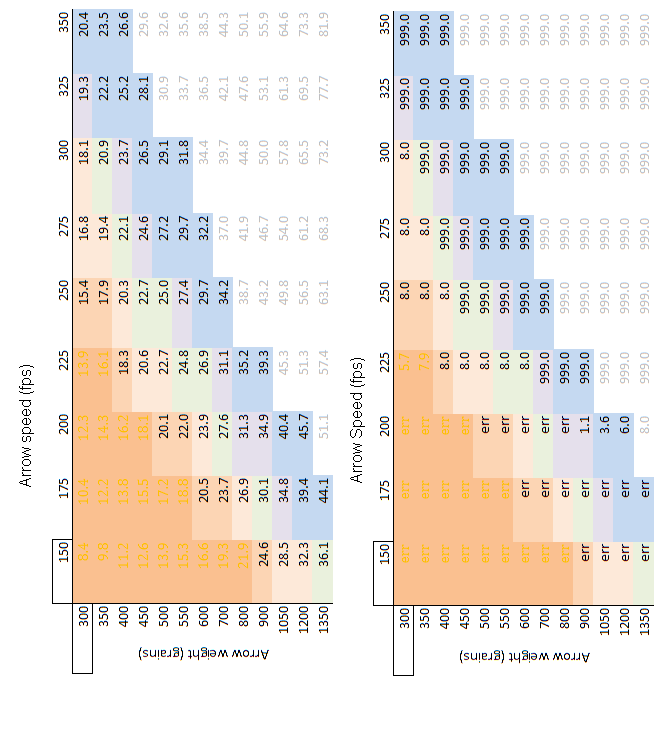
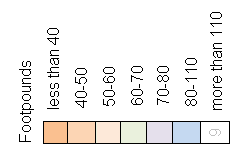
| The colours in the above table are indicative of kinetic energy.
But this is ALL only valid, IF THE ARROW NEVER TOUCHES A BONE!
How does these broadheads penetrate bone? It takes about 260 foot-pounds to
break a human leg bone, 65 foot-pounds to break an arm bone, and 22 foot-pounds
for a rib. This information is from forensic tests and quite reliable. As you
can see, a bone as big as your leg bone should stop ANY arrow, an arm bone will
severely slow the arrow down (200fps loss for a 750gr arrow) if not stop it, and
a rib will generally decrease penetration.
|
Speed loss for breaking rib on entry: (20 foot-pounds loss)
300 500 700
200 -100 -52 -35 As you can see, slower and lighter
225 -81 -44 -31 arrows looses more speed breaking
250 -70 -39 -27 ribs than faster and heaver ones.
275 -61 -35 -24
300 -55 -32 -22
| For the purpose to standardize energy loss and penetration, we propose the
kinetic energy loss (foot ponds) be calculated as the animals weight (in kg)
raised to the power of 0.25, multiplied with 4.5.
|
Approximation of energy needed to break a rib per animal mass:
Animal energy
weight needed
50 12
100 14
200 17
350 19
500 21
750 24
1000 25
2000 30
| Another interesting prediction we see is: when we take two arrows, weighting
900gr @ 200fps and 300gr @ 345 fps (both have kinetic energy 80vt.lbs) and say
both break a 25 footpound rib on entry, the 900gr arrow looses 18% of its
penetration, and the 300gr arrow only 13.4%. However, the 900gr arrow still out
penetrates the 300gr one by more than 50%.
But we are now loosing focus and are trying to define penetration in terms of
the target being hit, and not the broadhead. Although this is the reality of
hunting, the heterogeneity and all variables of a live animal being penetrated
by an arrow, is totally impossible to predict. Instead we limit ourselves to
muscle tissue, and the effect of a single rib on entry and exit. In other words,
we standardize the animal.
|

| Warning: Although tests like these try to prove heavier arrows have more
penetration, they rather reflect that the bow is slightly more efficient at
higher arrow weights. The medium is not comparable to wet tissue, but is
indicative of penetration into bone. |
What we do know is that penetration into bone is proportional to kinetic energy. The first observation is that most cut-on-contact point tends to bend when hitting bone. This severely inhibits penetration. The next observation is that blades that are beveled from a single side, tends to split the bone easier, and thereby penetrates better. Thin blades, as for example bleeder blades, tend to break when big game is hunted. Ashby reported what he calls a tanto tip to be most effective on traditional equipment. Of course, chisel tips are extremely strong, and rarely are damaged.
And when a broadhead breaks, it stops penetrations like a brick wall...
Lastly, we ask can a hunting point have too much penetration ability? Yes. We also propose recommendations on the minimum size of hunting points. This stresses the fact that a too small hunting point becomes a field point, which in essence minimizes systemic damage, and will prolong the bleeding time of the animal. So we clearly see that there is a need for proposed minimum and maximum sizes of hunting points. Also it is of no use putting lots of energy into the arrow, only for it to cut a small channel, and then to fly of another 300Y into the distance... At best, a broadhead should use most of its energy to cut, and only fall out of the animal at the other side...
Further Reading: Cleve Cheney, AB&A, Apr 2007, p27, "What is TPI?"
3.1.2 A Case Study on Friction
According to tribology (the scientific study of friction):
- Friction against "dry" hard surfaces are dependent only on the type of surface, and the force pushing them together. At low speeds, friction is independent of the relative surface speed. At higher velocities the friction actually decreases!
- Friction in fluids (air and liquids) is dependent on the viscosity of the fluid, the shape of the object, and the speed. If the speed is "relatively" slow, and no turbulence occurs, the friction is proportional to the speed, but if turbulence occurs (like an arrow traveling through air, water or oil), it is proportional to the speed squared.
- For lubricated surfaces the friction is almost independent of the force between the surfaces. At low pressures the friction varies directly as the relative surface speed. Above 2 fps the friction rises in proportion the velocity squared.
| Animals consist of a mixture of solids (bone), elastics (hide, sinew, muscle)
and liquids (water and oils). Fats are "oil-lubricated solids". So perhaps it’s
best if we look at lubricated hard surfaces and fluids. So for liquids, to the
best approximation, the arrow feels friction relative to its speed squared. This
is a force, which decelerates the arrow in relation to its mass: Deceleration =
Force/mass. The distance travelled during such a deceleration is according to
Newton s = ˝.m.v2 / Fr. Notice how close this formula looks like that for
Kinetic energy, but do not be tempted yet. The friction (Fr) is also
proportional to the speed squared!
So penetration becomes proportional to somewhere between m.v2/v, and m.v2/v2!
Which means that at one end of the spectrum penetration is related to momentum
(mv), and at the other end, only mass, for lubricated surfaces. Whow! So what
happened to kinetic energy?
Poncelet's formula takes the target's hardness (which resists breaking) and
density (which resists pushing the broken fragments out of the way) into
account. It shows us how the relative importance of speed falls as we shoot into
flesh rather than bone. Here we also see that friction favours mass over
velocity when shooting into flesh.
So in effect, the relative importance of arrow weight and arrow speed, as
indicator of penetration, is dependent on the type of material you shoot into.
We can look at his problem totally pragmatic. In order for an arrow to penetrate
a hard, thin substance, there is no friction involved, since it is not yet
passing through, it has only just arrived. Pushing the hole in the object, and
travelling into the hole is two different things.
On one of the discussion forums for Bowhunting, Anchor Point, a member reported
strange findings ("BoogSkutter"):
Poundage: 66lbs
Broadhead: Nitron 100gn
Fletches: 4 inch plastic vanes
Arrow A: Gold Tip 5575
Arrow B: Easton 340
Arrow C: Carbon Express Terminator 6075
BoogSkutter also used the same broadhead on all the arrows, so sharpness and
bent blades etc. were eliminated as influences.
Results: The Easton (422 grn) and the Gold Tip (370gr) penetrated deeper than
the Carbon Express (458gr). Which throws things on their head it would seem.
Now, lets look at all the attributes of these arrows closely:
gr Dia. Spine gpi FOC Fc% fps KE cP
Gold Tip 370 0.295 400 8.5 11 44 192 70 48
Easton 422 0.294 340 10.5 9.6 53 277 72 52
CarbExp 458 0.315 350 11.8 8.9 52 268 73 55
Fc% is the critical loading weight of the arrow as a percentage of the bow’s
draw weight, and is an indication of dynamic spine - values between 38% and 45%
is generally good (45 being the stiffest). (The definition of these attributes
is discussed later in full detail.) KE is kinetic energy and cP is the momentum
x100. So how can we explain the above anomaly, where both KE and cP is largest
for the Carbon Express arrow, but it penetrated the least?
When stating that heavier arrows penetrate better than lighter one, we are
assuming that all other variables stay the same. For these three arrows, not
only the weight changed, but the diameter, the spine, and the FOC. This caused
changes in for example dynamic spine, Fc%. The Gold Tip arrow is slightly on the
stiff side, but still in the green. The other two arrows are outside the range -
too stiff. Which would in general mean that the bow is slightly less efficient
than it should be, and the arrows are probably going to wobble a bit. However,
since the Easton penetrated the deepest, this can’t explain the result. If we
look at the momentum of the arrows, we also see that the Carbon Express, with
the most momentum, penetrated the least. Again, it does not explain the results.
The key is however the diameter of the arrows.
When big game rifle hunters talk about penetration, they talk about
momentum-density. This is the momentum divided with the frontal surface area of
the projectile.
Have a look at these values:
Dia cP Frontal Area cP density
Gold Tip 0.295 48 0.068 7.022
Easton 0.294 52 0.068 7.651
CarbExp 0.315 55 0.078 6.996
If we now look at the cP density, it explains why the Easton did the best. If we
took the FOC and dynamic spine into account, it also explains why the GoldTip
did 2nd best. But, these experiments were done in a cardboard box butt. What
effect would this have had? The tribologists would be tempted to say that since
the friction area’s were dry, the pressure on the bigger shafts was more and
faster speeds had slightly less friction, and so the Easton won. They would also
claim that if hunters shoot at flesh, friction is independent of surface
pressure, but goes up with speed squared. So in flesh, the Carbon Express would
have won.
The last point I would like to make on friction, is that there is even a
difference between shooting a live animal versus shooting into meat. Not only
does the temperature change the viscosity of the oils and fats, but in live
tissue, the muscle movement and tension pulls the muscle away from the arrow, if
the muscle is pulling against something. If the muscle is not pulling against
something, as when a leg is in the air, it can do the opposite, and pinches the
arrow. Friction therefore in live animals is not that prominent in these
recommendations.
Having said all this, with the intention to indicate the subtleties of friction,
how does it tie in with our recommended PA? The depth to which the arrow
penetrates is highly dependent on
1) the amount of energy the arrow reaches the target with,
2) the energy needed to cut the hole,
3) the energy needed to push the arrow deeper through the hole,
4) and the energy needed to push the cut flesh out of the way of the shaft.
The PA as described only addresses the "cutting the hole" part, and not the
friction to push it through, nor pushing the flesh away. In fact, it is this
very friction which "downgrades" the value of kinetic energy to momentum.
Likewise, at speeds of 285km per hour(!!!), or around 260fps, a typical hunting
arrow's speed, you can probably, with only your big tow, ski on water! Which
illustrate the substantial amount of force needed to move flesh out of the way!
|
3.1.3 Front of Center
| Other factors influencing penetration of projectiles are sectional density and
the centre of gravity of the arrow (FOC). Sectional density is the mass of an
object divided with it frontal surface area. Sectional density does play a major
role in arrow penetration, since the difference in arrow shaft weight. However,
the differences in diameter are usually very small. However, new technology are
decreasing arrow diameter, and this will need to be revised.
|

 FOC, or Front Of centre, is a term describing how far the centre of gravity of the arrow is in front of the middle of the arrow. This value is usually between 5% and 12% for target shooting, and 8% to 15% for hunting arrows. The FOC is in effect an indication of the flight stability of the arrow.
FOC, or Front Of centre, is a term describing how far the centre of gravity of the arrow is in front of the middle of the arrow. This value is usually between 5% and 12% for target shooting, and 8% to 15% for hunting arrows. The FOC is in effect an indication of the flight stability of the arrow.
| Where it plays a role in penetration is easiest to picture if an arrow is
imagined that hits a target slightly at an angle. Such an arrow's momentum,
acting through its centre of gravity, will push the point sideways and greatly
reduce penetration. For this reason a higher FOC makes the bowhunter's set-up
more forgiving for a slightly less than perfect arrow flight. This is in fact
the same reason an immediate unease was felt about using a spear to hunt an
elephant, as described elsewhere.
The FOC and total length of the projectile also defines the distance of this
centre of gravity from the impact point. A spear, although it may have a higher
kinetic energy, momentum and sectional density, has a much longer shaft. This
means the point is driven by momentum from a much further distance, which
greatly increases the leverage that will skew the penetrating projectile and
greatly reduces penetration. In general, the further forward the centre of
gravity is to the centre of pressure, the more stable the arrow is. Now the
reason for having a stable arrow is simple, it affects accuracy, and penetration. |
In archery terms we speak of the FOC of an arrow, which is a term to describe the position of the centre of gravity, relative to the centre of the arrow. It does not take the centre of pressure into account. FOC is calculated by first measuring the distance between the middle of the arrow, and the point on which it balances, then divide it with the total length of the arrow.
 The lower the value, the less stable the arrow, but also the trajectory is slightly more flatter. The arrow glides more. The bigger the value, the more stable the arrow, but the quicker it loses height. It glides less, and looses less speed over the trajectory.
The lower the value, the less stable the arrow, but also the trajectory is slightly more flatter. The arrow glides more. The bigger the value, the more stable the arrow, but the quicker it loses height. It glides less, and looses less speed over the trajectory.
| The higher the FOC, the longer the lever that the fletching has to steer the
arrow, and the shorter the lever for the broadhead to steer it.
Centre of pressure, can easiest be measured by sitting in your car, while
someone else is driving, while you hold the arrow out of the window. If you turn
it sideways in the wind, you will notice the wind pushing against it, trying to
turn it either point forward or tail forward. Somewhere along the shaft you'll
find a point where the wind's push on the arrow's tail and point is balanced.
This is the centre of pressure.
A more accurate indication of stability of an arrow is the distance between the
centre of gravity and this centre of pressure, divided by the length of the
arrow. But since driving around with your arm out of the window, holding an
arrow, can pose some serious safety hazards to pedestrians, FOC do quite well.
To calculate it, you first measure the distance from the nock's string hole, to
the centre of gravity, say this is 17". Then you measure the total length of the
shaft, from the nock's string hole to the insert in front of the shaft, say this
is 29". The FOC is now balance point length/total length - 0.5, multiplied with
100:
(17/29 - 0.5) x 100 = 8.6%
|
 The effect FOC has on penetration is threefold. Firstly it stabilizes the arrow for good flight, leading to a arrow that hits the animal without any vibrations. This causes better penetration, since the mass that is pushing the arrow from its centre of gravity, is centered exactly behind the broadhead.
Secondly, the moment the arrow hits the animal, a force is generated against the arrow that decelerates it. The higher the FOC, the shorter the lever this force has to tilt the arrow and negate all its momentum.
Thirdly, since the arrow can when hitting an animal, stops in the same distance it was accelerated to its flight speed, this force can be as big as the bow's draw weight. Buckling/bending of the arrow is therefore just as prevalent during penetration as during release. This bending will also affect penetration for again the penetration force is tilted away from the broadhead. The larger the FOC, the bigger the force that can be withstood by the shaft, since the bending force between the broadhead and the centre of gravity, is applied on a shorter piece of the shaft.
The effect FOC has on penetration is threefold. Firstly it stabilizes the arrow for good flight, leading to a arrow that hits the animal without any vibrations. This causes better penetration, since the mass that is pushing the arrow from its centre of gravity, is centered exactly behind the broadhead.
Secondly, the moment the arrow hits the animal, a force is generated against the arrow that decelerates it. The higher the FOC, the shorter the lever this force has to tilt the arrow and negate all its momentum.
Thirdly, since the arrow can when hitting an animal, stops in the same distance it was accelerated to its flight speed, this force can be as big as the bow's draw weight. Buckling/bending of the arrow is therefore just as prevalent during penetration as during release. This bending will also affect penetration for again the penetration force is tilted away from the broadhead. The larger the FOC, the bigger the force that can be withstood by the shaft, since the bending force between the broadhead and the centre of gravity, is applied on a shorter piece of the shaft.
| Finger shooters, and those shooting shafts less than 26 inches in length, should
probably look for a higher FOC. This is because shorter arrows are inherently
less stable, and finger shooters, once again, need a little extra help to
correct the normal arrow wobble upon release.
|
 Too much FOC, according to folk legend, makes your arrows point-heavy and causes them to drop quicker at long ranges. However flight-archery, where the aim is to shoot as far as possible, is breaking records with high FOC arrows! It does not affect arrow speed, in fact it preserves long range speed better. However, as hunting is not recommended at these long distances, it should not be a problem. Dr. Ed Ashby reports on what he calls extreme FOC penetration. These are arrows with a FOC above 15%, typically 20%. For these arrows he measured increases in penetration on buffalo of between 20% and 60%.
We can provide an empirical formula for his results, and it looks like this:
FOC's contribution = 0.55 * FOC9 / ((36 - FOC)9 + FOC9) + 1
This equation just follows a smooth path to effect the results Ashby saw in relation to FOC.
Too much FOC, according to folk legend, makes your arrows point-heavy and causes them to drop quicker at long ranges. However flight-archery, where the aim is to shoot as far as possible, is breaking records with high FOC arrows! It does not affect arrow speed, in fact it preserves long range speed better. However, as hunting is not recommended at these long distances, it should not be a problem. Dr. Ed Ashby reports on what he calls extreme FOC penetration. These are arrows with a FOC above 15%, typically 20%. For these arrows he measured increases in penetration on buffalo of between 20% and 60%.
We can provide an empirical formula for his results, and it looks like this:
FOC's contribution = 0.55 * FOC9 / ((36 - FOC)9 + FOC9) + 1
This equation just follows a smooth path to effect the results Ashby saw in relation to FOC.
 FOC and dynamic spine very much affect each other directly. The bigger the FOC, the bigger the buckling force the arrow experiences during release, and you will have to check that the critical loading of the arrow does not drop below 38% of the bow's draw weight.
If you are wondering what an arrow's FOC will be, but have not yet built it,
you can use the following equation to calculate it:
FOC and dynamic spine very much affect each other directly. The bigger the FOC, the bigger the buckling force the arrow experiences during release, and you will have to check that the critical loading of the arrow does not drop below 38% of the bow's draw weight.
If you are wondering what an arrow's FOC will be, but have not yet built it,
you can use the following equation to calculate it:
 where Wt is the total arrow weight,
Wi is the weight of each component,
L is the length of the arrow, and
Li is the distance of the component's center of gravity from the nock point.
Further Reading: Seppie Celliers, AB&A, Apr 2008, p30, "FOC - Front of centre balance"
where Wt is the total arrow weight,
Wi is the weight of each component,
L is the length of the arrow, and
Li is the distance of the component's center of gravity from the nock point.
Further Reading: Seppie Celliers, AB&A, Apr 2008, p30, "FOC - Front of centre balance"
JP de Villiers, AB&A, Feb 2008, p58, "FAQ's"
Dave Holt, AB, Nov/Dec 2000, p7, "Arrows - Heavy versus light"
Dave Holt, AB, Mar/Apr 2001, p9, "The Downrange decay of Arrow Velocity"
Herman Brand, AB&A, Dec 2007, p51, "Swaar of Ligte Jagpyle?"
3.1.4 Shaft Diameter
| The shaft of the arrow experiences friction during penetration, and as such
affects it. Experimental results have shown that an additional factor can be
multiplied with the achieved velocity or momentum, to accommodate this
influence. This shaft factor is based on whether the shaft of the arrow is the
same size or larger than the hunting point's ferrule's diameter. If the arrow's
shaft is the same size, a shaft factor of 0.9 should be used, while if the arrow
shaft is larger, a value of 0.6 should be used (if smaller 1.0). |
3.1.5 Shaft Tilt
| The model we are trying to develop has at its hart defining penetration in terms
of the arrow's attributes. But some of these attributes are not independent of
the target, for example the Ro defined elsewhere, which is a function of the
blade design and the type of material being penetrated. As such, we had to
standardize on some sensible medium. In looking at the effect of arrow tilt, we
are delving into even harder ground.
Ignoring this effect, leaves the model still accurate for shallow penetrations,
but less so when more of the shaft is involved.
The specific influence we are trying to discuss here is when an arrow hits a
moveable, moving, and gel like material, like flesh, the bending or tilted arrow
deflects, pushes against the wound channel, and in general tend to change
direction. Elsewhere it is suggested not to shoot across the wind, since the
arrow's tail is blown sideways by the wind, and for an arrow to hit the target
at an angle severely effects penetration. But how much, and what attribute of an
arrow works to minimize this effect?
At the same time, an arrow that hits a target, is decelerated over a similar
distance and time than when being released. It is therefore not surprising that
it flexes, bends, tilts, and generally gets pushed away from its original flight
path.
Terminal ballistics of rifle bullets that comes closest to this problem is when
the projectile tumbles due to becoming instable upon entering flesh. With
bullets, this tendency is a function of the center of gravity relative to the
center of pressure. But by now you would recognize this as being approximated by
FOC.
Let's look at this problem from the viewpoint of a crosswind. An arrow at 250fps
is traveling at 275km/h. A crosswind of 20km/h sounds insignificant, or does it?
The arrow will tilt just about 4.2 degrees to its flight path. This means the
arrow's point of contact will be 2" to the side of the nock. How will this
influence penetration?
If we revisited the effects seen due to the angle of a blade, where the force
needed to cut is proportional to tan of half the angle, we see this factor for a
blade hitting square on is 1, and it diminshes to zero when the blade slides
parallel to the cut. An arrow hitting perfectly inline penetrates the deepest.
One hitting flat will of course not penetrate at all. The angle changes from 0
to 90 degrees. At small angles the effect will be small, and likewise at angles
close to 90 degrees. We can apply the same formula to the arrow if we use the
angle of the arrow to the plane perpendicular to the flight path, or simply
tan(45-angle/2). This would mean that our arrow at 4.2 degrees penetrates looses
7% of its penetration. But this is only true, if the arrow does not tilt further
during penetration. If it does tilt, it loses even more penetration. Of course,
the arrow's FOC has no effect on how far it tilts in the wind, but during
penetration, it does.
The arrow is tilted by a force acting on the broadhead. The lever for tilting it
is of course the distance from the broadhead's tip to the center of gravity. At
the same time, as with all forces, the heavier the arrow, the less the movement
for the same force. With all forces trying to rotate an object, the resistance
to rotation is defined as the moment of inertia. For any object this is the sum
of the product of all particle's weight with how far they are from the COG. This
for an arrow can be approximated as:
Wp x Lf + Wgpi x Lf x Lf/2 + Wgpi x Lb x Lb/2 + 40 x (Lb - 3)
I = -----------------------------------------------------------------
7000X12
where Lf is the length of the shaft in front of the COG,
Lb is the length of the shaft to the back of the COG,
and the answer is in foot-pounds (no, this is not comparable to energy).
For a 480gr arrow (125gr broadhead, 30" long, and 10.5gpi) this is 0.054, and
for a 610gr arrow (210gr broadhead, 30" long, 12gpi), it changes to 0.069. For a
"typical IBO arrow", 125gr point, 30", 350gr total) the value is 0.42. This just
means that that you need 0.069/0.042 = 1.6x more force to rotate the 610gr than
the 350gr one, or for the same force, it will tilt 60% less. (Note 610/350=1.7,
so for all the variability in the target, we may probably skip all the math and
just use relative arrow weight...)
To recap, for tilting an arrow, we can use the length of the shaft in front of
the COG as the lever against which the tilting force acts, and the moment of
inertia as the resistance to rotation. But there is another factor that needs to
be looked at.
The deeper the arrow penetrates the more of the shaft is in contact with the
target. This means the tilting increases as the arrow penetrates and the
influence of the tilting increases. Another big problem with trying to quantify
this effect is that the size of the force that does the tilting, is dependent on
the medium shot into. So we sit with an initial tilt caused by wind (a variable
independent of arrow design), and the force (a second independent variable),
while we are trying to define a model based on only the arrow.
To escape from this dilemma, we must again state the idea behind this exercise,
and that is not to predict how deep your next shot will penetrate, but to define
an overall or average tendency. Turning these factors into a relative index is
therefore acceptable. And the only way in which to calibrate the model is to
look at experimental data.
The only guide we have from experimental data, is Ashby's, and it's totally
inadequate for this. So we must end this section as a "work in progress". Watch
this space ... |
3.1.6 Putting it all together
| Either one starts by measuring the penetration resistance (Ro) (the easiest but
the least precise), or one measures the dimensions of the broadhead, and
calculate it using the formula for Ro (more complicated, but a bit more
precise).
Then one calculates the depth of penetration using the model as described
earlier.
The penetration depth needs to be more than half the width of the animal, and
preferably its total width. Animal dimensions tend to follow a simple
relationship where in general body width (in inches) is equal to the square root
of the weight (in kg). There are of course animals that lies further from this
trend, for example warthogs and rhino what are much wider, kudu that is much
slimmer, and giraffe that with its height is too slim for its weight.
But you can see the general trend:
Mass Body width
(kg) (inches)
50 7
100 10
250 15
500 22
750 27
1000 32
2000 45
Now if you think the model is complicated, the mathematics actually simplifies
to where more than 95% of the model can explained by:
weight x speed
Penetration = ------------------
700 x Ro0.828
Remember, we are not really concerned with the width of the channel here, since
it was agreed that all broadhead wound channels exceeds the 7.5mm proven to be
fatal within 10 seconds.
It is possible to judge the requirements as predicted by these equations for
different Ro values, for each class of animal. Bear in mind that particular
species differ greatly in body width, and also as the animal ages, this width
changes.
Penetration Graph:
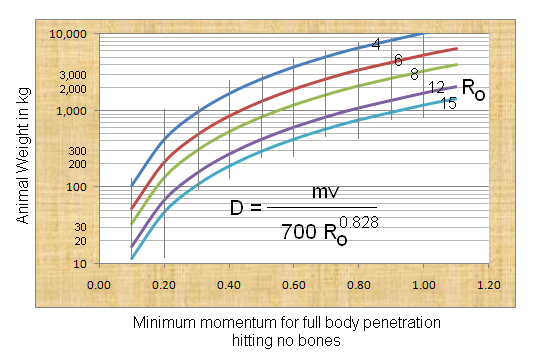 In this graph we have for different resistance values, the approximate momentum
In this graph we have for different resistance values, the approximate momentum
required for a full body penetration, not hitting any bones.
However, to add the required kinetic energy to break the rib on entry is not
that simple. You cannot simply add momentum to kinetic energy, and you cannot
derive the speed needed for each, and add the speeds. The problem with kinetic
energy is that the speed it corresponds to, is dependent on the speed itself...
a faster arrow will use less speed for the same amount of kinetic energy. So we
have to determine the speed the arrow will need for penetration, and then
calculate the speed to be added to this, so that the difference in speeds relate
to the energy needed to break the bone. Say for a 450gr arrow, you need 150fps
for penetration. Now we want to add 20 foot-pounds. For this the arrow has to
travel at 141fps. DO NOT ADD THESE!
Instead, add 1502 and 1412, and then get the square root, which equals 206fps.
However, to add energy needed to break the EXIT rib, you add the speeds without
this trick...
The astute observation here is that it takes much more speed difference to break
the exit rib than the entry rib...
|
3.1.7 Required Penetration Depth
| Here is a table that implements the WHOLE model...
This is for a kudu bull, at 250kg. Its body width is just under 16" and we
speculate it will take 20 foot-pounds to break his ribs. We want a pass
through... By the way, the pink shaded areas are where the kinetic energy is
less than suggested by the current "Bowhunting Norms and Standards" as defined
by the South African government.
"A" is the surface area of the broadhead, and the values inside the table are
fps. The first column is to get a pass through without touching a bone. The 2nd
column describes hitting a rib on entry, the 3rd hitting one on exit, and the
4th is for hitting both ribs. So you can see that for a 550gr arrow and a 11 lbs
broadhead, the predicted range of effective speeds are 187 to 280 fps,
corresponding to 42 to 95 foot-pounds.
Do you now realize why shot-placement is the most important factor affecting the
result of a hunt? And here we are not talking about intended shot placement (as
where you aimed), but actual shot placement (as where the arrow struck).
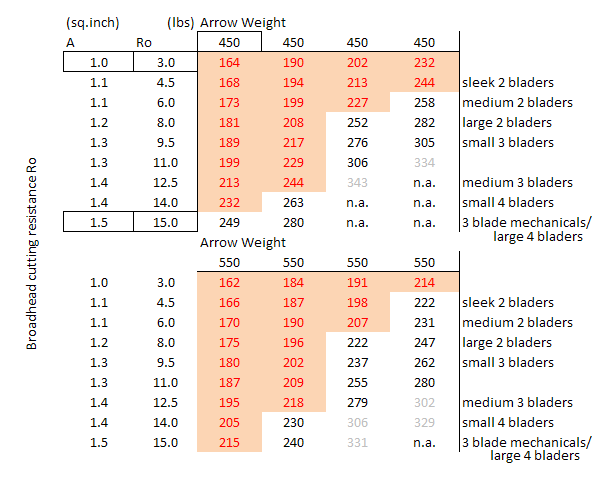 Imagine you were satisfied to hunt with the suggested minimum requirements - 187
Imagine you were satisfied to hunt with the suggested minimum requirements - 187
fps. The model predicts that if you do hit a rib on entry, you only have 7.1" of
penetration left. This will be sufficient to kill the kudu, but only if you shot
it perfectly square. If it was 30 degrees quartering away, you would have needed
9.1" penetration to traverse half the body. 7" may result in a loooong walk...
|
 This illustrates the danger of "hunting on the edge". Following minimum recommendations as per category #3, of 550gr at 187 fps, you should achieve 7" with a full quartering shot, breaking one rib on entry. However, at a 45 degree angle, quartering away, ignoring the fact that breaking the rib at this angle takes more energy, you only achieve 77% of the required penetration. Changing the broadhead from a 11 lbs to a 8 lbs broadhead, you can push it back to 100%.
This illustrates the danger of "hunting on the edge". Following minimum recommendations as per category #3, of 550gr at 187 fps, you should achieve 7" with a full quartering shot, breaking one rib on entry. However, at a 45 degree angle, quartering away, ignoring the fact that breaking the rib at this angle takes more energy, you only achieve 77% of the required penetration. Changing the broadhead from a 11 lbs to a 8 lbs broadhead, you can push it back to 100%.
| When discussing the particular categories of animals later on, we will draw
similar tables for each category, with its recommended arrow weights.
|
Further Reading: Herman Brand, AB&A, Mar 2007, p30, "Die pyl in pyl en boog"
Seppie Celliers, AB&A, Dec 2007, p56, "Pyle maak 'n groot verskil"
3.2 Bow Efficiency
| Bow efficiency is the ratio of the arrow's kinetic energy, to the energy used to
pull the bow. To determine the energy used to pull the bow, you need a
bow-scale. With this you can draw what's called the draw-force curve. It is
basically how hard you need to draw the bow, at each particular point in the
draw. So what you do is to measure the draw force for the bow at every inch as
you draw it. The sum of all these measurements is the draw energy in
inch-pounds, which when divided with 12, gives foot-pounds.
There is a difference in the draw force when you pull the arrow back, and let it
down slowly. This is called hysteresis, and can be summed up as friction due to
movement and internal friction (resistance to bending). It is always slightly
less when you let it down than when you draw the bow. But we are not going to
worry about this too much.
Some of the energy stored in the bow is also lost to sound, vibrations and heat.
The efficiency of the bow is usually between 60 and 80%.
To measure the arrow's kinetic energy, you need a scale which can weigh in
grains, and some way to measure the arrow's speed. A chronograph comes to mind,
but there are other ways as well - to be discussed later. For now, we assume you
measure the arrow's speed using a chronograph.
The kinetic energy can then be calculated with the arrow's weight and speed: KE
= weight x speed2 / 450240. I assume you measure the arrow's weight in grains,
and the arrow's speed in feet per second (fps). This formula gives you a value
of between 40 and 110 foot-pounds. The energy needed to pull a bow is usually
between 50 and 180 foot-pounds.
However, the exact percentage of the energy that ends up as kinetic energy of
the arrow is not a constant value for a particular bow. The efficiency is
dependent on the weight of the arrow, and sadly is also not directly
proportional to this weight. Therefore the simplest model, as single percentage
at "IBO standards" (350 gr shot at 70 pounds draw weight, 30" draw length) is
informative, but not conclusive.
A better model is the so called virtual mass model. This postulates that the
loss of energy can be modeled as an additional imaginative weight that can be
added to the arrow. The total energy used to draw the bow, and the arrow's speed
and weight, can then with the equation be used to calculate the virtual mass of
the bow. This value is independent of the arrow mass, and becomes a better
indicator of bow efficiency: Total Energy = (arrow weight + virtual weight) x
arrow speed2/ 450240.
You can of course omit to measure the total energy. The equation then contains
two unknowns, which can be solved using two arrows of different weight. But
luckily you don't need to do the maths, you can use the tools in the spreadsheet
to do this. This model works well over a range of arrow weights, but also has
its limits. The virtual model predicts that as you increase the arrow weight,
the arrow's kinetic energy will always increase, reaching a limit close to the
total draw energy. This is a better fit for traditional bows and recurves, but
with compounds there is a definite optimum arrow weight, beyond which its
kinetic energy decreases as arrow weight increases. A better energy model for
compound bows looks like this:
Draw energy = (arrow weight + virtual mass + K(arrow weight)3 ) x arrow speed2 /
450240
It looks the same as the virtual mass model, but includes an additional factor
that starts to suck up energy only for arrows weighting more than about 600gr.
Again, you don't need to do the maths - there is a tool with which you can
calculate the values for the virtual mass and K, for a particular bow, for three
different weighing arrows.
By the way, the virtual mass in this model is not comparable to that in the
virtual mass model for longbows and recurves...
But, now we have two numbers with which to compare bows with each other. Which
is generally a problem for us mere bow-hunters. Just have a look at the mental
resistance to drop either KE or momentum as penetration indicator for arrows, in
favour for weight and speed (two values). The more values you use, the more
accurate your representation of the real bow becomes, but the more difficult it
is to comprehend the difference.
We can easily comprehend that a virtual mass of 70gr is better than 90gr, but
what would be the best if for virtual mass bow A is better then B, but for the
value of K, B is better? Luckily for the efficiency model, virtual mass is
applicable to lighter arrows, and K for heavier ones. So if you want to shoot
competitions with light arrows (to achieve a flatter trajectory) small values of
virtual mass should be important. If you want to hunt with fairly heavy arrows,
800 to 1000gr, a smaller value for K would be more important. But this answer is
still a bit fluffy. Here is a typical graph of how speed, kinetic energy and
momentum changes with an increase in arrow weight for a particular bow:
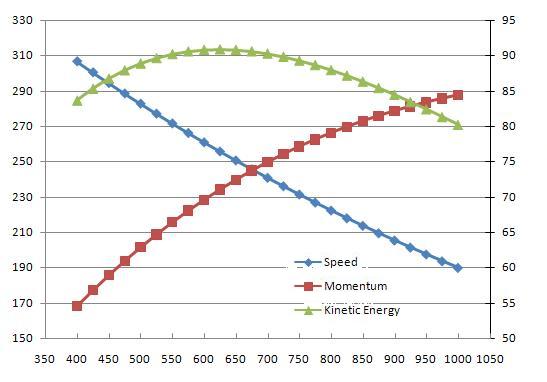 The best way in which to compare bows in relation to efficiency, using this last
The best way in which to compare bows in relation to efficiency, using this last
equation, is to calculate the speed that the bows would shoot the particular
arrow you plan to hunt with. The bow which attain the highest speed would of
course be the most efficient. By the way, I am assuming these bows are all of
the same poundage, and draw length.
Also bear in mind that cam-design will have a influence of efficiency. You may
end up calculating that bow A is more efficient than B, but B draws and shoots
more accurately than A! And the first principle of bowhunting is accuracy, not
penetration!
|
Further Reading: Harry Marx, AB&A, Nov 2008, p30, "Comparing Bows with bows: virtual mass"
Herman Brand, AB&A, Nov 2006, pi, "Beste Boog?"
Dieter Noli, AB&A, Nov 2006, p59, "Bow evaluation methods"
Rean Steenkamp, AB&A, Jun 2006, p43, "Who says a longbow isn't good enough?"
3.3 Bleeding and Penetration
| There is often a discussion on if serrated or smooth honing of the edge works
best. The general experience pulled upon here is that knifes with serrated edges
usually cuts meat and sinew easier than smooth blades. Sharp serrated edges are
easier to make, and in theory keeps longer than a smooth edge as only the
protruding parts blunt against bone. These arguments do not hold water too well
for hunting points. A hunting point should be used only once, and sharpened
thereafter.
(Oh, and very definitely cleaned and sterilized before you sharpen it, and
thereafter. Most often it passed through the animal and landed in the dirt.
There are very scary things in dirt, and you can end up with an inconvenient
cut, or a very serious infection. Likewise, if you wound an animal, there is a
chance that it will heal if you do not find it. If the wound infects, the animal
is doomed to a slow and painful death.)
 The serrations on such a blade do allow it to cut/tear slightly faster through
The serrations on such a blade do allow it to cut/tear slightly faster through
tough sinews etc., however in the process the amount of cellular damage is more
than with smooth blades. It may cut quicker, but the resistance against being
cut is so much the greater. It's like when you saw wood - the bigger the teeth
on the saw, the more resistance it experiences.
|
 Broadheads should be very sharp to cut with the least possible cellular damage, else more clotting factors are released. Clotting factors will slow down the bleeding, and increase the distance the animal will run before becoming unconscious. This damage also releases a whole enzymatic cascade that causes blood clotting to initiate. Since the idea of the hunting point is to cause the animal to bleed to death, you don't want clotting.
An animal needs to lose about 30% of its blood before it expires. This can be as bleeding "out" - leaving a blood spoor, or internally, leaving no spoor. However if a large artery is severed, this can occur within 10 to 15 seconds. Damage to an artery causes it to contract, or constrict. This slows down the bleeding and can help clotting. The less damage, as with smooth blades, the less this constriction.
Broadheads should be very sharp to cut with the least possible cellular damage, else more clotting factors are released. Clotting factors will slow down the bleeding, and increase the distance the animal will run before becoming unconscious. This damage also releases a whole enzymatic cascade that causes blood clotting to initiate. Since the idea of the hunting point is to cause the animal to bleed to death, you don't want clotting.
An animal needs to lose about 30% of its blood before it expires. This can be as bleeding "out" - leaving a blood spoor, or internally, leaving no spoor. However if a large artery is severed, this can occur within 10 to 15 seconds. Damage to an artery causes it to contract, or constrict. This slows down the bleeding and can help clotting. The less damage, as with smooth blades, the less this constriction.
| As bleeding rate is sometimes likened to the result of the surface area of the
cut, it would seem logical to use as many as possible blades. However, it is not
flesh that bleeds, but arteries. And no matter how many times you cut an artery,
it bleeds just as fast as if it was cut once. So arguments and opinions abound -
we will look at the facts.
If you draw a circle with the same diameter as the broadhead's cutting diameter,
and in it the cuts made by the broadhead, you can easily see that with 2 bladed
broadheads, you can draw many lines representing arteries through the circle
that does not get cut. When you do this with a 3 bladed broadhead, the chance of
an artery being cut by any blade drastically increases.
Or so it seems - we still have to figure in the penetration depth...
For a four bladed broadhead, the probability of cutting an artery in this circle
increases even more. But what also increases drastically now is the probability
of cutting the same artery twice. This does not add to the rate of bleeding, but
definitely uses up more penetration ability. When increasing the number of
blades, this higher friction decreases the depth of penetration.
So although bleeding is proportional to total cutting area, this cutting area,
if derived from multiple blades rather than cutting diameter, may not be as
effective.
|
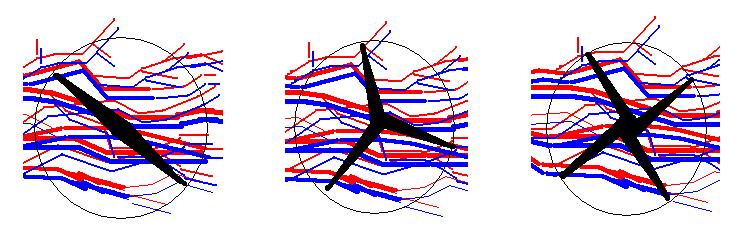
| Now if you are interested in mathematical proof, you can read the next
paragraph, else you can skip it to a very surprising conclusion...
|
| Assume broadheads with a cutting diameter of 1".
The probability of an artery being cut is equal to the average height
(the integration of the height of the top most blade above the arrow
on being turned 360 degrees) divided with the total cutting radius.
For a two bladed broadhead this average cutting diameter (ACD) is
about 63%, for three blades 83%, and 4 blades 90%. As you can see
there is about a 32% increase going from 2 to 3 blades, and about an
8% increase going from 3 to 4 blades. But don't get excited yet.
If we only look at cutting energy, and ignore friction, and use that
to predict penetration, and if 2 blades penetrate 20 inches, then
three blades will penetrate 20*2/3=13.3" and 4 blades 20*2/4=10".
The ACD is however 0.63, 0.83 and 0.90 inches, which means that the
average cutting area (ACA) is 12.6", 11" and 9". Whow, this ACA
actually decreased! Furthermore any surface friction for 4 blades
passing through the animal, can only be more than that for 3 blades,
which is again more than that for 2 blades. Therefore 4 blades must
have a smaller ACA than 3 blades, which have an ACA than 2 blades! Now
also add to that the bigger chance of 4 blades cutting arteries twice,
and not increasing bleeding, the picture is very dim for 4 blades.
We can now add friction and see its influence as well. We start off
with a field point that penetrates 20".
For these calculations we define a new energy unit called ips, which
are inches of penetration. This means the field point had 20ips. Then
we shoot a 2 blader with a round nosed chisel point, and see it
penetrates 15". This is just a fieldpoint with two blades added well
back of the tip. This would imply, that since both arrows had the same
amount of energy to start off with, that (20-15)/20 = 25% of the
energy, 5ips, now went into the cutting, leaving 75% for penetration,
15 ips.
It means that each cutting blade used 12.5%, or 2.5 ips, to cut 15"
deep, and the arrow used 15 ips to penetrate 15".
We can write an equation for this:
D x 2.5/15 + D x 2.5/15 + D x 15/15 = 20", where D is the depth
of penetration, which is 15".
If we add a third blade, that 3rd blade will also use 2.5ips to cut
15" deep, but we don't know how deep it will go now. That is what we
want to calculate:
D x 2.5/15 + D x 2.5/15 + D x 2.5/15 + D x 15/15 = 20, and now D
is 13.3".
For 4 blades the penetration depth would be:
4 x [ D x 2.5/15 ] + D x 15/15 = 20, 12".
The ACA's are now 9.45sq", 11sq", and 10.8sq". Now the 3 blader is the
most lethal.
The general equation would be
D = D0 / [B (D0-D2)/2D2 + 1], where D0 is the field point
penetration, and D2 is the 2 blader's.
With this we can investigate a whole spectrum of possibilities:
D0 20"
D2 (penetration) ACA (average cutting area)
inches square inches
2x 3x 4x 2x 3x 4x
10 8.0 6.7 6.3 6.6 6.0
11 9.0 7.6 6.9 7.5 6.8
12 10.0 8.6 7.6 8.3 7.7
13 11.1 9.6 8.2 9.2 8.7
14 12.2 10.8 8.8 10.1 9.7
15 13.3 12.0 9.5 11.1 10.8
16 14.5 13.3 10.1 12.1 12.0
17 15.8 14.8 10.7 13.1 13.3
18 17.1 16.4 11.3 14.2 14.7
19 18.5 18.1 12.0 15.4 16.3
In this table we can see that for example in row 3, if a field point
penetrates 20", and a 2 blader 12", then a 3 blader will penetrate
10", and 4x only 8.6". Their cutting areas will be 7.6sq", 8.3sq", and
7.7sq".
From this we can also see that only if the 2 blader penetrated to
deeper than 80% of the field point, does it make sense to use a 4
blader. At all other set-ups, a 3 blader causes the most bleeding.
|
 Which emphatically proves that 3 bladed broadheads are better than 2 or 4 bladed ones where lethality is concerned, unless penetration is needed, for which 2 bladers are better, and unless you get pass through's, in which case 4 bladers are better.
Which emphatically proves that 3 bladed broadheads are better than 2 or 4 bladed ones where lethality is concerned, unless penetration is needed, for which 2 bladers are better, and unless you get pass through's, in which case 4 bladers are better.
 If you do get pass-through's, the best broadhead is always the one that cuts the largest cutting surface (blade count x cutting diameter), and just falls out of the animal at the other side. If you frequently get pass-through's, you can consider going bigger with the broadhead.
Which is basically common sense isn't it?
If you do get pass-through's, the best broadhead is always the one that cuts the largest cutting surface (blade count x cutting diameter), and just falls out of the animal at the other side. If you frequently get pass-through's, you can consider going bigger with the broadhead.
Which is basically common sense isn't it?
 Now before we step of this topic, there is another interesting opinion about bleeding to take note of. Internal bleeding is good, but external bleeding even better - it leaves a nice trail to follow. If you cut a straight cut through hide, and stretch it, you will notice that you can actually "pinch" it close if you pull in the direction of the cut. Three and four bladed broadheads cut a pattern that cannot pinch close. Therefore some 2 bladers have an extra 2 small blades. These are called bleeder blades, and their sole purpose is to ensure that you still have the penetration of 2 blades, while the cut cannot be pulled close.
Further Reading: Herman Brand, AB&A, May 2007, p32, "Minder Bloed"
Now before we step of this topic, there is another interesting opinion about bleeding to take note of. Internal bleeding is good, but external bleeding even better - it leaves a nice trail to follow. If you cut a straight cut through hide, and stretch it, you will notice that you can actually "pinch" it close if you pull in the direction of the cut. Three and four bladed broadheads cut a pattern that cannot pinch close. Therefore some 2 bladers have an extra 2 small blades. These are called bleeder blades, and their sole purpose is to ensure that you still have the penetration of 2 blades, while the cut cannot be pulled close.
Further Reading: Herman Brand, AB&A, May 2007, p32, "Minder Bloed"
3.4 Shooting Distances
3.4.1 ...based on Reaction Time
| In the past speed was one of the most important factors of a bow as promoted by
industry. This of course makes sense if you are selling bows. The IBO standard
(being misused as it is) set a constant arrow weight, and allows the buyer to
make a rudimentary/superficial comparison between bows. More importantly, it
allowed manufactures to advertise "mine’s bigger than yours". The standard could
have been defined differently - what is the heaviest arrow the bow will shoot at
200 fps? This (although totally impractical) would have instead led to a weight
race...
So everybody (and in USA still) came to believe speed was most important. It
helped of course that kinetic energy is more dependent on speed than weight, as
opposed to momentum. This tendency we think, has however been reversed in South
Africa. Dr. Ashby and others has shown that momentum plays a bigger role in
penetration into flesh. This led to the extreme emphasis shifting from speed to
arrow weight as the all important factor, encouraged by among others the author.
As we fight against using extreme speed to compensate for low arrow weight, we
fight against the use of extreme arrow weight to compensate for low speed. This
tendency has long since been seen in the traditional-bow environment, where
extreme heavy arrows were used to get enough penetration despite low speeds. But
it comes at a price. This price is the theme of this chapter.
|
 It is often asked what the minimum speed of a hunting arrow should be. There are two principles you can follow to answer this, and speed’s contribution to penetration is discussed elsewhere. Instead, these two factors are accuracy, and reaction time. We will first look at accuracy, then reaction time, and then go some way to define a sensible balance between speed and weight.
The issue about accuracy is as follows - even if you ranged the animal with a rangefinder, it may step closer or further just one or two steps, and change the impact point. This is exactly the same as using for example the 40Y pin for an animal ranged at 39Y. But the influence can’t be by much, we hear you protest.
It is often asked what the minimum speed of a hunting arrow should be. There are two principles you can follow to answer this, and speed’s contribution to penetration is discussed elsewhere. Instead, these two factors are accuracy, and reaction time. We will first look at accuracy, then reaction time, and then go some way to define a sensible balance between speed and weight.
The issue about accuracy is as follows - even if you ranged the animal with a rangefinder, it may step closer or further just one or two steps, and change the impact point. This is exactly the same as using for example the 40Y pin for an animal ranged at 39Y. But the influence can’t be by much, we hear you protest.
| Shooting high (+) and low(-), for animals at various distances, for different
arrow speeds, that comes closer 1Y after ranging, for elevations relative to
anchor point +1 to -5Y.
50Y 40Y 30Y 20Y 10Y
150 4.0 to 3.1 3.4 to 2.9 2.6 to 1.9 1.8 to 0.9 1.1 to 0.0
175 3.1 to 2.7 2.5 to 2.0 1.9 to 1.3 1.4 to 0.4 0.9 to -0.3
200 2.4 to 2.0 1.9 to 1.4 1.5 to 0.8 1.1 to 0.2 0.8 to -0.4
225 1.9 to 1.5 1.6 to 1.0 1.2 to 0.5 0.9 to 0.0 0.7 to -0.5
250 1.6 to 1.1 1.3 to 0.8 1.0 to 0.3 0.8 to -0.2 0.6 to -0.6
275 1.3 to 0.9 1.1 to 0.6 0.9 to 0.2 0.7 to -0.3 0.6 to -0.7
300 1.1 to 0.7 0.9 to 0.4 0.7 to 0.1 0.6 to -0.4 0.6 to -0.7
|
 In this table we can see the error caused by the ranged animal stepping closer to you, by a mere 1Y. This error was calculated using a parabolic trajectory, and therefore assumes no speed loss (speed loss increases the error slightly more). The values are all in inches.
This table shows us that for example shooting with a 200fps arrow: you will shoot just more than 2" high if the animal moves from 50Y to 49Y. What it also shows is if you want to half this error, you need to increase the arrow speed to at least 250fps, or decrease your hunting distances to 30Y.
Also, a very interesting phenomenon is that when shooting from a tree hide (5Y high), at 250fps instead of shooting high at 20Y, you shoot slightly low! This is seen for 10Y for all the speeds. It of course has to do with the form of the trajectory, and that 1Y is a bigger percentage of 10 than 50. On average, the error always decreases with an increase of speed.
So on face value, it is very intuitive to claim that higher speeds are the solution to ranging problems, but shooting at closer distances can decrease the error too. If you are having problems with vertical accuracy, speed will decrease the error, but accurate ranging will eliminate it.
In this table we can see the error caused by the ranged animal stepping closer to you, by a mere 1Y. This error was calculated using a parabolic trajectory, and therefore assumes no speed loss (speed loss increases the error slightly more). The values are all in inches.
This table shows us that for example shooting with a 200fps arrow: you will shoot just more than 2" high if the animal moves from 50Y to 49Y. What it also shows is if you want to half this error, you need to increase the arrow speed to at least 250fps, or decrease your hunting distances to 30Y.
Also, a very interesting phenomenon is that when shooting from a tree hide (5Y high), at 250fps instead of shooting high at 20Y, you shoot slightly low! This is seen for 10Y for all the speeds. It of course has to do with the form of the trajectory, and that 1Y is a bigger percentage of 10 than 50. On average, the error always decreases with an increase of speed.
So on face value, it is very intuitive to claim that higher speeds are the solution to ranging problems, but shooting at closer distances can decrease the error too. If you are having problems with vertical accuracy, speed will decrease the error, but accurate ranging will eliminate it.
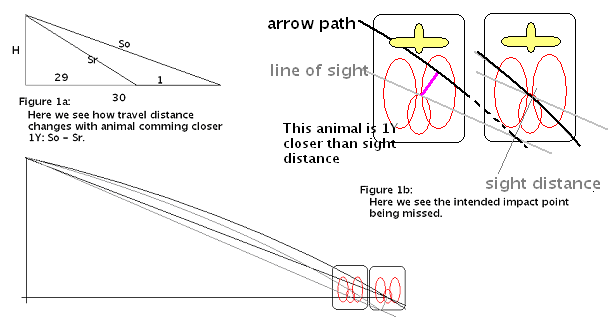
| If you take a video recording of an animal being shot with a standard video
camera, the frames or still photos it takes, is about 25 per second. This means
the frames are 0.04 seconds (40 milliseconds) apart from each other.
You can therefore, based on in which frame they react, determine the time it
took for them to start jumping. If you look at the "Impact" video by DP Bierman
and Redge Grant, they reflect on a number of experiments doing exactly this.
What they found was that very alert impala can react within 2 frames of the shot
being fired (80ms). At the same time, a very relaxed animal, surrounded by other
animals and guinea fowl, did not react even on frame 5 when the arrow hit.
|
 This implies reaction times that can start at just below 0.1 seconds (100 milliseconds), but can also be as slow as 200 milliseconds.
This implies reaction times that can start at just below 0.1 seconds (100 milliseconds), but can also be as slow as 200 milliseconds.
| If you shoot at an impala at 20Y, with an arrow at 250 fps, the animal has 187
milliseconds to react between the sound reaching it, and the arrow doing so. If
you wish to reach the animal before 100 milliseconds, you will have to shoot at
395fps.
|
 Moral of this story - if you want to decrease the probability of the animal jumping, by increasing arrow speed, you will only be partially successful. There are a few other ways of also decreasing "string jump", for example shooting heavier arrows that decreases energy loss and lowers sound frequencies and amplitude, or putting on sound dampeners, or standing a bit deeper in the hide, waiting for the animals to calm down, etc...
Moral of this story - if you want to decrease the probability of the animal jumping, by increasing arrow speed, you will only be partially successful. There are a few other ways of also decreasing "string jump", for example shooting heavier arrows that decreases energy loss and lowers sound frequencies and amplitude, or putting on sound dampeners, or standing a bit deeper in the hide, waiting for the animals to calm down, etc...
| Here we see the time (milliseconds) between the sound and arrow reaching the
target, the distance the animal can "fall" during string jumping (reacting only
after 100ms), and the speed at which it would be falling by this time. Clearly
you can see the need for 275+ fps at 30Y and 200+ fps at 20Y, to minimize string
jumping.
Time (milliseconds) Distance (inches) Speed (fps)
50 40 30 20 10 50 40 30 20 10 50 40 30 20 10
150 868 694 521 347 174 114 68 34 12 1 25 19 14 8 3
175 725 580 435 290 145 75 44 22 7 0 20 15 11 6 2
200 618 494 371 247 124 52 30 14 4 0 18 13 7 5 1
225 535 428 321 214 107 37 21 9 3 0 14 10 7 4 0
250 468 374 281 187 94 26 15 6 2 0 12 9 6 3 0
275 413 331 248 165 83 19 10 4 1 0 10 7 5 2 0
300 368 294 221 147 74 14 7 3 0 0 9 6 4 3 0
|
 What is even more effective, as proven in this video, to decrease string jumping, is to wait for the animal to relax or shooting only when they are calm. Birds and other animals causing some natural noise are also very beneficial.
What is even more effective, as proven in this video, to decrease string jumping, is to wait for the animal to relax or shooting only when they are calm. Birds and other animals causing some natural noise are also very beneficial.
 Therefore, we could conclude that speed does flatten the trajectory slightly, and does decrease the probability and extend of string jumping, but never believe that speed will solve these problems. Instead, a concerted approach, where also other techniques and factors are used, is most successful.
Shooting at shorter distances always decreases your grouping size. This alone should be a big reason to do so. It also decreases reaction time for the animal drastically. From these tables you can see the linear relationship between distance and reaction time. Going from 40 to 20 yards (very do-able), to get the same decrease using speed, you will have to double the arrows speed (almost impossible).
Therefore, we could conclude that speed does flatten the trajectory slightly, and does decrease the probability and extend of string jumping, but never believe that speed will solve these problems. Instead, a concerted approach, where also other techniques and factors are used, is most successful.
Shooting at shorter distances always decreases your grouping size. This alone should be a big reason to do so. It also decreases reaction time for the animal drastically. From these tables you can see the linear relationship between distance and reaction time. Going from 40 to 20 yards (very do-able), to get the same decrease using speed, you will have to double the arrows speed (almost impossible).
| Another ground for differentiating between for example a spear and an arrow, is
the speed of the projectile. The influence of the speed of the projectile on
accuracy will be discussed in the following paragraphs. Its influence on
penetration is however also critical for a totally different reason than
momentum. It ties in with FOC as discussed above.
|
 A faster projectile gives the animal a shorter time to react to the sound of the projectile (or for any other reason).
A faster projectile gives the animal a shorter time to react to the sound of the projectile (or for any other reason).
| The importance of a moving target on the penetration of a slow projectile is
easily imagined as the moving animal will cause the projectile to slant during
impact. This will decrease penetration in exactly the same way as an imperfect
trajectory due to a too low FOC. Again, we will only capture this effect as a
general guideline, since currently it does not seem sensible to try and quantify
it other than as arrow speed.
When discussing reaction time, the debate is usually centered on two opposing
facts: (a) the further you are from the target, the more time the animal has to
react, and (b) the further you are, the less noise reaches the animal. (Another
factor that also affects the noise that reaches the animal is the density of the
bush, vs. over water). Accuracy decrease proportional to distance, time to react
increases proportion, but the level of sound decreases by the square of the
distance. At each distance, you make the call and take the risk.
Traditional archers have for many years proven that slow, heavy arrows are also
very effective hunting projectiles. We have also seen very low poundage bows
used by children, and medium power bows by women, to hunt very successfully.
Indeed it would be a sad day if proposed recommendations exclude traditional
bows, children and women from bow-hunting. What we have discussed so far in fact
does make provision for these hunters. The first factor described as essential
to bow hunting is accuracy.
|
 Accuracy is increased for all hunters by merely shooting at shorter distances. The reason for suggested optimum mass and speed being high in general is to compensate for a slightly less than perfectly placed shot. In realizing the constraints these hunters function in, we can see that by reducing the maximum suggested range, we in turn reduce the probability of the animal moving, increase the target size, and therefore increase the probability of perfect shot placement. In combination with shorter hunting distances, the use of 2 bladed hunting points with minimum cutting diameters ensures achieving needed PA.
Accuracy is increased for all hunters by merely shooting at shorter distances. The reason for suggested optimum mass and speed being high in general is to compensate for a slightly less than perfectly placed shot. In realizing the constraints these hunters function in, we can see that by reducing the maximum suggested range, we in turn reduce the probability of the animal moving, increase the target size, and therefore increase the probability of perfect shot placement. In combination with shorter hunting distances, the use of 2 bladed hunting points with minimum cutting diameters ensures achieving needed PA.
| In turn, defining suggested maximum ranges for all categories of bowhunters is
also of ethical importance. This ties in perfectly with accuracy as discussed
above. The temptation is all too great for trying to suggest a measurement of an
archer's accuracy, and therewith provide suggested maximum hunting distances.
The reality is however that even if a hunter could accurately hit the target
animal's vitals at 80Y, the time for the arrow to reach the animal will be
relatively long, and thereby its movement during this time ("string jump") will
negate all the care that went into the perfect shot placement. It is generally
accepted by bowhunters that about 20Y is the maximum range for Category #1
animals (and definitely for warthogs as well) at arrow speeds of about 250fps.
Larger animals are generally slower to move, and 30Y is quite acceptable for the
large antelopes. For Giraffe and buffalo, 40Y is not unrealistic. The maximum
suggested hunting distance is not a function of the hunter's accuracy, but
indeed of the animal's reaction time (and size of vital organs) vs. the speed of
the arrow. |
 At the generally accepted arrow velocity of 250fps, animals at 20Y have about 0.2 seconds to react to the sound and animals at 40Y about 0.4 seconds.
At the generally accepted arrow velocity of 250fps, animals at 20Y have about 0.2 seconds to react to the sound and animals at 40Y about 0.4 seconds.
| If the arrow mass is 800gr, arrow speed is 188fps, and Ro is 8 lbs, the
penetration is around 40 inches. According to the optimum recommendations on
mass and velocity, this would qualify as a perfectly acceptable hunting arrow
for all categories. In reality this velocity would provide the animals 0.280 and
0.580 seconds at 20 and 40 yards to react. This is in regards to reaction time,
as (un)acceptable as shooting a 250fps arrow at an animal at 60+ Y. Therefore,
the suggested decrease in maximum hunting range of arrows that does meet the
optimum speed recommendation with the adjusted speed, but in reality is slower,
is suggested in line with a reaction time of 0.2 to 0.4 seconds.
Another factor plays a role in defining maximum distances. Arrows loose speed
due to friction in air, roughly at about 1% per 10Y. An arrow at release may
have 40 ft.lbs energy but at 60Y it may only have 35 ft.lbs (for 570gr at
195fps). Arrows shot to an elevated target looses speed more quickly in relation
to the angle. Arrows shot to a downhill target looses speed much slower again.
However, when staying within the recommended speeds, this effect is overshadowed
by accuracy and reaction time compensations.
Proposed Maximum Yardage based on Reaction Time
Category #1 #2 #3 #4+
Reaction Time
(seconds) 0.15 0.2 0.25 0.3 0.4
Arrow Speed Recommended Maximum Distance (yards)
150 9 12 15 17 23
175 10 14 17 21 28
200 12 16 20 25 33
225 14 19 24 28 38
250 16 22 27 33 43
275 18 25 31 37 49
300 21 28 35 41 55
Based on the assumption that the animal is calm, using the formula:
Distance = Time x arrow speed x speed of sound / (speed of sound - arrow speed)
If the animal is nervous, use the lower category's time. |
3.4.2 ...based on Grouping size
| "Effective range is the ability to place 80% of your arrows in an 8"circle (20
cm)." - Cleve Cheney.
The above rule, which is quite sensible, is a very general guide, and does not
make provision for the massive differences in sizes of African animals. This
writing allows for a range of 4" to 8" circles, for various categories of
animals. The term maximum range is to a degree more rigid than effective or
optimum, however we would like to stress the importance of this concept to the
hunter. It is something which should not be compromised upon.

|
 The Vitals’ Area Diameter (VAD) is defined as the diameter of the largest circle that fits inside the shot window to the vital organs (heart and lungs) that miss all the major bones.
The Vitals’ Area Diameter (VAD) is defined as the diameter of the largest circle that fits inside the shot window to the vital organs (heart and lungs) that miss all the major bones.
| The proposed maximum yardage based on accuracy is done in relation to the basic
unit of a grouping size - its diameter. A grouping with circumference of 10"
(measured as suggested later on), has a diameter of 3.3", and when shot at 50Y,
an angle of 0.066"/Y. It implies on for example category #1 animals a shot at
the furthest of 4"/0.066Y, which is 60Y. Building a safety factor into it with
double the grouping size this distance becomes 30Y. Here is a table with some
values:
Category #1 #2 #3 #4 #5 #6
Average vital dia 4" 5" 6" 6" 7" 8"
Circumference "/Y Recommended Max Distance* (Y)
24" 0.160 13 16 19 19 22 25`
22" 0.147 14 17 20 20 24 27
20" 0.133 15 19 23 23 26 30
18" 0.120 17 21 25 25 29 33
16" 0.107 19 23 28 28 33 38
14" 0.093 21 27 32 32 38 43
12" 0.080 25 31 38 38 44 50
10" 0.066 30 38 45 45 53** 60
8" 0.053 38 47 56 56 66 75
* safety factor=2
** shots at 50Y and beyond are generally not recommended.
The proposed method for measuring group size is to measure the circumference of
the smallest polygon that covers 6 shots, i.e. shoot 6 shots and wrap a tape
measure around the shafts where they enter the butt. This value is then divided
with 3 (the mathematical constant PI is about 3) to approximate diameter, and
then with the distance tested at. For ex. 20" circumference at 50Y is
20/3/50"/Y, which gives a grouping of 0.133"/Y.
In order to calculate the distance proposed, use:
Vital Diameter / Grouping size / Safety Factor.
This safety factor is a matter of personal choice, and 1 to 2 is suggested. The
above table uses 2, which allows for an error that's double the hunter's
grouping size, and is considered very safe. A value of 1 leaves no margin for
error.
|
3.4.3 Measuring the correct hunting distance
 Here is a simple procedure to measure your hunting distance quickly.
Draw a picture, life size, of the kill zone for the animal you want to shoot.
Then draw the largest circle that fits into the kill zone.
Now stand at about a distance you would expect to shoot half the arrows inside the circle. Let us say this is 35Y.
Now shoot 35 arrows at it, as many as how far you are in yards from it.
Now count how many arrows are inside the kill zone.
The number of arrows inside the circle, is the maximum distance you should be hunting this animal at!
Further Reading: Cleve Cheney, AB, Mar/Apr 2001, p13, "Optimum Range - knowing when to shoot"
Here is a simple procedure to measure your hunting distance quickly.
Draw a picture, life size, of the kill zone for the animal you want to shoot.
Then draw the largest circle that fits into the kill zone.
Now stand at about a distance you would expect to shoot half the arrows inside the circle. Let us say this is 35Y.
Now shoot 35 arrows at it, as many as how far you are in yards from it.
Now count how many arrows are inside the kill zone.
The number of arrows inside the circle, is the maximum distance you should be hunting this animal at!
Further Reading: Cleve Cheney, AB, Mar/Apr 2001, p13, "Optimum Range - knowing when to shoot"
Cleve Cheney, AB&A, Jan 2008, p30, "Long shots - why not?"
Cleve Cheney & Jan Burger, AB&A, Jan 2007, p39, "Close shooting makes good sense"
Engee Potgieter, AB&A, Jul 2007, p52, "Rooibok - die snaarspringkoning"
Engee Potgieter, AB&A, Apr 2007, p25, "Bowhunting Bread and Butter"
3.5 Equipment
3.5.1 Traditional Bows
Further Reading: Johan Smit, AB&A, Sep 2006, p51, "Traditional bows - stronger than you may believe"
Johan Smit, AB&A, Nov 2006, pi, "Watter Traditionele toerusting is reg vir my?"
Johan Smit, AB&A, Jun 2006, pi, "Sorg vir jou Tradisionele Boog"
Johan Smit, AB&A, Mar 2007, p29, "Tradisionele boog en die spoedmite"
Johnny Snyman, AB, Nov/Dec 2000, p28, "Making a Flemish Splice Bowstring"
Johnny Snyman, AB, Jan/Feb 2001, p14, "Making a Flemish Splice Bowstring - Part 2"
3.5.2 Compound bows
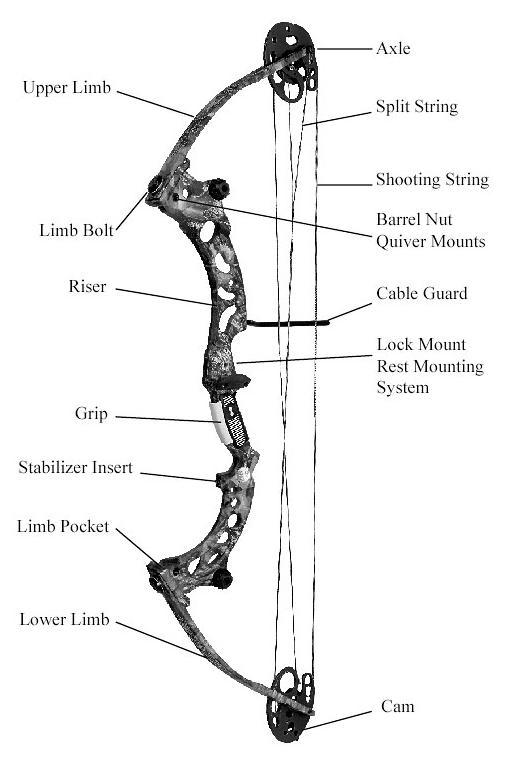 Further Reading: Seppie Celliers, AB&A, Oct 2007, p51, "Hoe kies ek 'n boog wat my pas?"
Further Reading: Seppie Celliers, AB&A, Oct 2007, p51, "Hoe kies ek 'n boog wat my pas?"
Herman Brand, AB&A, Nov 2007, p52, "Feite en Opinies"
3.5.3 Arrow Rests
| The very first arrow rest, still in use, is the shelf, or riser of the bow, and
against the hand. This works perfectly if your arrows are tuned for the type of
rest. The arrow vibrates during release at a particular frequency. When the
arrow is released, the string pushes it against the riser, and bends it. This
bend initiates a vibration that takes the flights of the arrow out of the way of
the riser. Of course, if the arrow vibrates at the wrong frequency, the flights
do not clear, and makes contact with the rest. This can cause inconsistent
groupings. This is the very reason traditional archers uses feathers for
fletching. Feathers are also less rough on the hand.
The next step in the evolution of the rest involved a fixed shelf and "button".
Like the riser itself, these do not give way when the arrow pushes against it.
The same tuning of the arrow is needed to get the flights to clear.
Popular on recurves are spring rests and "plunder buttons". These support the
arrow during aiming, but can be pushed away by the arrow as it bends. An aspect
not frequently discussed is the damping of vibrations in the arrow by the touch
of the rest.
Also very popular, more so on compound bows, is two prongs. The flights of the
arrow, or the nock, must be fixed such that one flight passes between these
prongs. They are usually also micro-adjustable for center-shot (adjusting the
rest left or right), to minimize fishtailing. The height of the rest in turns
control "porpoising", or the arrow moving up and down.
Do take note that all arrows shot from traditional bows will fishtail. Arrows
shot from compounds, especially those with single cams, tend to porpoise or
vibrate vertical. This is of course due to the nock travel of these bows not
being straight. Read more on this under Dynamic Spine.
All these rests have one undesirable feature, if you nock the arrow and try to
stalk with it, it tends to fall of the rest. Also with compounds, if the cams
have a "hard wall", the arrow tends to bounce off the rest if you draw too fast
into this wall. One rest design in particular is well suited to eliminate this
problem, the wisker bisket. These have numerous strong fibers on which the arrow
rests, and which hold it "locked" on the rest. Some archers are convinced wisker
biskets are not as accurate as prong or spring rests, but then for hunting, your
shooting distance is fairly close. On the other hand, I have seen film footage
of shooting at 160Y with them, more accurate than I can with my drop-away rest.
All of these rests have two objections to them raised by some archers. The
arrow's fletches can make contact with the rest, and any movement of the bow
hand is transferred to the arrow during the whole release. I also fell for
these, and as such is using a drop-away rest. These rests hold the arrow up, but
during release, drops totally out of the way of the fletches. They also exert no
push against the arrow as it bends during release. Lastly they also only
transfer bow movement to the arrow for the first part of the release. However,
they don't contribute to damping vibrations - think of a tuning fork being
stuck, and touched, which immediately dampens high frequencies.
Drop away rests are mechanical devices, which as such needs cleaning and care,
and is not as robust as prongs.
More as a curiosity, there is also a magnetic rest. The arrow drifts in a
magnetic field, and experiences no friction during any part of the release. I
have never seen this in action, and is worried that the precise position of the
arrow tip will be affected by how it was nocked (think string torque). Also, if
you shoot uphill or downhill, the point will not drift at the same height. |
3.5.4 Hunting Points (Broadhead) design
Here's just a small sample of broadheads and variety
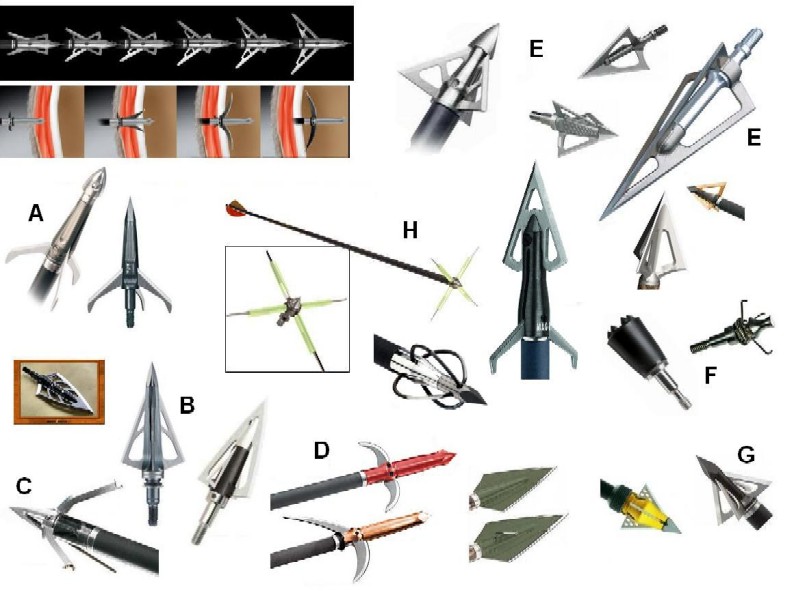 A - Standard mechanicals, opening backwards,
B - Two bladed broadheads with smaller "bleeder" blades,
C - Newer type of mechanical, blades opening forward on impact,
D - Mechanicals opening only once inside target,
E - Three bladed broadheads with short to long blade lengths,
F - Judo and Blunt, for use on birds, rodents etc.,
G - Four bladed broadheads,
Also shown is the sliding action of broadhead opening with blades sliding
backwards, and only opening once inside the target.
A - Standard mechanicals, opening backwards,
B - Two bladed broadheads with smaller "bleeder" blades,
C - Newer type of mechanical, blades opening forward on impact,
D - Mechanicals opening only once inside target,
E - Three bladed broadheads with short to long blade lengths,
F - Judo and Blunt, for use on birds, rodents etc.,
G - Four bladed broadheads,
Also shown is the sliding action of broadhead opening with blades sliding
backwards, and only opening once inside the target.
3.5.4.1 Mechanical Points
| There are currently 4 types of mechanicals, those that open backwards upon
penetrating the skin, those that open by sliding the blades backwards upon skin
penetration, opening forwards on contact, and those that open backwards but only
after penetrating the full depth of the hunting point's length. |
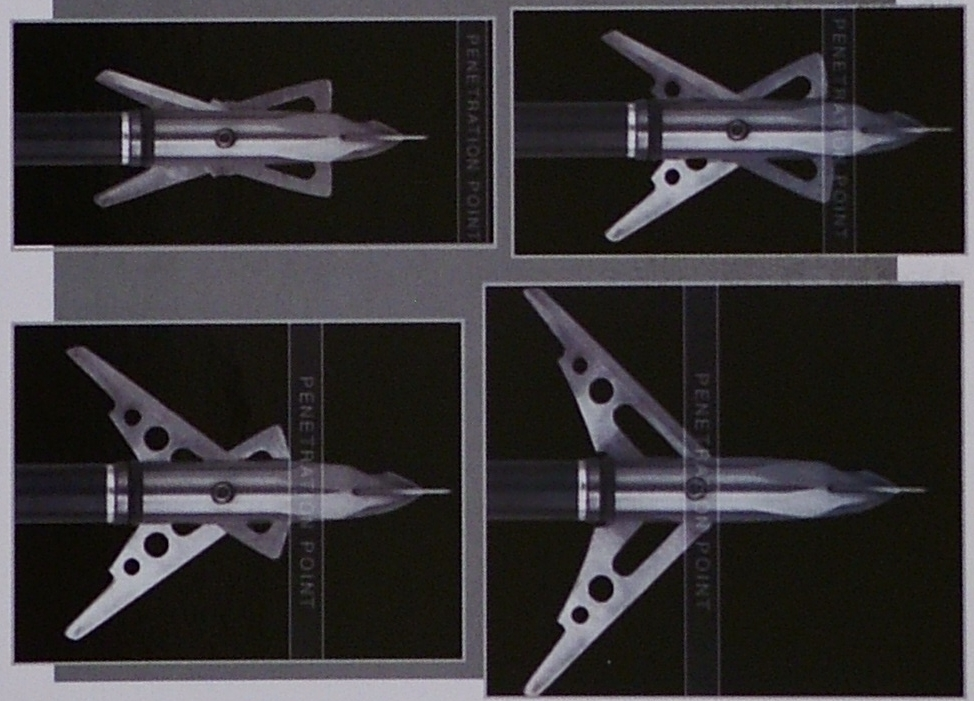
| The first type is the more generally used design, opening backwards. It
sometimes causes a small entry wound. It can also be deflected by the opening
blades pushing the point away.
This can happen in very oblique shots. The second and third designs with sliding
blades promise to open fully before penetration starts, and that no deflection
can occur. All three of these types suffer from less robust blade design, and
can break upon hitting heavy bone structure. Such breakage of course severely
hampers penetration.
The fourth type of mechanical hunting point tries to solve this breakage problem
by only opening once it has penetrated a substantial depth, the idea is to open
only once inside the rib-cage, and so avoid blade damage during entry. This in
turn however may reduce the bleeding rate, increasing the time needed for the
animal to go down, and possibly decreasing the blood trail due to the small
entry wound. The big advantage of mechanical hunting points is the ease with
which to tune the bow for them, once field point tuning was done. |
 In relation to mechanical hunting points we recommend that only category #1 and #2 animals be hunted. This is however based on the opinion that mechanicals are generally of a less robust design than fixed hunting points. Another factor to keep in mind with mechanicals is that in general the blade angle is larger than with fixed blade points, increasing the resistance to penetration. The big advantage of mechanical hunting points is the ease with which to tune the bow for them, once field point tuning was done.
In relation to mechanical hunting points we recommend that only category #1 and #2 animals be hunted. This is however based on the opinion that mechanicals are generally of a less robust design than fixed hunting points. Another factor to keep in mind with mechanicals is that in general the blade angle is larger than with fixed blade points, increasing the resistance to penetration. The big advantage of mechanical hunting points is the ease with which to tune the bow for them, once field point tuning was done.
3.5.5 Bow Sights and peeps
| If you are a traditional shooter, you can skip this section. I won't mind. If
you are not, a sight is a useful appendage. There are two major designs, a
multi-pin and a single-pin sight. Multi-pin sights are most popular, and has a
major advantage. The animal you are hunting will move closer and further, and
you will have to change the distance you aim at. With a multi-pin sight you need
not adjust any setting, and just shoot on another pin. The drawback it has, is
that if you are using really heavy arrows, the trajectory is rather pronounced,
and you want to aim at very close to the correct height. If you have set your
pins on 10 to 50Y, with 10Y intervals, you will have problems at other
distances. My advice to set the pins at 20,25,30,35 and 40Y. You should not hunt
at further distances anyway, and closer than 20Y the arrow is traveling fairly
straight. I shoot with a single pin sight. The reason is purely personal, I like
to aim on the pin, and if the animal is it 37Y, I can set it and shoot. I do not
need to aim between pins, something which I'm not very good at.
If you use a single pin for hunting, I have one suggestion - don't fasten the
screw that locks it onto a single distance. That way you can easily adjust it to
any distance quickly. Mutli-pin sights does have an advantage in that you can
apply two tricks of the bowhunting trade. One involves shooting through
obstacles, knowing exactly the trajectory of the arrow. Read the part on
"Shooting through gaps".
The other trick is using it to adjust the distance aimed at, when the animal is
at an acute angle. Again, we cover that in the section titled "Shooting uphill
and downhill." About the size of the pins, if you are shooting at targets at
longer distances, smaller pins is good. If you are hunting, mostly at below 40Y,
the pins must be visible, and larger ones might work better. Most shops will
swap these without much trouble.
You can also spray them with fluorescent paint. A sight light is useful for
shooting in low light conditions. Definitely, we are advising you do not shoot
late in the evening, unless you have good dogs and lights for the follow up.
However, as bowhunters we frequently hide in shades, and shoot at dark coloured
animals.
A light coloured pin can be more visible. On my own site I once added orange
fluorescent paint, a dash of white paint, and kept a part of the pin black. I
also replaced the pin with a crosshair... which worked good for me. The best
solution for me is to shoot with a sight-ring, instead of a pin. You center the
intended impact point in the ring, and shoot. Moral of the story... don't get
stuck on pins if you are having accuracy problems...
A frequent problem with sights is that you may have two different arrows, and
the pins or markings are different for them. With some multi pin sights the pins
are fastened on a removable pin rack. These sights come with spare pins and
racks, which makes switching between different arrows easier. The second part of
the sight is of course the peep. This is the little hole in your bow's string,
kept together with a small metallic ring. I bet you never thought you need a
metallic ring to keep a hole together? The peep's major job is to help you
anchor correctly, and aim more accurately. It helps you align the bow in exactly
the same manner each time.
But peeps have one nasty habit, they tend to rotate with the bowstring. Never do
the "final" fit of a peep on a new string. Give it a few hundred shots first.
Once it settles, you can fix the peep. The exact height of the peep in the
string is also tightly coupled with your anchor point. But there is also one
other little known fact about a peep. One of the questions new hunters often
asks is should I focus on the target, or the pin? My eyes are not what they used
to be, and focusing on either is not a solution for me. However, in general, it
is a matter of personal choice. I would suggest you start by focusing on the
target. However, there is another solution. Peeps come in different sizes. The
largest allows the most light through and allows for easy sighting in low light
conditions. The smallest allows the least light through, and can make shooting
in low light difficult. However, like the pin-hole in a pin hole camera, it
focuses everything at all distances. This results in both the pin and target to
be in focus at the same time! If you now also shoot with both eyes open, the
other eye can still help you in low light. |
3.5.6 Broadhead Construction
| As a rough estimate, cheap broadheads are not as precisely made as more
expensive ones, and the more precisely it's made, the better its aerodynamic
properties. Any skew or bent blades will affect the flight path of the arrow,
and the effect will increase with increased arrow speed.
The centre of gravity of the broadhead is usually slightly further forward than
a field point. This may not have a big influence on FOC and arrow flight, but it
may have a big influence on launching the arrow.
For instance if you use arrows that is 1" longer than what you generally use, it
is expected that the arrow will leave the bow with its nose slightly lower. This
is especially the case if you use a drop-away-rest. The same effect could occur
if the broadhead moves the centre of gravity forwards. |
 You should also spin the arrow on the broadhead tip, to see if there is any wobble in the shaft. Sometimes the insert is not 100% centre, or the tip of the broadhead is not. This will show as a wobble of the shaft when you spin the arrow on its tip. An arrow with a wobble will not fly straight, as this off centre tip will create unbalanced aerodynamic forces on it.
You should also spin the arrow on the broadhead tip, to see if there is any wobble in the shaft. Sometimes the insert is not 100% centre, or the tip of the broadhead is not. This will show as a wobble of the shaft when you spin the arrow on its tip. An arrow with a wobble will not fly straight, as this off centre tip will create unbalanced aerodynamic forces on it.
3.5.7 Durability
| Durability is one of those strange characteristics that are very easy and very
difficult to describe. The easy part says it should not break. The difficult one
is saying when will it break. In general, most fixed blade broadheads are more
robust than mechanical broadheads.
Also cut-on-contact tips are usually less durable that chisel-nose tips.
The thickness of the blades is one indication. The thicker, the better. Of
course, the thicker the more penetration friction, and the more work to keep
them sharp.
The material the blade is made from is usually carbon-steel or stainless-steel.
These days you also get titanium ones. However, not all steel are alike, even if
it is called "stainless" or "carbon". Not only the chemical composition is
different, but also the heat treatments it received is different. If the metal
is hard, it sharpens well and keeps the edge well, but breaks easy. If it is
tough, it doesn't keep the edge so well. One important factor about the steel,
if it is too soft, is the edges may not only go blunt easily, but they may even
curl around on hitting a rib on entry. This does not only hinders penetration,
but also severely diminishes the damage it does. Lung tissue is extremely
elastic, and will simply stretch over such a curled edge. This turns your
broadhead into a fieldpoint as far as lung tissue is concerned.
Then there are the screws that hold everything together. The thread sizes and
materials these screws are made of. etc.
So instead you could determine the quality of the broadhead by actually breaking
it. You can shoot it through plywood, animal shoulder bones, metal drums, etc. |
Further Reading: Sampie Stoffberg, AB&A, Dec 2008, p61, "Die keuse van 'n jagpunt"
Engee Potgieter, AB&A, Jul 2008, p15, "What do you expect from a broadhead?"
Herman Brand, AB&A, Jul 2008, p61, "Jagpunte ... en jagpunte"
Herman Brand, AB&A, Sep 2006, p vii, "Hoe maak mens 'n jaglem bangskerp?"
Johan Smit, AB&A, Aug 2006, p ii, "Watter jagpunt is die beste een vir tradisionele boogjag?"
Herman Brand, AB&A, Aug 2006, p iv, "Hoe skerp is skerp?"
Fritz Rabe, AB&A, Apr 2006, p25, "Hunting the heavies"
Dave Holt, AB, Jan/Feb 2001, p7, "Testing broadhead accuracy"
3.5.8 Arrow stability
| There are various factors influencing arrow stability, or how long it takes for
an arrow to stabilize after release. In general, longer arrows stabilize
quicker, heavier ones slower. But spine, and its center of gravity play major
roles. By the way, we assume you have tuned the bow for center shot and straight
nock travel.
|
3.5.8.1 Static Spine and Dynamic Spine
 The first major factor that plays a role in arrow stability is its spine. An arrow's spine is how stiff it is. (Actually when measuring spine, you measure how limb it is, but "limpness" never had a chance catching on in the archery community.) An arrow with 280 spine is very stiff, while one with a 500 spine is very limb.
The first major factor that plays a role in arrow stability is its spine. An arrow's spine is how stiff it is. (Actually when measuring spine, you measure how limb it is, but "limpness" never had a chance catching on in the archery community.) An arrow with 280 spine is very stiff, while one with a 500 spine is very limb.
| What is true about all arrows is that they bend upon being released. In fact, if
you put a static force on the back of the arrow, you'll see the arrow totally
collapse at about 20 to 30lbs. Yet, they don't, even when shot in 100lbs bows.
The fact is that they actually do collapse, but since they are so quickly out of
the bow, they don't get time to bend all the way and break.
|
 There are two types of spine, static and dynamic. Static spine is something you talk about in the bow shop. Dynamic spine is the only thing that controls arrow flight. In fact, dynamic spine is very different from static spine in that it describes how something changes in time, and many factors that influence it have no influence on static spine.
There are two types of spine, static and dynamic. Static spine is something you talk about in the bow shop. Dynamic spine is the only thing that controls arrow flight. In fact, dynamic spine is very different from static spine in that it describes how something changes in time, and many factors that influence it have no influence on static spine.
| For all traditional bows, and most recurve bows, spine plays an immense roll in
getting the fletching past the riser, without it touching the riser. The arrow’s
stiffness is precisely matched with the bow’s poundage, in order for the first
harmonic of oscillations to carry the fletching clear of the riser, as the arrow
bends. You can imagine this as if the arrow slithers like a snake around the
riser.
For bows with "cut-out" risers, i.e. the riser has a gate for the arrow,
allowing the arrow rest to be in the exact forward centre of the string’s path,
spine plays a different role. The travelling path of the nock from release to
the arrow actually leaving the string is not always straight. Therefore the
flexibility of the arrow absorbs this uneven travel causing the arrow to vibrate
in the same way as it did for straight risers, except that the vibration is now
mostly vertical, where previously it was horizontal. The more straight the nock
travel, the more tolerant the bow will be for too stiff arrows.
In any case, if the arrow is too stiff, for traditional bows you won’t get
flight clearance, and for cut-out risers you’ll get the point of the arrow being
pushed up or down. If the arrow is too limb it simply bends too much, and the
broadhead will steer the arrow all over the place. Again traditional archers
won’t get clearance, since clearance depends on the timing of the arrow bending
left and right. For cut-out risers, the arrow will simply steer tail-high or
-low, causing porpoising arrow flight, and you can look at paper tuning for more
on this problem.
|
 Either way, too stiff or too limb arrows will cause inaccuracy, and even energy losses. When measuring spine we always measure static spine. That is how far it bends due to a precise constant pressure of 1.94 lbs over a 28" section. To measure dynamic spine is quite a different issue. In fact, dynamic spine has two dimensions, how far an arrow bends, and how fast it bends (or vibrates).
Either way, too stiff or too limb arrows will cause inaccuracy, and even energy losses. When measuring spine we always measure static spine. That is how far it bends due to a precise constant pressure of 1.94 lbs over a 28" section. To measure dynamic spine is quite a different issue. In fact, dynamic spine has two dimensions, how far an arrow bends, and how fast it bends (or vibrates).
| Dynamic spine is affected by the following:
1) length: longer arrows will vibrate at a lower frequency - lower dynamic
spine, while shorter arrows will vibrate at a higher pitch. It will also cause
the arrow to weaken - decreasing the critical load. (+/- 3/4 to one-inch is
significant)
2) Weight: a heavier point on the arrow will decrease the frequency, and a light
one will increase it. Adding weight to the nock area will also affect frequency
in exactly the same way as broadhead weight. A heavier broadhead will decrease
the critical load, weight tubes will decrease it but less so, and weight at the
nock area will not affect the critical load.
(+/- 25 grains is significant)
3) Poundage: increasing the bow's draw weight require a stiffer dynamic spine
(+/- 2.5 to five pounds is significant)
4) shaft size (diameter and wall thickness)
5) an archer's draw length - certain shafts become significantly weaker when cut
past 28 inches
6) string material: for example Dacron strings are slower and require a slightly
softer arrow
7) type of bow: recurve or compound with a wheel, soft-cam or speed-cam
8) finger or mechanical release: finger shooters require a slightly stiffer
arrow
9) Axle-to-axle length: bows less than 40 inches in length require a slightly
stiffer shaft
10) overdraw length, if used: three-inch-plus overdraws require a slightly
stiffer arrow.
An arrow that leaves the bow is bending and vibrating. This vibration has a
certain frequency and amplitude. The dynamic spine of an arrow is directly
related to this frequency and amplitude. This vibration affects penetration
severely. The arrow only stabilize at about 20Y, which means that if you are
using marginal equipment, you can actually be too close for the shot.
Weight tubes are special tubes that can be cut to your arrow’s length and
inserted into the shaft (unless you have a solid shaft). The only function of
these tubes is to increase the weight of the arrow. They do not make the arrow
stiffer. The dynamic spine of the arrow is not a function of its stiffness
alone, but also of its weight, length, and the weight of the broadhead. If you
increase the weight of the shaft, the frequency and critical load will change
(while static spine, or stiffness, remains unaffected - weight tubes generally
does not affect the static spine.) More on this later.
It is also possible to use a second, thin arrow shaft, as weight tube, inside a
larger one. This will greatly affect the arrow's weight, and the arrow's
static(!) and dynamic spine. For example, one of the stiffer, heavier carbon
arrows that is generally available, has a weight of 11.8 gpi, and a spine of
280. This is not heavy enough, and not stiff enough for category 4+ animals! If
you build a 29" long arrow with it (for 30" draw length), is should with a 125
grain broadhead end up as 533 grains. To get to 800 grains, you may try a 400gr
DIY broadhead - big error. If your bow have a draw weight of 80lbs, it would
mean the critical load percentage (CLP) of the arrow is a mere 34% thereof (read
on for the definition of CLP). This is WAY below what the manufacturer of the
arrow considers save! The heaviest broadhead you can put on such an arrow is
215gr, reaching the minimum 38% CLP, and then you only get to 622 gr total arrow
weight, and an arrow that is not very accurate (it will suffer from bending too
much, causing the broadhead to steer the arrow everywhere.)
One solution is to use a double arrow as suggested above. To calculate the
combined arrow weight of two shafts (or a shaft and a weight tube), just add the
gpi's. If the outer shaft is 6.1gpi, and the inner one's 8.3, the final shaft
will be very close to 14.4gpi. This results in a total weight of 700gr with a
broadhead of 225gr. But can such an arrow carry a 225gr broadhead and an
additional 120gr weight (for a total of 811gr)? The outer shaft may have a
static spine of 500, and the inner shaft a spine of 400. The combined spine is
(400*500/(400+500)) = 222. The critical load for it is 38lbs, which is 47% CLP,
which is perfect, almost too stiff. Now adding 3.2gpi weight tubes, or other
weighting material in the shaft, you end up with 897gr, and CLP of 47%. (By the
way, this arrow will have a FOC of 17% - see Front Of centre for the
significance of this.) The starting point for our discussion on how far it will
bend is to use the critical load under which it will buckle. This is the
critical load we mentioned above. The effect of the string on the arrow is to
bend it. More power will bend it more, but not faster. The amplitude of the
vibration is determined by the force you apply to the arrow (in fact by the
force of the arrow on itself because of being accelerated, but that is getting
too technical), its length, weight and stiffness. The frequency of the vibration
is not. The critical force that buckles the arrow is defined by Euhler as:
|

| where Wt is the total arrow weight, Wi is the weight of each arrow part, Li is
how far each part's centre of gravity is from the nock point, S is static spine,
and L is the length of the arrow. The answer, Fc, is in pounds.
If you would like to calculate the equivalent of spine for this critical load,
you can use
Dynamic Buckling Spine = 12755 / Fc
The constant was chosen such that the dynamic buckling spine for an arrow (28",
spine 350, 10gpi) without any broadhead is the same as the static spine, 350.
But this is not a very useful value. Rather see what we can do with the critical
load...
|
 The buckling load, as a percentage of the bow's maximum draw weight, the critical load percentage (CLP), should not be less than 38%. Less than this and the arrow bends too much, and may break, which can have severe health implications. The maximum above which the arrow becomes "too" stiff, is about 51%. Too stiff arrows are generally less accurate than properly spined arrows, but poses no risk. If a compound bow is well tuned however, even WAY too stiff arrows can work.
The buckling load, as a percentage of the bow's maximum draw weight, the critical load percentage (CLP), should not be less than 38%. Less than this and the arrow bends too much, and may break, which can have severe health implications. The maximum above which the arrow becomes "too" stiff, is about 51%. Too stiff arrows are generally less accurate than properly spined arrows, but poses no risk. If a compound bow is well tuned however, even WAY too stiff arrows can work.
| Reports were received of a CLP over 200% that is still accurate. When thinking
this over, you may realize that the weight of a shaft relates only to the spine,
if the shaft was built as light as possible - think material limitations. Above
the minimum weight, it is independent of the static spine. But increasing the
shaft weight does increase the dynamic spine. This is because the arrow
accelerates slower if it's heavier, for the same draw weight. Remember, the
arrow actually bends because it is compressed between the string, and the
g-forces of the broadhead and shaft.Since the g-forces are less if it
accelerates slower, this compression force is less. Also, this compression force
is translated into the lateral force that bends the shaft, and since the shaft
is heavier, the same force would have bend it less - more mass to move. At the
same time we just said the force is actually less. Therefore, the displacement
of the shaft is less. The heavier arrow, with the same static spine, actually
has a stiffer dynamic spine. This in effect decreases the attack angle of the
broadhead, and so increases accuracy.
Another approach is to model the arrow as two stiff but weightless rods,
connected with a hinge, where the hinge has a certain weight, and contains a
spring that keeps it straight. |

| Important to notice is that the arrow bends not according to the bow’s draw
weight, but according to the "g-forces" it experiences being accelerated. This
force is twice the product of the arrow’s pile weight and acceleration. Also
notice that weight behind any point on the arrow’s shaft, cannot add to the
weight that bends the part behind it, but instead adds to the weight that
resists the bend. Therefore the total weight that bends the arrow is the pile
weight plus about half of the shaft weight (Wp + Ws/2). Also the fraction (R) of
the force that bends the arrow is proportional to the ratio of the already
existing deflection, to half the distance from the nock to the point:
The fraction of the axial force (Fa) that is available to bend the arrow is of
course zero if the arrow is perfectly straight and infinitely large if the arrow
is bent all the way. |
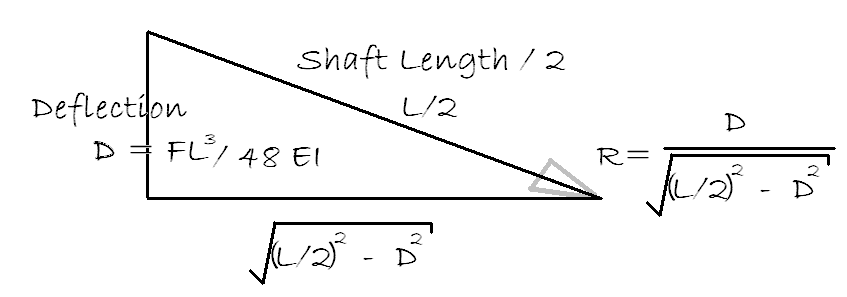
| The spine, modeled as a spring, resists this bending force, and this resistance
increases with the deflection. If the shaft is perfectly straight then the
curve of the axial force needed to bend the arrow starts of at its critical
buckling force, and decreases as you bend the arrow. To see if this makes sense,
we can draw a curve of the deflection and compare it to the axial force needed
to bend the arrow. More realistic, if the arrow is not perfectly straight, or
the force is slightly off centre, the axial force curve looks like the one shown
here. Calculating the critical buckling force the arrow, in this case, 47.2 lbs
(calculated by the approximation done by Euhler's equation), we can see that it
closely resembles the curve’s maximum of about 45lbs. |
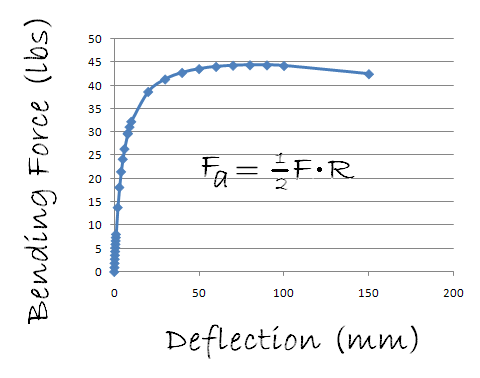
| Another interesting feature of this model is the decrease of the resistance
against deflection as the arrow is bent beyond a certain point. This resembles
the catastrophic failure of an arrow that is pushed too hard - it reaches a
point where the arrow needs less force to bend it further than it is currently
supporting, and collapses.
The neto-bending force is of course Fg - Fa, where Fg is the g-force experienced
during release. The last piece in this puzzle is to apply this force to the
weight of the part of the shaft that is being deflected, which is approximately
Ws/2. You will recall I mentioned earlier that any mass in front of a certain
point on the shaft bends it, and the mass behind this spot resist the bend. If
you add all the weights before and after all points on the shaft, you will see
that the shaft weight adding to the bending force is half of the shaft weight,
and the part that resists it is the other half of the shaft weight.
If we take these forces and apply them for a fraction of a millisecond to the
model each time, until the arrow escapes the string, we can calculate how far it
bends.
Using a bow and arrow with the following specifics as a basis, each parameter
was changed in turn, so that we can see how the model’s prediction on d-spine
changes: s-Spine: 300, Draw weight: 70lbs, Arrow rest to within 0.5mm centre
shot, Nock travel within 3mm of a straight line, Broadhead 100gr, shaft weight
10gpi, shaft length 30 inches, and Arrow’s straightness < 0.006
The "initial deflection" is again an approximation, to accommodate a number of "imperfections" of real bows and arrows: the nock travel which is not straight, the arrow rest which may not be perfectly positioned and the arrow that is not perfectly straight.
The arrow speed was calculated with an adaptation of the virtual mass model that relates stored energy, arrow speed and arrow weight: Et = (m+M+Km3).v2/450240. You can read more on this equation elsewhere in this book, for now it suffice to say that it provides for energy losses with extreme heavy arrows.
|
| Parameter changed | Range | Deflection (mm) |
| Draw weight | 50 to 90 lbs | 4.6 to 12.8 |
| Broadhead weight | 65gr to 200gr | 7.1 to 10.6 |
| Spine | 200 to 600 | 3.8 to 15.3 |
| Shaft Weight (gpi) | 6 to 14gpi | 10.4 to 7 |
| Shaft length | 26" to 32" | 5.2 to 9.7 |
| Arrow Straightness | 0.006 to 0.001 | 8.4 to 8.0 |
| Arrow Rest | 0 to 2 mm out of place | 7.2 to 11.8 |
| Nock travel | 1 to 4 mm deviation | 3.8 to 10.7 |
| There are many and varied factors influencing dynamic spine. The model presented
here, based on a simple interpretation of Newton’s laws of motion and numerical
analysis, predicts the effect of most of these parameters. The prediction of the
bending of the shaft during release may not be extremely accurate, however the
changes in the bending is fairly consistent with what would be expected from a
real arrow.
The bigger influences on d-spine are the straightness of nock travel, arrow rest
tuning, draw weight, broadhead weight and s-spine. The smaller influences are
made up of shaft straightness, weight and length.
And this brings me to the answer of why arrows seem to do the Mambo sometimes...
bow hand torque, bow heeling, pulling or pushing the bow, all moves the nock and
rest relative to each other during the release. As you saw the model predicts
that this has a major effect on how much the arrow bends when it is released!
Therefore, the d-spine is affected by release form!
But this model and equations are not helping us a lot. What we really want to
know is what s-spine should I use for my bow, and when I get the nearest
available s-spine, to what length should I cut it. Here is an empirical equation
based on the model that answers this question: |
 (Dw draw weight, DL draw length, Bh brace height, Wp pile weight, L shaft length, Ws shaft weight, S spine)
(Dw draw weight, DL draw length, Bh brace height, Wp pile weight, L shaft length, Ws shaft weight, S spine)
| This graph here is a plot to show you how relevant this equation is. 97% of the
model’s predicted deflection is accounted for by it. As a rough approximation,
you could say that the required d-spine is proportional to draw weight squared,
draw length cubed, and the square root of the pile weight. It decreases
proportionally to shaft weight. The relationship between the other factors is a
bit less "integral".
For example, for a pile weight 215gr, gpi 13, spine 280, 30" draw length, 7.25
brace height, 72 lbs and 29" shafts, it predicts a deflection of 8.5 mm. I have
a suspicion that this is a fair deflection for a 600gr arrow at 262fps.
Easton’s spine charts in general try to keep the deflection of the arrow below
10mm. I would suggest you can start at 10mm, and decrease the s-spine of the
shafts you test, to about 5mm. The best value will very much depend on your bow,
since nock travel, inherent from the bow’s design, will place a limit on the
stiffest arrow that still group nicely. |
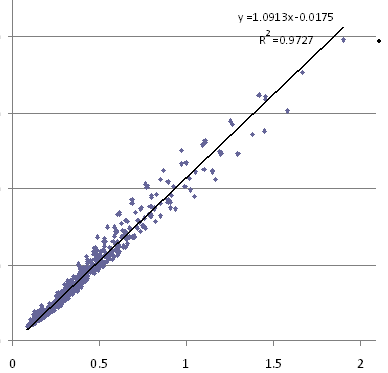 Now let's look at traditional bows and dynamic spine...
How these factors influences the frequency of vibration, is even more complicated. The closest we are able to describe the first fundamental frequency measured by Fourier analysis of a sound recording, is:
Now let's look at traditional bows and dynamic spine...
How these factors influences the frequency of vibration, is even more complicated. The closest we are able to describe the first fundamental frequency measured by Fourier analysis of a sound recording, is:
 Wp is the pile weight of the arrow, L the shaft length, S the s-spine, and Ws the shaft’s weight per inch (as GPI).
Wp is the pile weight of the arrow, L the shaft length, S the s-spine, and Ws the shaft’s weight per inch (as GPI).
| We have used this equation to predict the frequency of a number of different
arrows, and compared this to measurements as made by Bertil Olsson (USA). I was
astonished at the accuracy of the results. The total weight of the arrows he
tested varied from 291 to 500 grains, the s-spine from 700 to 390, the length
from 32.3 to 27.4", and pile weights from 89 to 180gr. The largest error was on
the arrow with the smallest shaft weight (5.9gpi), and it was a mere 3.1 Hz more
than the measured value of 87.6Hz. The equation describes 98.7% of the measured
values - as theories go, this is GOOD.
Here is a table with the experimental results: |
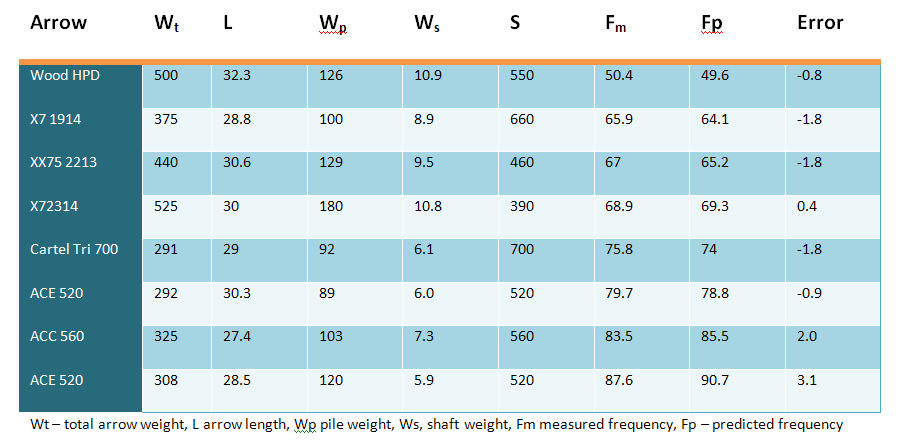
| The next question you will ask now is what frequency is the correct frequency
for your bow. Stu Miller has developed and excellent spine calculator for
non-compound bows. It has a collection of a huge number of commercial shafts,
and he actively keeps this up. You will find it easily with Google. I used this
calculator of his to compare results of my model with his empiric formula
(empiric: based on describing the relationship and not explaining it). (Just a
short reminder: The frequency will determine how fast the arrow vibrates or
bend, and therefore how much time it will take to move the fletches out of the
way of the riser as it passes to the side of it.)
The draw-force curve for a typical non-compound bow can be approximated to a
straight line, increasing from 0# at brace height, to let’s say 70# at 29". This
would imply that the average acceleration of the arrow will be half the maximum
draw force at full draw divided with the total arrow weight. The draw-force
curve for these bow designs is usually slightly higher than a straight line, but
then we also ignore the string weight and limbs weight, so we hope things equal
out. The approximation would suffice for getting a ball park figure.
For our bow, with a brace height of 8", which imply a power stroke of 29-8, 21",
and 70/2#, you can expect a 434gr arrow’s fletches to take about 16.3
milliseconds to reach the point where it should start to move the fletches away
from the riser. |
 D is draw length, B brace height, F draw weight, and Wt is the total arrow weight.
D is draw length, B brace height, F draw weight, and Wt is the total arrow weight.
| Now 16.3 milliseconds correspond to 61.2Hz (F=1/t). According to Stu Millers’s
calculator, the following arrow would have been perfect: Shaft size: 2213, 29"
with a 125gr broad head. If we calculate the frequency for this arrow, it comes
to 64.4Hz. I am inclined to believe Stu Miller’s calculator is correct. The
difference between 64.4 and 61.2 Hz (3.2Hz) corresponds to about 0.5" of shaft
length. To equalize the frequency exactly, the arrow will need to be 30" long.
This difference in frequency represents about 6cm of travel. But here is a table
of a view different arrows: |

| These arrows are matched to the bows using Stu Miller’s calculator. As you can
see the frequencies we predict is slightly different. In the next table, I have
matched the arrows to the bows using the frequency. You may notice that
according to this prediction, the last arrow may be slightly too short. |

 All this said and done, if you shoot a compound bow, it's better to err on the too stiff side. And as a general rule: Shoot the stiffest arrow that still groups satisfactory.
Further Reading: JP de Villiers, AB&A, Oct 2008, p52, "FAQ"
All this said and done, if you shoot a compound bow, it's better to err on the too stiff side. And as a general rule: Shoot the stiffest arrow that still groups satisfactory.
Further Reading: JP de Villiers, AB&A, Oct 2008, p52, "FAQ"
Seppie Celliers, AB&A, Dec 2007, p30, "Arrow Spine"
Harry Marx, AB&A, Mar 2009, p30, "Dynamic Spine and Building Heavy Arrows"
Harry Marx, AB&A, in press, , "Dynamic Spine II"
3.5.8.1.1 Easton Arrow selection charts
These are the charts for Easton and GoldTip. We include it here for instructional purposes. Although the specific arrow models change, the s-spine requirements is always relevant.
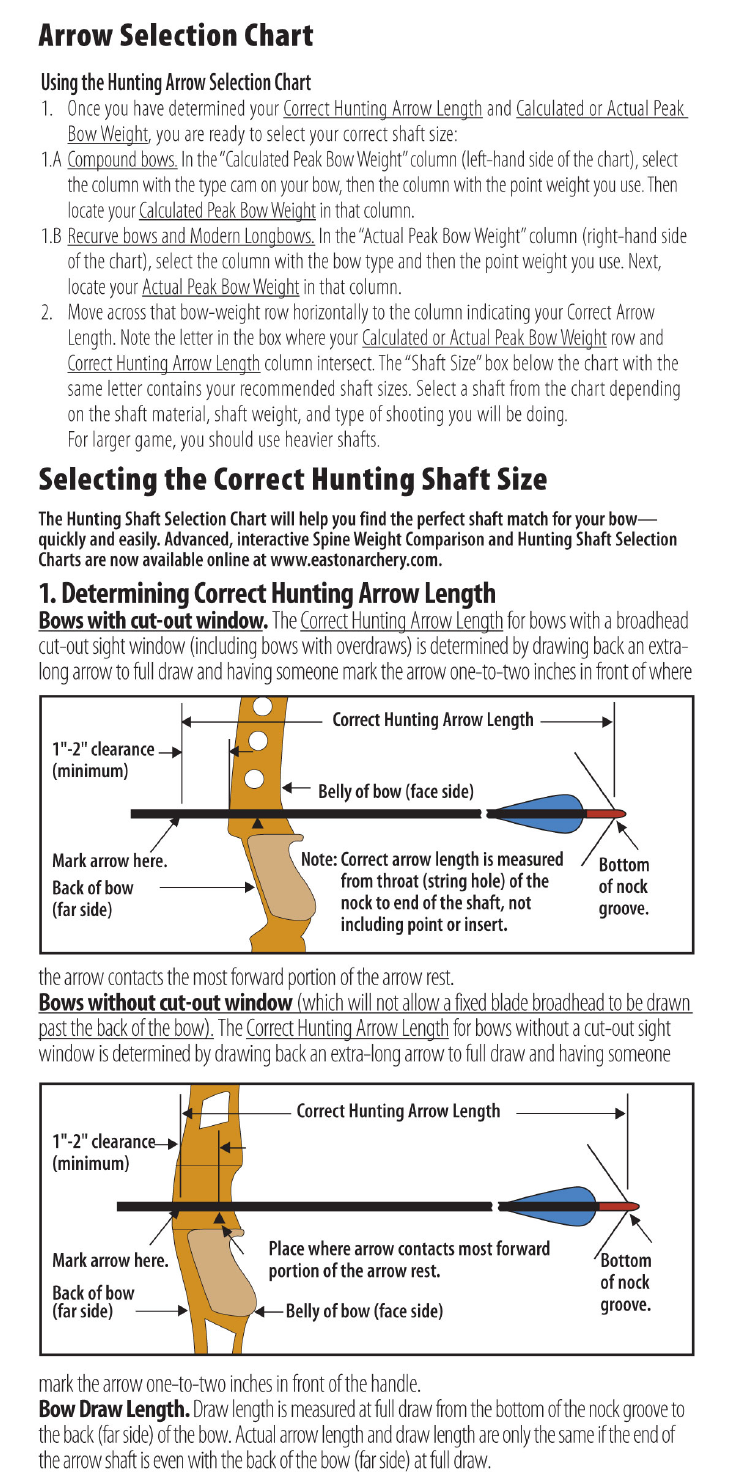
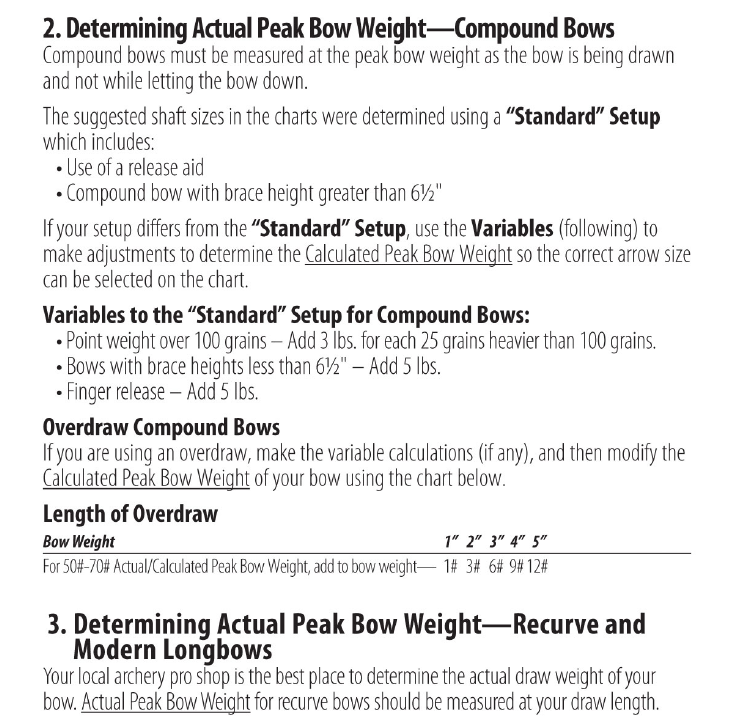
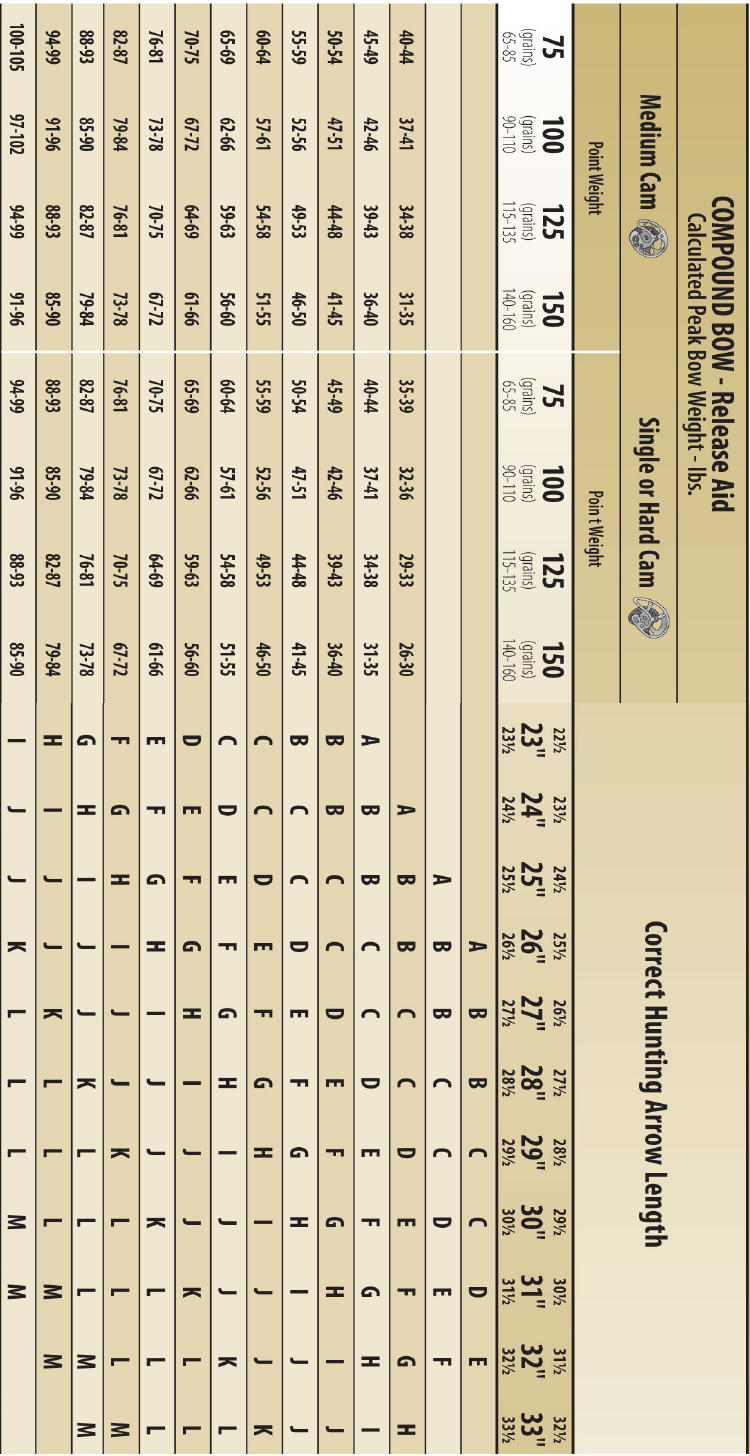
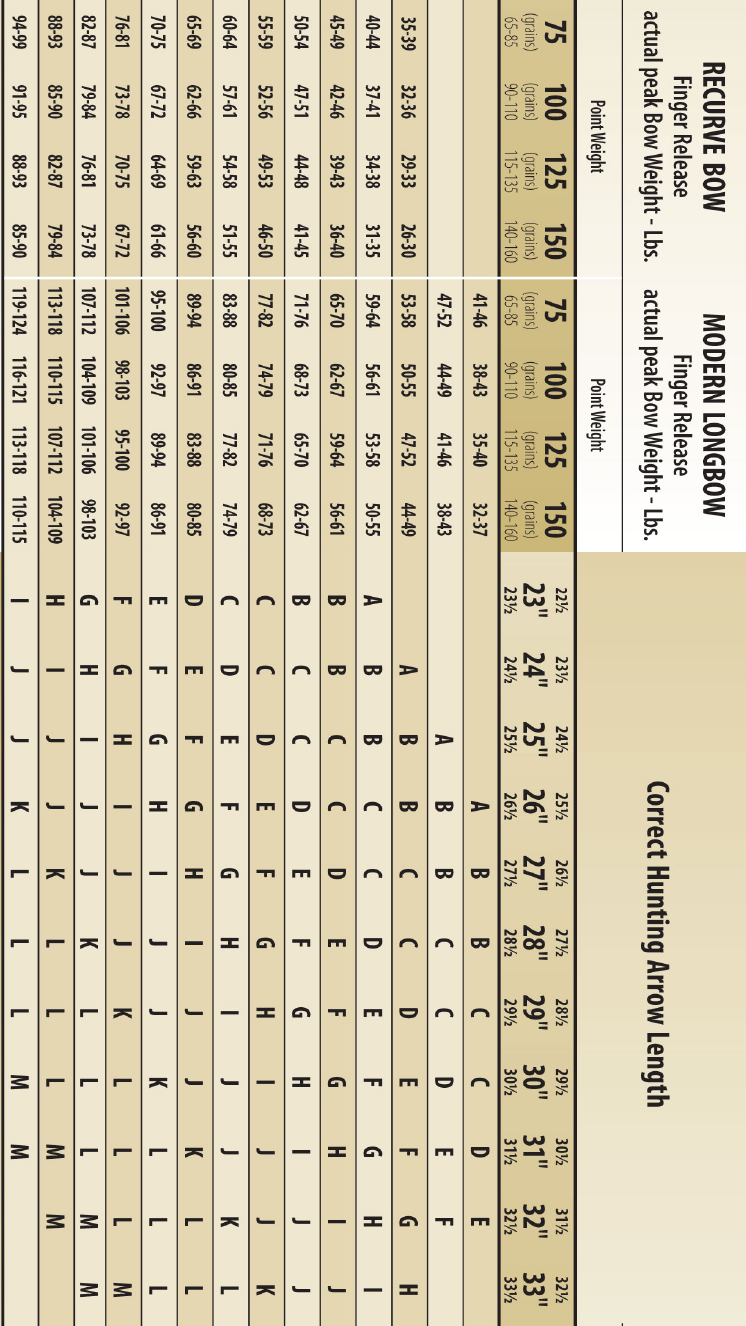
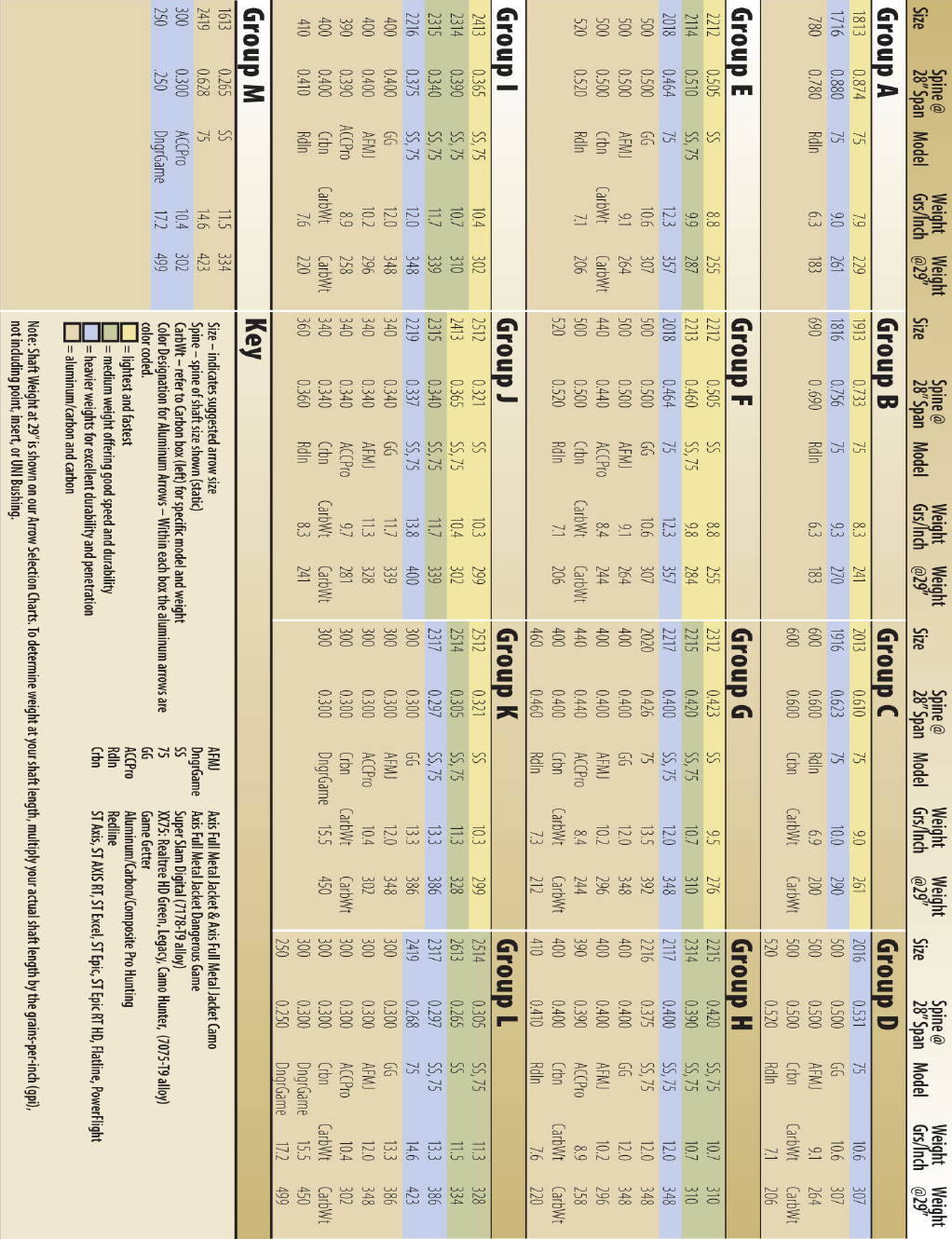

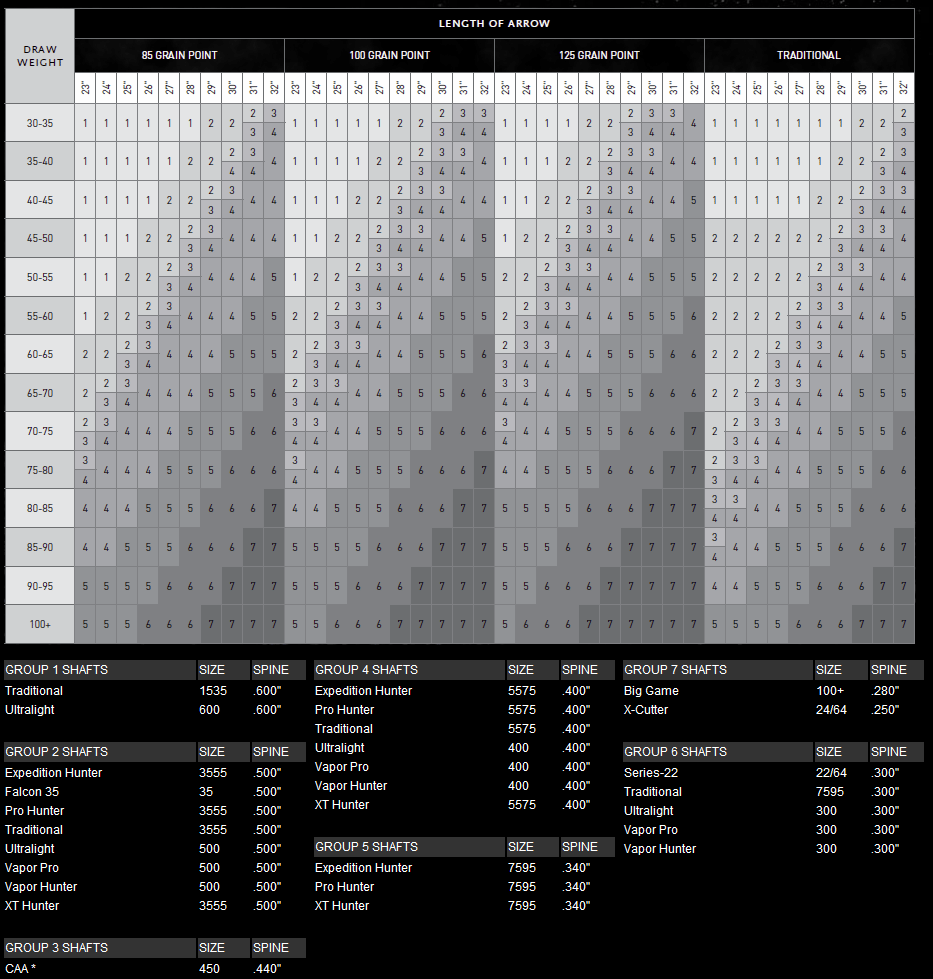
3.5.8.2 Arrow Spin
 Another major influence on arrow stability is of course arrow spin. The way in which it affects stability has little to do with the so called gyro-effect. When the arrow leaves the string, it starts to turn, if the fletching is helical or at an angle. During this process the energy to spin the arrow is drawn from the arrow’s speed by causing a drag at the back of the arrow. This "pulls" the arrow at its tail backwards, and straightens it.
Another major influence on arrow stability is of course arrow spin. The way in which it affects stability has little to do with the so called gyro-effect. When the arrow leaves the string, it starts to turn, if the fletching is helical or at an angle. During this process the energy to spin the arrow is drawn from the arrow’s speed by causing a drag at the back of the arrow. This "pulls" the arrow at its tail backwards, and straightens it.
| Once the arrow’s spin reaches the rotational speed at which it can’t be spun
quicker, due to the angle of the fletching, this drag falls away, and the arrow
no longer loses speed to spin it. If the arrow now looses speed due to gravity
or friction, it can actually be spinning faster than its fletching angle and
speed dictates. This can decrease the stability of the arrow at long
distances(>60Y), as it moves the centre of pressure forwards. Quantifying
this effect has been attempted, but for now you should just take note of this
effect. |
 Another effect the spin has on arrow flight is to limit the influence of unbalanced aerodynamic forces. Such a force would cause the un-spinning arrow to fly in a curving trajectory. When it spins, this curvature is controlled by now forcing the arrow into a helical trajectory. This does increase accuracy, but not penetration. For penetration you need an arrow which flies straight.
Another effect the spin has on arrow flight is to limit the influence of unbalanced aerodynamic forces. Such a force would cause the un-spinning arrow to fly in a curving trajectory. When it spins, this curvature is controlled by now forcing the arrow into a helical trajectory. This does increase accuracy, but not penetration. For penetration you need an arrow which flies straight.
| Increasing the size or angle of the fletching usually only works to a certain
degree. Then the increased rotation speed actually causes this unbalanced arrow
to start to wobble. It is therefore not wise to try and stabilize an already
wobbling arrow with bigger fletches. The better solution is to balance the
arrow, or to get rid of it. If the unbalance is due to the broadhead, you can
try another broadhead on it. Sometimes it’s due to the "insert" not being
inserted straight. Mostly it’s due to a used broadhead that bent slightly during
a previous shot. Spinning the arrow on its tip or in an arrow spinner usually
detects such an unbalance. Sometimes you only see it as a unwillingness to
group.
A small hint - you can number each arrow, and keep track of where each arrow
tends to group. Sometimes, arrows group very well, just not all at the same
spot.
Fritz Rabe, has another angle on arrow stability:
"In bowhunting we try to get as close as possible to an animal to make a good
shot. Very few hunters realize that to get to close can hamper penetration
especially when your target is a big tough animal like the Pachyderms, Buffalo,
Crocodile and Giraffe. |
 This is because the arrow flexes after release. Different arrows with different set-ups all flexes differently. If your arrow encounters resistance while it is still flexing it can reduce penetration up to 70%. This all depends on the power of the bow compared to the arrow. This walks hand in hand with spine.
This is because the arrow flexes after release. Different arrows with different set-ups all flexes differently. If your arrow encounters resistance while it is still flexing it can reduce penetration up to 70%. This all depends on the power of the bow compared to the arrow. This walks hand in hand with spine.
| The spine of an arrow must match the bow to start of with. In hunting, the spine
must also match the resistance especially in heavy bows with fast arrows. Most
spine charts give the spine stiffness for acceleration. This is fine for target
shooting but not for hunting. In hunting, the arrow sometimes come to a stop in
a shorter distance than it accelerate out of the bow, [for eg. when] striking a
bone.
Combine this last fact with a to close distance from the target and you will
have zero penetration even from a good set-up. |
 Every set-up has a "sweet-spot" where it will get maximum penetration. This is normally between 18 - 33 yards. The heavier the arrow and power of the bow, the longer it takes to stabilize the arrow. That is why it is a good idea to get the FOC of the arrow as much forward as possible and to use long helical fletching. A lot of people use short 2" - 3" fletches today and it works well to achieve speed and it does group etc. but it takes a long time to fully stabilize an arrow. The arrow also looses a lot of its energy during flexing that could have been put to better use.
The less an arrow flex, the more momentum it has. The faster it stabilizes the better it flies."
Further Reading: John Dudley, AB&A, Mar 2008, p30, "The Best Fletching For your Arrows"
Every set-up has a "sweet-spot" where it will get maximum penetration. This is normally between 18 - 33 yards. The heavier the arrow and power of the bow, the longer it takes to stabilize the arrow. That is why it is a good idea to get the FOC of the arrow as much forward as possible and to use long helical fletching. A lot of people use short 2" - 3" fletches today and it works well to achieve speed and it does group etc. but it takes a long time to fully stabilize an arrow. The arrow also looses a lot of its energy during flexing that could have been put to better use.
The less an arrow flex, the more momentum it has. The faster it stabilizes the better it flies."
Further Reading: John Dudley, AB&A, Mar 2008, p30, "The Best Fletching For your Arrows"
JP de Villiers, AB&A, Mar 2008, p48, "FAQs"
Sampie Stoffberg, AB&A, Jan 2009, p56, "Die keuse van vere"
3.6 Implementing all the theory
We have a calculator available for MS Excel, which can simplify these decisions.
We also have a program that extends this and lists the animals that are within these recommendations in relation to your equipment SABA Hunt Calculator
Here is a screen shot from the main page. This page describes the penetration of a particular arrow for all categories.
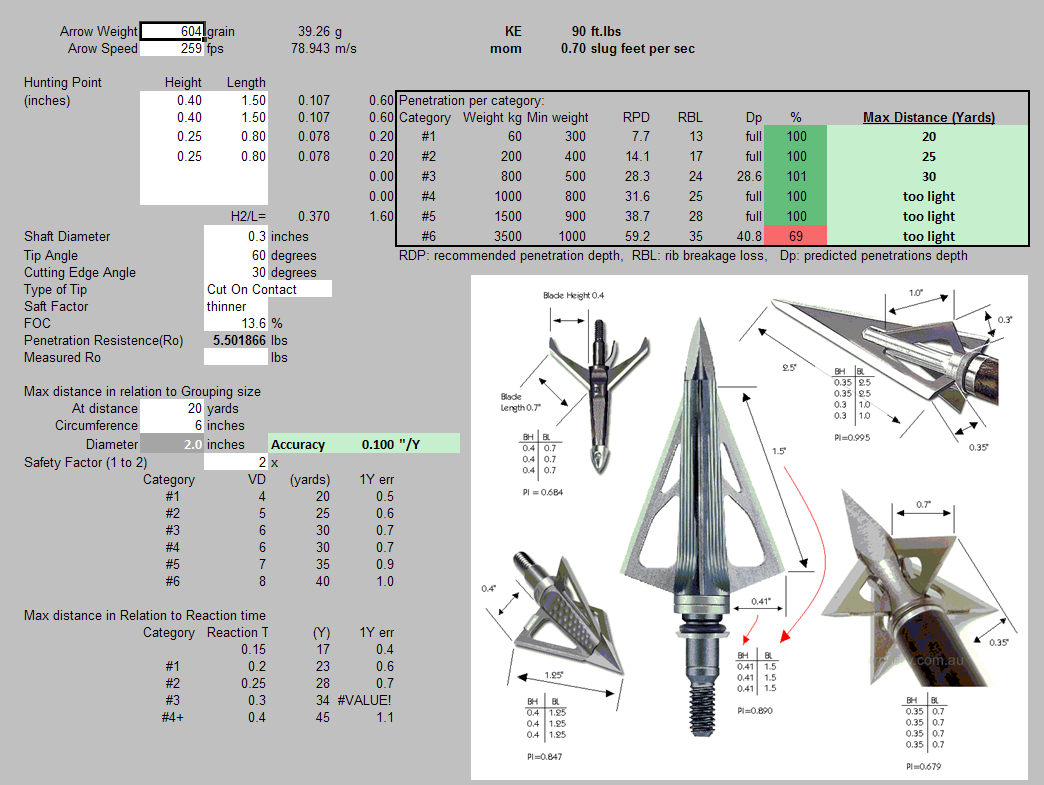
| You merely enter the data of the arrow, the broadhead, and your grouping. It
then uses all this nice maths, and show you the result in the coloured % column.
According to these principles 80% of the recommendation is on the border of
being acceptable, while 100% should on average result in a full traversal of the
animal's chest cavity. |
4 In Practice
 The hunter should practice from kneeling and sitting positions (on a chair and on the ground) to shoot. Most often when stalking an animal, you will be shooting from a very unnatural position. This can severely affect your accuracy.
The hunter should practice from kneeling and sitting positions (on a chair and on the ground) to shoot. Most often when stalking an animal, you will be shooting from a very unnatural position. This can severely affect your accuracy.
4.1 Using a bow
Further Reading: Seppie Celliers, AB&A, Jan 2007, p42, "Boogterme"
Rean Steenkamp, AB&A, Apr 2007, p47, "Eye Dominance"
4.1.1 Tuning a bow
| A bow and arrow is a complicated machine that needs expert tuning for optimal
hunting performance. We recommend that a bow hunter should practice to shoot
accurately with the highest poundage possible. It is recommended that the bow is
tuned in order to maximize the energy transferred from the bow to the arrow.
Thus the right selection of combined optimal equipment is critical and each
component of the bow hunting set-up must be carefully selected.
We will discuss tuning a bow in the order that you will need to perform it. |
4.1.2 Cam Tuning
| Although cam tuning is (almost) always done in the shop, you need a bow press
and a bow shooting machine, we discuss it here for the importance of this step.
And contrary to popular hype, even binary cams needs to be tuned. Of course this
does not apply to single cams...
Tuning cams is done basically to synchronize the cams. As the cams rotate, the
leverage they gain when moving out of the valley, will cause the one that comes
out first, to roll up the string first and basically to starve the other cam.
The starved cam is then slowed down even more. This of cause causes very uneven
nock travel. Not only does this cause all types of vibrations in the bow and the
arrow (reads loss of energy), the arrow's vibrations in turn causes a loss
accuracy.
The cams are tuned by changing the relative lengths of the two bus cables. First
you must draw the bow on the shooting machine. You can do it drawing the bow
with your arms, but you will need a friend to check the rotation, and it is not
as convenient or accurate. But the idea is to notice how far the cams rotate,
especially going into the value and reaching the back wall. Look at the gaps
between the rotation stoppers, the back wall, and the strings. They should be
the same.
If they are not the same, you need to start tuning. This involves taking the
tension of the bus cables using a bow press, just enough to unhook one loop of
one of the bus cables. Winding the cable up or down just a half turn can have a
big effect.
Hook it again, remove the bow and go and shoot 10 shots for the string to settle
again.
Then you check the rotation of the cams again on the shooting machine. |
4.1.3 Paper Tuning
| The purpose of paper tuning is to set the arrow rest's height and the
preliminary lateral position. You need to do paper tuning, and then "walk back
tuning", to get good flight from arrows with hunting points.
The rest is initially set up with the arrow going through the "centre shot"
position of the riser. Your bow shop will usually help with this.
Paper tuning is done with field points. A large paper, a news paper will do, is
hung at about 2Y from the butt. The arrow is then shot from about 2 to 10Y
through the paper into the butt. The arrow should make a round "bullet"-hole for
the shaft, with the flights cuttings three radiating spokes for it. If the arrow
were not travelling straight, where the point went through for ex. to the left
of the flights, you'll see the flights tearing three thin tears to the right of
a thicker horizontal tear made by the shaft. |
Further Reading: JP de Villiers, AB&A, Nov 2008, p52, "FAQ"
Herman Brand, AB&A, Sep 2007, p13, "Paper tuning your bow"
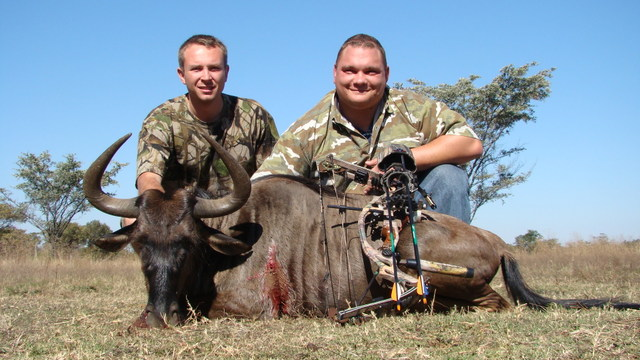
| The rest should be adjusted up or down, until the shaft's tear is horizontal.
Then you can adjust the rest left or right, until the shaft's tear is as short
as possible. Then you can put on the hunting points and process to
walk-back-tuning. |
4.1.4 Walk back tuning
| This is done with hunting points. The sight is first tuned for 20, 30, 40 and
50Y. Once you are no longer able to increase the precision with the lateral
adjustments of the sight, you can start with walk-back-tuning.
Set the sight at 50Y, but stand at 3Y from the butt (keep the sight on 50Y for
the whole exercise). Pick a spot and tune the sight until you can place the
arrow in a 1cm spot. Then walk back to 50Y, and shoot a grouping. Concentrate
only on the vertical / lateral / left-right grouping. If the grouping is to the
left of the spot you aimed at, you can move the ARROW REST slightly to the right
(and vica versa). This movement should be only about 0.5mm or 1/32".
Repeat the shots at 3Y and adjust the sight until you hit the 1cm spot again.
Then you walk back and do another grouping at 50Y - adjust the REST until it
centers on the target. And so you continue until it shoots true at 3 and 50Y.
You should now see the arrows fly straight without any wobble.
Then you can tighten the rest's screws and check it once every 1000 or so shots. |
Further Reading: JP de Villiers, AB&A, Sep 2008, p52, "FAQ"
John Dudley, AB&A, Nov 2007, p30, "Walk-back tuning with broadheads"
Seppie Celliers, AB&A, Nov 2007, p55, "Stel jagpunte in - maklik"
4.1.5 Tuning arrows
| The last step tuning your setup is looking at the arrows. By this time arrows
with broadheads and fieldpoints should be hitting close to each other. If they
do not, it most probably means that the arrows bend too much as they leave the
bow, i.e. they are under-spined. You can try more stiffer shafts.
If a particular arrow always groups of center, but at a specific spot, it is
most probably the initial bend of the shaft, or a tendency to bend in a
particular direction. Because you have set up everything so far to get the arrow
as straight as possible out of the bow, the way in which the arrow bends is very
sensitive to its imperfections.
If you fletch your own arrows, you can do the following. I put the shaft in the
spine tester, without the weight. Then you rotate it slowly. You will most
probably see the dial going up and down, as it follows the arrow's stiffness. Do
this without the weight used to measure spine, as it will increase the dail's
sensitivity. Then you fletch the arrows all with the natural bend up or down.
Also you should number your arrows. Each arrow groups at a slightly different
spot. You can rotate the nock 120 degrees, and it will move this grouping
around. You can also rotate the nock 180 degrees and try again. Doing this
without having fletched the arrows, at 20Y, if very effective.
In general, bigger broadheads need more tuning attention, as they change the
center of pressure the most (see FOC). If all the tuning does not fix your
grouping, smaller broadheads might help. The alternative is resetting the sight
for broadheads, shorter hunting distances, getting professional help ... |
4.1.6 Practicing
| Confidence in your ability to hunt is locked up in the aged old saying "practice
makes perfect". SABA simulates hunting conditions on a monthly bases on African
animals in 3D competitions in order to harness our members with knowledge and
confidence of optimally used equipment and arrow trajectory in real hunting
light conditions. "Bokkoors" can’t be simulated but can be overcome with the
confidence coming from experience in the hunters shooting ability. Every aspect
of the hunt should be coupled with confidence. |
4.1.7 Anchor Points
| Archery is almost always a mixture of old and new, and anchor points are a point
in proof. Shooting consistently is only possible if you have a constant anchor
point, and bow grip. In time, with new developments that aid with consistency,
many archers neglect the anchor point and grip. The rationale is of course that
with a peep, who needs an anchor point? In fact, as of date there are even two
products on the market that "eliminates" a peep, and therefore can be seen as to
make a consistent anchor point even less important. |
 The precise anchor point you use is not that important, although there are some guidelines. The most important issue is to anchor in exactly the same way each time.
The precise anchor point you use is not that important, although there are some guidelines. The most important issue is to anchor in exactly the same way each time.
| Some archers anchor below the chin, some against a lucky tooth, some behind the
yaw bone, and so on. I anchor with a knuckle into the back of my ear. Of course,
when using a mechanical release, your options are very much defined by the type
of release. One interesting variation is to anchor the thumb behind the neck.
This provides a very stable support for a very long draw length. Some archers
also believe in a third anchor point. This is usually done by touching the tip
of the nose to the string. Kisser buttons are also popular with traditional
archers, which is a brass nut or even just a small leather strip knotted to the
string. The idea is that you put this physical marker on your mouth or lips, on
a particular spot each time.
On holding the string with your fingers, there are two schools: the
Mediterranean way, and the apache way. The Mediterranean way uses two fingers
above and below the arrow, while the apache hold puts just one finger above the
arrow. Some people shoot with three fingers below the arrow, and none above.
If course, the innovation of the peep sight have greatly enhanced accuracy even
where archers tend to neglect their anchor point. However not everybody likes a
peep sight. There are lots of issues around it, for example if it's aligned with
the aid of an elastic band or string, whether it is a round hole or a slit, or
the size of the peep. But we'll discuss these when we talk about sights.
The one aspect of an anchor point that is usually explained is its function as
rear sight of the bow (from there the tendency to neglect it in favour of a
peep). However there is another important aspect that is not normally thought
of.
If you look at the whole stance of the archer, the anchor point is always above
the shoulders. The shoulders are the bases on which your arms are anchoring to
not only draw the bow, but to hold it up, and to hold it still. This implies
that there is an angle against which the bow pushes against the bow-arm. |

| As you can see on this drawing, the string arm is also supplying lift to the
bow-arm when it draws the bow. The height of the anchor point above the
shoulders determine how much of this pull is used to keep the bow up, vs.
drawing the string back.
When you release, the component of the string arm that keeps the bow arm up
falls away, and you see a tendency of the bow arm to fall when released during
the "surprise shot" (see "Aiming" for a definition of this). So you can see that
changing the height of the anchor will put more or less strain on the bow-arm to
keep the bow up. Also when you change the physical weight or the draw weight of
the bow, the strain changes.
The best height of anchoring will therefore not just depend on your favourite
form, but it will be dependent on the bow that you shoot with, and where it
settles into a point of comfortable balance. I often hear, and experience
myself, the problem of "my sight is glued to the target just below the spot
where I want to shoot, and I cannot seem to lift it that last inch or two".
Although this phenomenon can be the result of target panic (see elsewhere), it
can just as well be the anchor point that is giving you problems. If you
experience this again, try pulling harder at the string, and you will see the
bow lifts suddenly. This "below the spot freezing" is not a sign of panic, it is
more an indication that you are relaxing your body, as it should be.
The bow is moved up or down not with the bow arm, but with the draw-arm. |
4.1.8 Draw length
| Determining the correct draw length is important, and very easy. Measure your
arm's span from fingertips to finger tips, stretched out to the sides against a
wall, and divide this with 2.5. Use this to set the bow's draw length, and then
you can fine tune it further with either adjusting the cams, or string length,
or even the D-loop length.
When at full draw, your bow arm should be slightly bent, while your shoulders
are slightly "open" to the shot, i.e. not parallel with the arrow. If the bow's
draw length is too long, your shoulders will "close" the stance, and you will
probably straighten and lock your bow arm. This will result in some serious
injury as the string hits your forearm... If you frequently experience this, you
will soon give up archery! Decreasing the draw length may help to prevent this
painful situation.
A too short draw-length will leave your shoulders too open, and put more stain
on the shoulders. This will lead to accuracy problems, and your shoulders to
tire quickly. The straighter you shoulders and bow arm are, the less strain they
take to hold a drawn bow.
The correct draw length therefore keeps things out of the way of the strings,
but not too far from the shooting line. |
4.1.9 The Grip
| The solution is of course that when you do relax your chest muscles, you must
pull a bit harder with your back muscles, to get the string-arm's shoulder to
rotate further back, and therefore to pull slightly harder - to lift the bow
into line again. But after all, the anchor point you use, should be comfortable,
and by definition, this will be close to the point of balance. When talking
about bow grips, I got the following advice. The top of the handle should lie in
the V of the thumb and the hand, and the bottom part should rest against the
heel of the hand, between the thumb and the hand muscles. In other words, the
top of your hand should be about 40 to 45 degrees turned out, while the bow is
vertical.
The reason for this slightly strange hold is simply to keep your arm away from
the string. Many archers wear arm guards, for exactly the danger of the string
touching the forearm during release. (This can also be a symptom of a too long
draw length.) Keeping the wrist turned in that way, the bow arm slightly bent,
and with the correct draw length, you should never suffer the wrath of a string.
When holding the bow at full draw, the bow hand should be relaxed, and the
fingers preferable be open - at least not touching the bow. The idea is to make
contact with the bow only on the side of the handle closest to you. |
 A tight grip usually puts an unnoticed torque on the bow, that pulls the arrow to the sides during release. With a relaxed hold, only touching on a small part of the handle, this torque is greatly reduced.
A tight grip usually puts an unnoticed torque on the bow, that pulls the arrow to the sides during release. With a relaxed hold, only touching on a small part of the handle, this torque is greatly reduced.
| There are a few products on the market that promises to eliminate bow torque.
These products are usually fastened on the riser, and shows the archer if the
riser is torqued. Torque rotates the riser slightly from its natural position in
full draw.
One such product contains a small lens and reflective area for light. This
device, if properly adjusted, not only shows you torque, but also does the same
as a peep in that it fixes your anchor point. A second device uses two parts or
pins, which must be aligned for proper sighting. Both of these shows torque as a
misalignment. When I just started shooting I built my own "torque indicator". I
used a small 5x5mm mirror, adjustable, fixed to the riser. I adjusted the mirror
such that I saw the peep reflected in it when looking through it at full draw.
This worked very well, but I realized again that to depend on the gadget to fix
the problem, which was an inconsistent grip, is not the way to go. |
 Again, the best grip is the comfortable one, the one you can consistently apply.
Again, the best grip is the comfortable one, the one you can consistently apply.
4.1.10 Aiming Technique
| There is generally two ways to aim, without or with a sight. When shooting
without a sight, you have to judge the trajectory of the arrow. This takes
extreme levels of practice to achieve. Mostly used by "traditional hunters",
which are shooting with longbows and recurves. There are a few archers who have
achieved unbelievable accuracy in this way, however, most hunters are more
successful using sights. Shooting instinctively does have the advantage of being
fast. It is possible to aim and shoot in much less time than it would take using
sights. This is a technique to be practiced, and very little else can be said
about it.
Most bow hunters these days shoot with sights. Shooting with a sight is not as
easy as it would seem at first glance. There are two types of sights on the
market, multi-pin sights and single pin sights. With both you need to set the
sight up for the distances you expect to hunt at. This should in general be 20,
25, 30, 35 and 40 yards (or meters). (Hunting at further distances is generally
not possible or recommended.) But the pros and cons of each will be discussed
when we talk about sights in specific.
The biggest problem for all archers is how to keep the sight still, and on
target, while shooting. It is in essence what aiming is all about when shooting
with a sight. To start with, all muscles under tension trembles. The frequency
with which they tremble is a function of the length of the neural feedback loop
that controls the tension in the muscle. The physical length of this loop cannot
be shortened, since it is built with neurons going from the muscle into the
spinal column, and back to the muscle again. However, the speed of the signal,
and therefore the time it takes to travel this same distance can be changed.
A good diet is essential, and especially in today’s era of zero fats and no
cholesterol, people forget that there two fats that we have to eat to stay
healthy. These essential fats are abundant in fatty foods, but since we are
avoiding these, supplements are necessary. These fats form part of the isolation
of neurons, and just like Faraday-screening on electrical wires increases the
rate at which information can be sent in them, so a healthy fat layers (called
the myelin sheet) on neurons ensure quick response times. With practice, it has
indeed been observed, that these layers can increase in thickness, which do
increase the transmission rate.
Another source of tremors of muscle is low blood sugar levels. Again, a healthy
diet, and some sweet drinks or sweets is useful on a hunting trip. Never shoot
when you are already feeling weak or have low sugar tremors. |
 However, probably the biggest source of unwanted movement is the archer trying to think about the problem.
However, probably the biggest source of unwanted movement is the archer trying to think about the problem.
| In exactly the same way that a thin myelin sheet increases reaction time,
overriding these reflexes with conscious control, takes way longer. This of
course increases the unwanted shaking movement. With practice, an action becomes
unconscious. This is indeed what happens, and in becoming unconscious, it also
becomes faster. Further practice, and honing of this unconscious skill, will
reduce the time for feedback even further. The conclusion to cure the wandering
sight syndrome is to relax and not to think about it. Aim like riding a bicycle.
But, even practicing forever will never eliminate all sources of unwanted
movement. You will need to breath, and you heart will need to pump. Breathing
changes the anchor points of the muscles that is keeping your arms up, so they
have to continually change in order to keep your arms still. Again, relaxing and
keeping your breathing slow, shallow and rhythmic will help.
Your heartbeat creates a different problem. It causes a pressure change in your
arteries, and since your muscles are infused with arteries, it causes them to
beat. Relaxing and controlled breathing, will slow down and decrease the
intensity of the heartbeat. Of course, if you get "bokkoors", you can experience
the exact and extreme effect of this. By the way, there are medication with
which can control this. Do NOT USE IT! These drugs pose a serious health risk,
not to mention ethical issues. |
 The actual technique of aiming varies and is mostly a personal thing. It is suggested however to draw the bow slightly higher than the target, after which you can allow the sight pin to sink SLOWLY onto the spot.
The actual technique of aiming varies and is mostly a personal thing. It is suggested however to draw the bow slightly higher than the target, after which you can allow the sight pin to sink SLOWLY onto the spot.
| Generally however, you will find that you approach the target with the open area
of the sight. If the pins are fastened onto the right half of the sight ring,
the left side will be open, and you will find yourself approaching the target
with the pins generally from right to left. This would suggest the best pin
configuration to be hanging from the top of the ring, which sadly is not
available. In fact, single pin sights usually have the pin fixed to the bottom
of the ring.
There is in fact research being done on the effectiveness of various pin and
sight type configurations.
Experimented with various designs.
Also see "target panic" for another angle on aiming. |
4.1.11 The Release
| One of the most important steps in shooting is of course the release. Target
archers have a great advantage over hunters, in that they can employ what's
called a "surprise release". In effect, the release is done in such a way that
the archer is unable to predict the exact moment the release will occur. This in
turn implies that they are not able to "compensate", or pre-empt it, with some
muscle action. The idea not that the release should take you by surprise, it
merely means that you should not be able to pre-empt the exact moment it will
occur.
For hunting, a "surprise" shot is not recommended. Usually the animal presents a
shot in a very small time window, and you have to control the exact timing of
the release. Wind also plays a factor, and if it blows the bow all over the
place, again timing of the release is crucial.
So how do you stop from pre-empting the controlled release? With practice of
course. Here are two techniques you can use to practice this. Both should be
done standing not further than 10Y from a large field point butt, with of course
field points on your arrows. Expect uncontrolled shots, so never do this in your
backyard in town. Do this on the farm, with everybody behind you. |
 Exercise one: The dummy release: Draw the bow with your finger behind the trigger. Leave it there and aim. Now imagine you taking the shot, keeping your finger behind the trigger, pull it back as if you are doing the release. Your bow arm should of course stay perfectly still. Do this two or three times, then do the real release.
Exercise one: The dummy release: Draw the bow with your finger behind the trigger. Leave it there and aim. Now imagine you taking the shot, keeping your finger behind the trigger, pull it back as if you are doing the release. Your bow arm should of course stay perfectly still. Do this two or three times, then do the real release.
 Exercise two: The friendly release: Have a trusted friend stand next to you. Draw the bow, aim, and allow your friend to enact the release. In this exercise, your bow arm must NOT stay still. It must be pulled to the side as you release, as you can't compensate for the shot, which is exactly as it should be.
Further Reading: Roy Gaylard, AB&A, Apr 2006, p36, "Instructions for beginners"
Exercise two: The friendly release: Have a trusted friend stand next to you. Draw the bow, aim, and allow your friend to enact the release. In this exercise, your bow arm must NOT stay still. It must be pulled to the side as you release, as you can't compensate for the shot, which is exactly as it should be.
Further Reading: Roy Gaylard, AB&A, Apr 2006, p36, "Instructions for beginners"
4.1.12 Shooting uphill or downhill
| The trajectory of an arrow is actually quite a complex model. The complicating
factor is that friction in air is dependent on the square of the velocity of the
arrow. It is of course also dependent on the arrow design, its broadhead and
fletches, and how it travels. An additional factor is the angle of the fletches.
This causes more friction during release, but potentially a straighter flight,
endless friction at the last stages of the flight.
However, ignoring most of these factors, except the speed dependancy, does
provide useful results. Starting off with friction, it acts like a force (Fr)
that decelerates (d) the arrow: d = Fr / m, where m is the weight of the arrow.
The again the friction is dependent on the speed squared: Fr = k.v2.
Using the equation vi+1 = vi + K.vi2.dt, (where the speed at each step is
calculated with K and the speed in the previous step, and small time slices) K
can be adjusted until the model and the arrow looses the same speed over the
first 20Y, to within as accurate as you can measure the arrow's speed. Also note
the similarity if this model with calculating penetration depths.
So what is this useful for? The simplest model for shooting angled shots is
using the COS-rule. The results from this program are however much more exact.
Of course, the result is dependent on the particular arrow, and how fast you
shoot it. Here is an example of the output of such a program (this was for an
arrow at 260fps): |
Angle
45: 6.5 14.2 21.5 29.1 36.7 44.4
40: 7.5 15.3 23.3 31.4 39.7 47.8
35: 7.7 16.5 25 33.5 42.2 51
30: 8.7 17.2 26.4 35.1 44.2 53.4
22: 9.2 18.6 28 37.6 47.2 56.7
15: 9.4 19.4 29.1 39 48.7 58.7
10.0 20.0 30.0 40.0 50.0 60.0
-15: 9.9 19.4 28.9 38.3 48 57.4
-22: 9.4 18.6 27.8 36.7 46 55
-30: 8.9 17.5 25.9 34.4 42.9 51.2
-35: 8.4 16.5 24.5 32.4 40.6 48.5
-40: 8 15.3 22.9 30.3 37.9 45.3
-45: 7.5 14.2 21.2 28 34.9 41.7
An exact formula for calculating the compensation for uphill and downhill shots does not exist. However, the following approximation also works well:
 The distance you should use to aim with, is the horizontal distance to the target, regardless of whether you are shooting uphill or downhill.
The distance you should use to aim with, is the horizontal distance to the target, regardless of whether you are shooting uphill or downhill.
| Some rangefinders already calculate this for you. With older ones, you can pick
some other object that is directly below or above the animal. What is also
important about these shots is the way in which it's done. You should preserve
your shooting form when doing so, and not lower or raise your bow arm to make
them, but bend at the waist. Draw and anchor the shot as if the target is
straight ahead. Then bend in the waist to aim. |
degrees 5 10 15 20 25 30 35 40 45
measured 15 15 15 14 14 14 13 12 11 11
distance 20 20 20 19 19 18 17 16 15 14
25 25 25 24 23 23 22 20 19 18
30 30 30 29 28 27 26 25 23 21
35 35 34 34 33 32 30 29 27 25
40 40 39 39 38 36 35 33 31 28
45 45 44 43 42 41 39 37 34 32
50 50 49 48 47 45 43 41 38 35
55 55 54 53 52 50 48 45 42 39
60 60 59 58 56 54 52 49 46 42
| There is a way in which to compensate using the above concept, without doing any
maths in the field. It involves however that you set up a "zero yard pin". It
also assumes you are using a multi-pin sight.If not, you can implement the idea
on a piece of card bord. This zero yards pin should be set up above the 20Y pin,
at about the same distance from it as the 30Y pin is below it. When executing
the shot, you first aim using the zero yard pin, holding the bow vertical or
straight up. I.e. you ignore the peep and anchor point, and put the 0Y pin on
the target, with the arrow exactly horizontal. If the distance measured was say
40Y, look and note very carefully at where the 40Y pin touches the animal/target
while doing the aiming on the 0Y pin. Now lift or lower the bow, draw it,
anchor, and aim horizontally through the peep at an imaginary target level with
yourself.
Now bend in the waist, until you get the target into view again. Put the 0Y pin
where it was previously.
Now check on which pin the 40Y spot you mentally marked earlier, falls. For
example let us say it is the 30Y pin (it must be less than the measured
distance). Now you lift the bow slightly, and aim normally with the 30Y pin, and
shoot.
|
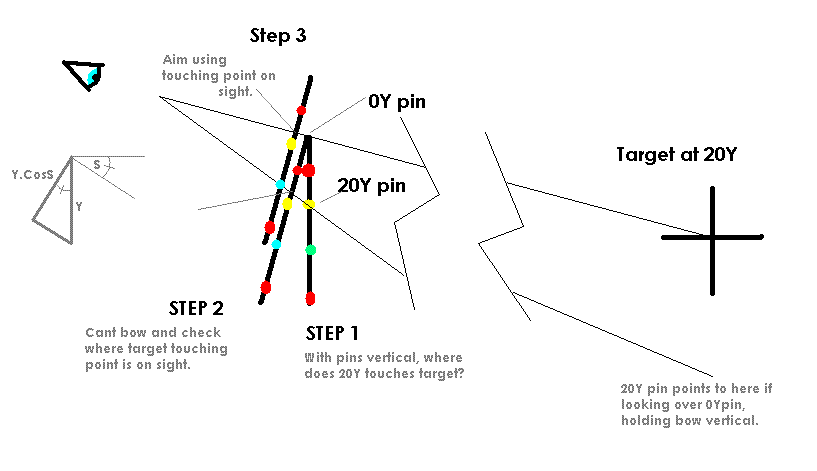 Further Reading: Harry Marx, AB&A, Mar 2008, p14, "Compensating for shooting at a slope"
Further Reading: Harry Marx, AB&A, Mar 2008, p14, "Compensating for shooting at a slope"
4.1.13 Shooting through a gap
| Often when you walk and stalk, and even more often if you shoot from cover, you
have only a narrow gap to shoot through. This gap may be directly in front of
you, but it may be anywhere between the animal and you. Knowing the arrow's
trajectory can allow you to miss these obstructions, and shoot a perfect shot.
The obvious starting point is to know that the arrow starts of at about 4 to 6
inches below the line of sight (that which you see when aiming). It then travels
upwards, crossing the line of sight, and flies above it for some time, until it
hits the target, meeting the line of sight as it comes down. If you have a
multi-pin sight, dodging the obstruction is easy. |
 If your multi-pin sight is set up on 20, 30 and 40 yards (or meters), whichever pin you aim with, the arrow will cross the line of sight over a particular pin, at that pin's distance. For example, if you are aiming at a target at 40Y, the arrow will be at 20Y, where ever the 20Y pin is aiming at. At 30Y, it will be at the point the 30Y pin is aiming at.
Here is an illustration (NOT to scale) of this:
If your multi-pin sight is set up on 20, 30 and 40 yards (or meters), whichever pin you aim with, the arrow will cross the line of sight over a particular pin, at that pin's distance. For example, if you are aiming at a target at 40Y, the arrow will be at 20Y, where ever the 20Y pin is aiming at. At 30Y, it will be at the point the 30Y pin is aiming at.
Here is an illustration (NOT to scale) of this:

| The arrow passes through the loops at various distances. What is very useful to
note is that if you moved loop E, such that the arrow falls through it on the
30Y pin's line of sight, that loop will be at 30Y. In other words, if the loop
(or gap) is at 20Y (as is loop D), the arrow will fall through it if the 20Y
pin's line of sight is on it!
The points at which the arrow passes the line of sight going up, is not that
straight forward. Firstly the arrow's speed has an influence on the exact
distance. However, you would be very close if you considered these distance to
vary from 3 to 6 yards (or meters), for the 50 to 20Y pins. Which again means
that if you aim for a buck at 40Y, the line of sight for the 20Y pin must be
clear of obstructions at 6 and 20Y. The 30Y pin must be clear at 4.5Y and 30Y.
And the 40Y pin must be clear at 3 and 40Y.
Now you may wonder where in the trajectory is the arrow's highest point, and how
high is it. It will be very close to halfway between the target and you, and
very close to the line of sight for the pin position that corresponds to the
halfway mark. If the target is at 40Y, it will reach its apex at 20Y (half the
distance), at the same height as a loop at 20Y through which the 20Y pin's line
of sight goes, while aiming at 40Y.
Now if you do NOT have a multi-pin sight, well... all things comes with its pros
and cons. You simply can't do this. However, again you could make a cardboard
drawing of a multi-pin sight and use that. Shoot an arrow low into the butt at
30Y. Then walk forward to 20Y, aim at the arrow with the 30Y pin, and shoot a
2nd arrow. Walk back to 30Y, and mark the vertical distance between the arrows
on the card (starting at the top of the card) as 20Y (upper arrow) and 30Y
(lower arrow). Hold the card at arm's length. Now do the same for 30Y and 40Y,
marking 40Y below the 30Y mark made previously. |
4.1.14 Target Panic
| Every archer and hunter experiences target panic at least once. It can take a
number of different forms: the inability to release the arrow (freezing), the
inability to move the sight on to the target, or snap shooting - releasing the
arrow the instance the sight passes the target.
All of these forms are the result of a single psychological (mental) reason -
the fear to miss the target. Missing the target can mean just loosing the arrow,
or at worst wounding the animal. This fear manifests in a mental block that
either freezes up part of the action, or causes a premature release.
There are three possible treatments for it. I refrain from calling them cures,
since target panic is not a disease, but a state of mind, and frequently
resurfaces.
1) The first treatment requires you to lower the bow's draw weight, or shoot
with a lower draw weight bow. This eases the tension in your body at full draw,
making it easier to aim, and as such lowers the possibility of missing. Once you
are again comfortable, you can slowly increase the bow's draw weight again.
2) The second treatment involves a change in form, usually by changing the type
of release used. "Back tension" releases are usually offered as the cure, but
I'm skeptical, and in any case they are not recommended for hunting.
For myself I found a redesign of the whole trigger assembly, inverting the
trigger action from being pulled to being pushed, helped to a large degree. In
general, if you flinch - i.e. you pre-empt a shot that did not take place, you
instinctively closes the trigger hand. This of course forces the release, as
your finger is usually on the trigger. If however you need to push the trigger
forward to release the arrow, closing your hand during the flinch moves it away
from the trigger, and this knowledge greatly reduces mental tension (and reduces
the danger of a uncontrolled fire). Sadly again, this type of release is very
scarce. |
 3) The most effective treatment is however to remove all targets from the butt, and to shoot at it from a ridiculously close distance, say 5Y. In such a position you simply have no fear of missing the target or the butt. Shoot like this until you are comfortable (bored), and can perform both the exercises for good release, without flinching, or even needing to suppress a flinch. Then you can add a target, still at 5Y, and go at it again. The next progression is to repeat this process at 10Y, then 15, etc.
3) The most effective treatment is however to remove all targets from the butt, and to shoot at it from a ridiculously close distance, say 5Y. In such a position you simply have no fear of missing the target or the butt. Shoot like this until you are comfortable (bored), and can perform both the exercises for good release, without flinching, or even needing to suppress a flinch. Then you can add a target, still at 5Y, and go at it again. The next progression is to repeat this process at 10Y, then 15, etc.
| Shooting at 5Y with your eyes closed is also suggested frequently. I found this
generally to increase anxiety, and do not suggest it. You will probably need to
return to these treatments in time. I found it useful to include these
activities as part of my normal exercise routine.
If you are shooting for a long time, a different problems starts to rear its
head. You start to shoot more "instinctively" (without thinking). This sometimes
causes you to "lose control" of your trigger finger.As the pin approaches the
target, the shot simply goes off - and you never instructed your finger to pull.
You can easily measure the degree to which you are already suffering from this.
When aiming next time, put the pin on the target, touch the trigger, but do not
pull it. If you can do this, you are still "in control". If you cannot, well,
you have a problem. The feeling is similar to the urge you get to close your
eyes when someone threw sand in them. It is almost unstoppable - the shot MUST
be done... I know, since I suffer from this. But luckily there is a good
treatment for this as well. You see if some action is being performed
unconsciously due to repetition, you only need to change the action and it will
"bounce" back into consciousness, or conscious control. The treatment in this
case is to change the finger you pull the trigger with. Doing this change often
keeps the process from falling into unconsciousness. |
Also see the exercises under The Release.
Further Reading: John Dudley, AB&A, Jan 2008, p15, "Curing Buck Fever and Target Panic"
4.1.15 Arrow Care
| Make sure you arrows are clean. When shooting into 3D targets, often some of the
material sticks to the arrow. This should be removed before you can shoot with
the arrow again. This material not only make the arrow lie incorrectly on the
rest, but can also bump it in any direction as it is released. You can rub the
shafts in hard, old soap to protect them against it.
Frequently inspect your arrows. Bend the arrow in all directions and check for
cracks and listen for cracking. Aluminum arrows of course bends easy, and dents
if it hits against other arrows during practice. The bends and dents hardens the
aluminum, and makes them prone to cracking. It is a good idea to heat the shaft
at the spot of the dent with a candle or cigarette lighter. Carbon fiber and
fiber glass arrows of course do not dent, they break. Never shoot cracked
arrows.
The most frequent issue with arrows is however the nocks. They take the most
strain during release, and if they break during release can cause serious damage
to your bow, for practical purposes causing a dry fire.
Also check the fletching frequently. Needless to say, loose or cut fletching
affects arrow flights. |
Further Reading: Seppie Celliers, AB&A, May 2008, p59, "Presteer jou pyle?"
Seppie Celliers, AB&A, Feb 2008, p56, "Hoe om pyle te kies en te 'tune'"
Schalk van der Merwe, AB&A, Mar 2008, p51, "Vlieg jou pyle reguit?"
Mark Slatter, AB&A, Sep 2009, p19, "Assembling Arrows for maximum penetration"
John Dudley, AB&A, May 2008, p30, "Pre-season arrow building"
4.2 Preparing for the hunt (overview)
| Your equipment must be in top working order and you must know which animal
category can be hunted with the bow equipment as a whole. Prepare thoroughly and
check each component for optimal mechanical operation. When arriving at the game
farm, be thoroughly briefed and get the farm’s rules and regulations together
with a price list of animals that may or may not be hunted. Always have a knife
and a good wire cutter in your daypack to remove snares set by poachers. |
Further Reading: Herman Brand, AB&A, May 2008, p56, "Wenke vir daardie eerste keer"
Johan Steenkamp, AB&A, Aug 2007, p25, "My First Hunt"
Engee Potgieter, AB&A, May 2007, p27, "Pre-season preperation"
Herman Brand, AB&A, Feb 2008, p47, "Wat maak 'n bok dood?"
Johannes Schabort, AB&A, Apr 2008, p56, "Hoe goed moet jy klan skiet?"
Dieter Noli, AB&A, Mar 2008, p71, "Extreme Bowhunting"
4.2.1 "Walk and Stalk"
Further Reading: JC Botha, AB&A, May 2008, p68, "The art of Walk and Stalk"
Johannes Schabort, AB&A, Oct 2007, p30 , "Getting into bow range"
Cleve Cheney, AB&A, Aug 2007, p14, "Bushcraft: Walk and Stalk"
Engee Potgieter, AB&A, Jun 2008, p58, "Stadig deur die bosse"
4.2.2 Hunting from hides
Further Reading: Herman Brand, AB&A, Apr 2007, p31, "Jag uit 'n Skuiling"
Pieter Oberholzer, AB&A, Sep 2007, p49, "Die Onderskatter Boonstoel"
4.3 Hunting Fish
Further Reading: Herman Brand, AB%A, Oct 2006, p50, "Visskietseisoen is hier"
Cleve Cheney, AB%A, Dec 2006, p8, "Bowhunting Fish"
Herman Brand, AB&A, Dec 2006, p50, "Voorreg om vis te skiet"
4.4 Hunting Birds
Further Reading: Cleve Cheney, AB&A, Jun 2006, p8, "Hunting Waterfowl"
Engee Potgieter, AB&A, Jun 2006, p23, "Hunting Waterfowl with bow and arrow"
Engee Potgieter, AB&A, Aug 2007, p31, "The ABC of bowhunting for birds"
4.5 A Primer on Shot Placement
| The animal always comes FIRST. A picture of you and a successfully bow hunted
animal, capture what this book is all about. With the hunter in the background
and the hunted quarry in front, the picture advocates to the world the essence
of the skill of bow hunting in its truest form. The world looking at your
picture sees the animal in the foreground FIRST and the hunter in the
background.
Shooting groupings in your back yard, practicing simulated hunts at SABA’s 3D
competitions and in-depth equipment knowledge, harness your confidence in your
ability the moment the animal are spotted.
- Study the animal and its behaviour. Wind direction, animal body position,
age, gender, young, open shot and Game Farm rules are some critical aspects
of this study.
- Visualize the shot where the arrow will break the skin in the vital area
by picking a reference spot on the animal's hide.
- Know the exact distance to the quarry. No matter how good you can
GUESS distance, make use of a range finder and make double sure. This
will harness your confidence and be a building block to eliminate or
ease "Bokkoors".
- Follow your practiced archery routine and be ready to be tested at the
highest level of the sport, namely bow hunting. Tip: Remember to breath.
|
 It's not the bow that kills the animal, and not even the arrow, it's the hunting point. The blades must be as sharp as you can get them. Furthermore, for any shots all the major bones must be avoided. So if the animal is standing nicely quartered, shooting for the heart is considered a risky shot, since almost half of it may be obscured by the forward leg. So it depends very much on how far you are from the animal, and how accurate you can shoot. In general, it is good hunting practice to shoot a safe shot. If you draw a triangle on the leg bones, and the largest circle inside this, the safest shot is for or just behind the centre of this circle. If the animal's nearest front leg is forward of the other front leg, as if he last stepped with it, the heart is of course opened for a clean shot.
Most printed targets on sale are for rifle hunters. Usually they show the position of the lungs, heart, neck and brain.This is not particular applicable to bow hunting. For bow hunting practice only the heart and lungs are of real importance.
It's not the bow that kills the animal, and not even the arrow, it's the hunting point. The blades must be as sharp as you can get them. Furthermore, for any shots all the major bones must be avoided. So if the animal is standing nicely quartered, shooting for the heart is considered a risky shot, since almost half of it may be obscured by the forward leg. So it depends very much on how far you are from the animal, and how accurate you can shoot. In general, it is good hunting practice to shoot a safe shot. If you draw a triangle on the leg bones, and the largest circle inside this, the safest shot is for or just behind the centre of this circle. If the animal's nearest front leg is forward of the other front leg, as if he last stepped with it, the heart is of course opened for a clean shot.
Most printed targets on sale are for rifle hunters. Usually they show the position of the lungs, heart, neck and brain.This is not particular applicable to bow hunting. For bow hunting practice only the heart and lungs are of real importance.

 The moment the animal turns away from you, or stand "quartering away", you have to adjust the aiming point. Remember that the arrow should pass ideally through the centre of the chest. Therefore, if the two legs are next to each other, like in the picture of the impala below, the centre of the chest lies on a vertical right in the middle of the two legs. Although such a shot has less chance of hitting a major leg bone, it does hit the rib bones at an angle, making a deflection more possible. It is therefore also in the light of some mechanical hunting points' tendency to deflect, that such a shot with mechanicals should be considered very carefully. Rather use a point with a "cut on contact" point. Shooting for the heart is more feasible from a slight quartering away position.
The more the animal turns away from you, the smaller the target window becomes and eventually closes.
The moment the animal turns away from you, or stand "quartering away", you have to adjust the aiming point. Remember that the arrow should pass ideally through the centre of the chest. Therefore, if the two legs are next to each other, like in the picture of the impala below, the centre of the chest lies on a vertical right in the middle of the two legs. Although such a shot has less chance of hitting a major leg bone, it does hit the rib bones at an angle, making a deflection more possible. It is therefore also in the light of some mechanical hunting points' tendency to deflect, that such a shot with mechanicals should be considered very carefully. Rather use a point with a "cut on contact" point. Shooting for the heart is more feasible from a slight quartering away position.
The more the animal turns away from you, the smaller the target window becomes and eventually closes.

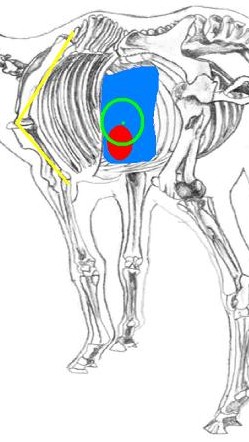
| In the above example, many hunters advocate to shoot for the furthest leg, which
is still acceptable. It is slightly risky in that if you pull to the right, you
may only hit one lung.
When animals have their nearest front leg in front of the vitals, as with this
springbuck, any shot is risky. You may have the power to break the leg bone, but
it may also cause a deflection of the arrow. This in turn will effect
penetration severely, and may end up with a very long tracking exercise. |
 In the same way a quartering forward shot is considered very risky. The arrow will have to find its way among the major leg bones. Also, if the animal starts to move due to the sound of the bow or arrow, as it crouches to "load" its legs for the jump, these heavy bones close the whole shot window.
In the same way a quartering forward shot is considered very risky. The arrow will have to find its way among the major leg bones. Also, if the animal starts to move due to the sound of the bow or arrow, as it crouches to "load" its legs for the jump, these heavy bones close the whole shot window.
 Full frontal shots are possible. It is however considered very controversial,because the shot window to the heart is very small. You cannot really target the lung from the front, and in any case you would hit only one lung if you do at all.
Full frontal shots are possible. It is however considered very controversial,because the shot window to the heart is very small. You cannot really target the lung from the front, and in any case you would hit only one lung if you do at all.

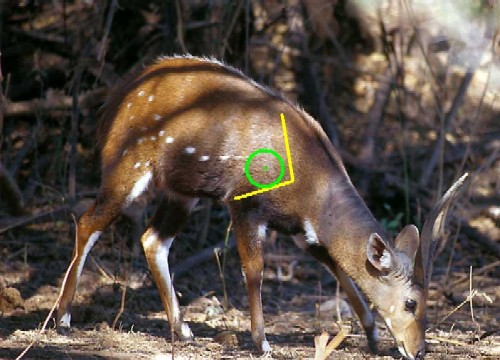
 This would be a cause for a long trek. The smallness of the full frontal shot is due to the breastbone and leg boneson either side of the window, and the neck on the upper side thereof. The vertebrates of the neck is extremely low where it enters the chest, and with a rifle, if you shoot from the front below the animal's mouth, you are most probably going to destroy the lower neck. But with a bow, you have to go for the heart and aorta here. You probably need to be able to shoot a grouping of 1" at the distance of the animal (all categories), before even attempting this. And there is simply no margin for error, so do it only at a very close distance.
This would be a cause for a long trek. The smallness of the full frontal shot is due to the breastbone and leg boneson either side of the window, and the neck on the upper side thereof. The vertebrates of the neck is extremely low where it enters the chest, and with a rifle, if you shoot from the front below the animal's mouth, you are most probably going to destroy the lower neck. But with a bow, you have to go for the heart and aorta here. You probably need to be able to shoot a grouping of 1" at the distance of the animal (all categories), before even attempting this. And there is simply no margin for error, so do it only at a very close distance.
| The animal is also
looking at you,
already making it
risky. And if the
animals should
jump at all at the
bow sound,
remember the small
shot window, you
missed it.
Therefore it is
not recommended at
all.
This kudu also
illustrate another
source for errors
in shot placement,
its chest mane.
This is a serious
source for wrongly
estimating the
chest too low.
Rather use the
elbow or the
shoulder joint as
reference, since
the heart lies
horizontally
between these two. |
 It is important to remember that even though you can shoot far more accurate than the animal's position and vital area dictate is needed, any movement of the animal, and the shot is at least marginal, at most a wound. Recommended distance limitations are defined by the hunter's accuracy, the animal's vital area size, AND the probability of the animal to move. The further the shot taken, the higher the chance the animal moves, the bigger the effect of its movement, and the further it will move before the arrow gets there.
It is important to remember that even though you can shoot far more accurate than the animal's position and vital area dictate is needed, any movement of the animal, and the shot is at least marginal, at most a wound. Recommended distance limitations are defined by the hunter's accuracy, the animal's vital area size, AND the probability of the animal to move. The further the shot taken, the higher the chance the animal moves, the bigger the effect of its movement, and the further it will move before the arrow gets there.
 Tree stand shots (or elevated hides) present the hunter with a new set of shot placement problems. Normally the animal is closer to you than during a walk-and-stalk, and it’s usually at an acute angle. This angle implies you need to adjust the distance used to aim with, and you need to change the spot where you aim. For a very important slant on shotplacement, read "Shooting Distances based on reaction time" again...
Tree stand shots (or elevated hides) present the hunter with a new set of shot placement problems. Normally the animal is closer to you than during a walk-and-stalk, and it’s usually at an acute angle. This angle implies you need to adjust the distance used to aim with, and you need to change the spot where you aim. For a very important slant on shotplacement, read "Shooting Distances based on reaction time" again...
 The best practice for distance measurement at tree stands is to measure first a number of marker objects, from the base of the tree stand, while on the ground. This will give you the horizontal distances. Once you are in the tree stand you use these markers to estimate distance.
The best practice for distance measurement at tree stands is to measure first a number of marker objects, from the base of the tree stand, while on the ground. This will give you the horizontal distances. Once you are in the tree stand you use these markers to estimate distance.
 You also need to lift the spot you aim at slightly, depending on the angle. You should be aiming for the top of the heart, which is basically just below the centre of the chest. The spot you aim at now can even be high up on the rump, passing through the centre, and exiting at the bottom of the chest.It is suggested that you do not aim for the spine, and therefore always aim for the arrow to miss it to either side. Also see "Shooting uphill or downhill", and the effect speed has on accuracy.
You also need to lift the spot you aim at slightly, depending on the angle. You should be aiming for the top of the heart, which is basically just below the centre of the chest. The spot you aim at now can even be high up on the rump, passing through the centre, and exiting at the bottom of the chest.It is suggested that you do not aim for the spine, and therefore always aim for the arrow to miss it to either side. Also see "Shooting uphill or downhill", and the effect speed has on accuracy.
4.5.1 ...from the inside
| Here is an interesting perspective on vital area diameters. These animals were
frozen and cut into half. This provides us with the position and size if vitals
organs. Just as animals differ on the outside, the precise position and form of
the internal organs also shows some variation. |
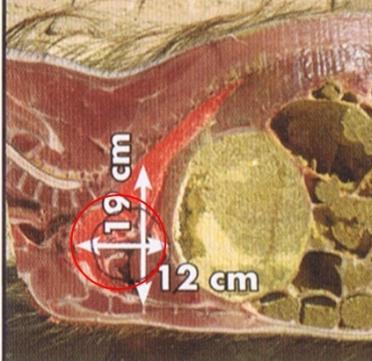 | Although warthogs are placed into category 2 due to their toughness, they must definitely be treated as category 1 for the purpose of accuracy. |
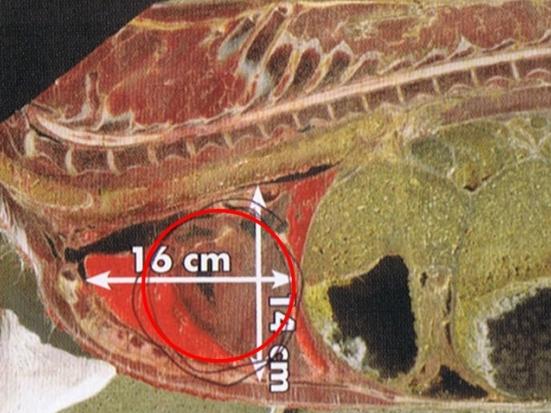 | Here we look at a category 1 animal, a Springbuck. Its vital area is about 5.5" at its narrowest. |
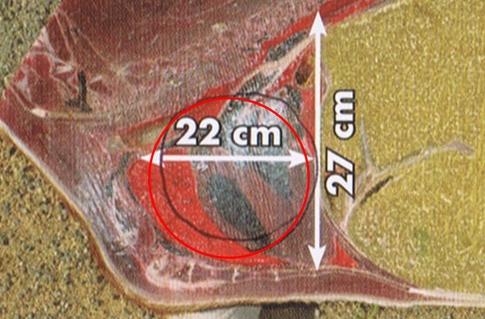 | Blesbuck, with a vital area diameter of 8.5" |
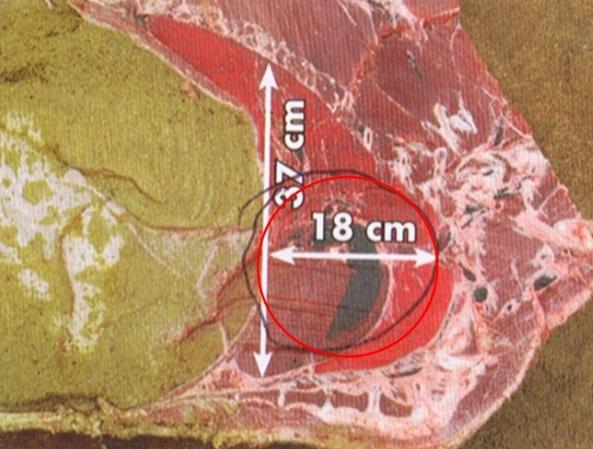 | Blue wildebeest, with a surprising 7". This is smaller than expected. |
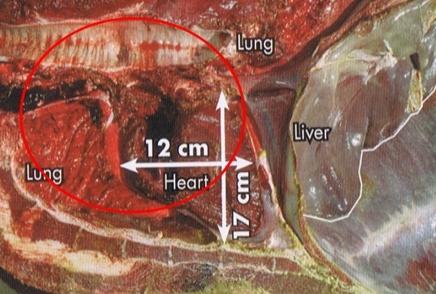 | And here we have a kudu, also about 7". |
| Although these are interesting studies, one photo does not represent a specie.
We do not know the age of these animals, nor does the exact cut through them
looks like it cut throught the middle.
Of course, you can't cut the animal right through the middel and cut any
lungs...
Intersting, but not that imformative. |
Further Reading: Cleve Cheney, AB&A, Mar 2008, p8, "In the Zone"
Willie Oosthuizen, AB&A, Jul 2007, p17, "Shot placement for trophy purposes"
David Guthrie, AB&A, Jan 2007, p10, "The G-Shot"
4.5.2 Accuracy
| The first thing about accuracy is arrow weight. You can ask the question, how
close do my arrows need to be matched for weight, to shoot within 0.5 inches of
each other? Here is a simple equation with which to calculate this:
dW = 2.(m+100).H.V2/(S2g).
m is the arrow's mass, H the acceptable drop, V the speed, and S the distance.
However, the answer is mostly dependent on how far you plan to shoot. If you
shoot 20Y, your arrows must be within 18gr. If you shoot at 50Y, they must be
within 3gr. Olympic archers shooting at 120m must have arrows that is within 0.5
gr. |
 The bigger a broadhead, the more it is likely to plain, or steer the arrow, and thereby making it unstable. Broadheads shoots larger groupings than field points. This is why SABA requires accuracy assessment and 3D competitions to be done with broadheads. Many broadheads have cutouts in the blades. These help to reduce the surface area of the blade which contributes to less plaining, and less penetration friction.
The bigger a broadhead, the more it is likely to plain, or steer the arrow, and thereby making it unstable. Broadheads shoots larger groupings than field points. This is why SABA requires accuracy assessment and 3D competitions to be done with broadheads. Many broadheads have cutouts in the blades. These help to reduce the surface area of the blade which contributes to less plaining, and less penetration friction.
| In general, when increasing the blade area, fletching area should also be
increased. Some hunters suggest to use even 4x 5" fletches on 4 bladed
broadhead. Of course, the better the bow is tuned, i.e. the straighter the arrow
leaves the bow, and the quicker it stabilizes, the better the grouping you will
get with broadheads. Lighter arrows also stabilize more quickly than heavier
ones. |
 Bad groupings with a particular broadhead usually reflect on the broadhead and arrow stability. More fletches may help, and increasing the angle of the fletching may help. Changing the spine or FOC may also help.
If you find that the grouping does not change, but the broadhead shoots consistently off target,the problem can usually be corrected with bow tuning.
Further Reading: Sampie Stofberg, AB&A, Mar 2009, p42, "Wanneer om te skiet"
Bad groupings with a particular broadhead usually reflect on the broadhead and arrow stability. More fletches may help, and increasing the angle of the fletching may help. Changing the spine or FOC may also help.
If you find that the grouping does not change, but the broadhead shoots consistently off target,the problem can usually be corrected with bow tuning.
Further Reading: Sampie Stofberg, AB&A, Mar 2009, p42, "Wanneer om te skiet"
Herman Brand, AB&A, Nov 2008, p57, "Stop en Verbeter"
Sampie Stoffberg, AB&A, Nov 2008, p57, "Jaagskote in die Jagveld"
Seppie Celliers, AB&A, Mar 2008, p54, "Maklike oefen tegnieke om gou beter te skiet"
John Dudley, AB&A, Jan 2008, p15, "Curing buck fever and target panic"
Seppie Celliers, AB&A, Oct 2006, p51, "Hoe kan ek beter skiet? (Part 1)"
Seppie Celliers, AB&A, Nov 2006, p50, "Hoe kan ek beter skiet? (Part 2)"
Seppie Celliers, AB&A, Dec 2006, p49, "Hoe kan ek beter skiet? (Part 3)"
Johan Smit, AB&A, May 2007, p30, "Oorkom plukskiet"
John Dudley, AB&A, Sep 2007, p38, "Maximizing you hunting accuracy"
John Dudley, AB&A, Oct 2007, p25, "Shooting Accurate Constantly"
4.5.3 Estimating Ranges
| Although it is highly recommended to use a rangefinder, the following techniques
may come in handy if the battery goes down, or the device fails... Always bear
in mind that you can for any technique simply divide the distance into two, and
estimate the nearest half’s. Double it then for the whole distance. |
4.5.3.1 Ground Distance estimation
| Learn to estimate a particular distance, say 10y, on the ground, towards the
target. The technique is then simply to count how many times it fits into the
total distance. You can also estimate multiples of 10 and then 20 yards, etc.,
and get the average.
|
Disadvantages:
· The terrain must be straight (not necessarily level).
· Bushes and lighting will influence the estimation.
· You need a clear ground view up to the target.
Advantages
· Very simple and intuitive
4.5.3.2 Angle Cards
| These cards are marked with the apparent height of 1m at various distance
intervals, when the card is viewed at a particular distance.
Reading the marking corresponding to the object’s apparent height, and
multiplying it with the mark value and actual object height, gives the desired
estimate.
A butt at 1.2m high, viewed to correspond with x20, holding the card at 75cm, is
1.2m x 20 (24m) away.
To simplify the maths a bit, you can estimate the distance of an imagined 1m or
yard stick, standing at the target. The factor on the card then corresponds
directly with the distance.
If the height is unknown, this procedure is only as accurate as your estimation
of the object’s height, or an estimation of the height of 1m, at that distance.
Of course, the markings get closer to each other the further you go, and the
system becomes less accurate. For angle cards to work you need to either know
how high an object
at the target (or the target itself) is, or you have to be able to estimate the
its height.
|
Disadvantages
· Accuracy beyond 40m is difficult
· Must know or estimate height or width of target
· Less intuitive
Advantages
· Ground towards target can be uneven or even hidden
· Cover and lighting has little influence
4.5.3.3 Using your Thumb
| This technique inverts the "angle cards" idea. Instead of comparing the apparent
height with various pre-marked heights, we use the number of times a
known/estimated distance at the target’s position, fits into a single pre-marked
distance.
Your thumb should be exactly 1 inch wide. Well mine is. The idea is that if you
hold it at arm's length, 75cm, or 30 inches. You then take the estimated/known
height of the object, multiply it with the number of times it fits underneath
your thumb and multiply that with 30.
For example, if a butt is 4 feet high, and two fits underneath you thumb (arm
straight), then the distance to it is 4feet x2 times x30 = 240 feet (80 yards).
Working directly with yards, since 1 yard = 3 feet, 4x2x10=80 is easier. You
could also imagine a meter or yardstick at the same distance: it would fit 2.6
times underneath your thumb: 2.6times x30=80 yards.
|
Disadvantages
· Must know or estimate height or width of target
· Can involve some mathematics
Advantages
· Ground towards target can be uneven or even hidden
· Cover and lighting has little influence
· Moderate accurate at distance
4.5.3.4 Using a Ruler
| Basically the same technique as the thumb idea above, but with the ruler you can
impress more suckers, wink-wink.
Take a 10" rule in your right hand. Put the end against your forehead, so as to
measure a hand position 10" in front of your eyes. Turn the rule vertical,
keeping your hands level and at 10" from your eyes.
Use your left thumb, or other fingers an any way, to measure 1 inch vertically,
from the zero. Hold this 1" vertically, right next to the rule, with it’s base
at 0".
Now tilt the rule forward towards the target, still keeping it 10" from your
eyes, and still keeping a 1" finger mark vertically above the zero. Tilt the
rule forwards until it’s 1" measurement is in line with a known/estimated height
at the target. Now read how far your left hand’s finger’s 1" (still vertical)
mark projects onto the ruler, multiply by 10, and then the height of the object
you sighted on (an imaginary yardstick can help again). You could of course use
anything with at least 10" marked on it (an arrow comes to mind).
Note, the rule is only there to measure 10", 1" and how many times 1 yd (or a
known size) at the target fits into the 1". So if any rules forbid the use of a
ruler (to "measure" the distance, ha, ha) then all you really need is a 10"
marker (your thumb is 1" thick, and you can estimate how many times your thumb
covers it).
|
Advantages
· More accurate than estimating number of times target is covered by thumb
Disadvantages
· carrying a ruler
· a bit complicated
4.5.3.5 Measured apparent size at 10m or 10y
| Another adaptation to the above technique is possible when shooting 2D targets,
since they are printed on the same size paper! Walk up to 10yd away from the
target, and hold up your bow at shooting length. The target will fill a certain
width and height inside the sight, or on the riser. Make a mental note thereof.
Now walk back to 20 yd. Aim again at the target. You will now see that exactly 2
targets fits into this gap.
At 30 yd, you’ll be able to fit 3 targets therein. And so on. When hunting, you
could use the average height of the animal as a point of reference.
This technique requires that you measure the width, and later use it, at the
same distance from your eyes. But since the specific distance is not relevant,
your individualized arm’s length would do nicely.
|
Advantages
· Very accurate, even to 50m or yards.
· Using the width can neutralize uphill/downhill distance estimation errors
· Very easy to use
Disadvantages
· You have to measure the target’s width at 10m(y) before using it
4.5.3.6 Known size / 100
| There are two variations of this technique. They are very similar to the
previous ones, but with slightly different accents, and can come in handy to
cross check each other. These techniques also start with a known or estimated
target size. But instead of using a fixed width a particular distance, use 1/100
of the target’s size.
The two variations involve using the "mask" at either a fixed distance from the
eyes and counting how many times the target can fit underneath it, or moving the
mask until exactly one target fits underneath it.
Let's take the fixed distance first. Say a target/animal is 1.2m high. Make a
mask of 1,2 cm, which is the same as 1.2m/100. At a fixed distance of 10cm from
your eyes, you can count the number of times the target fits underneath the mask
(in the gap). Let's say it’s about 1.5 times. Multiply this with 10, and you
know the target is at 15m.
If you knew the size of the target in inches, a mask of 1/100 thereof must be
place at 3.6" from your eyes, to give after x10, an answer in yards.
The second version of this technique is a bit more intuitive and easy.
Again start with a mask or gap that is 1/100’th the size of the target. 1m would
translate to 1 cm.
But now you place it at a distance such that exactly 1 target fits under/inside
the mask/gap. Say this is 25cm (measured or estimated). The target is then 25m
away.
For this technique, you could translate a target size of m to cm, or yards to
inches.
The only problem with yards to inches is that you may need to hold the mask at
40" for a target that is 40y away.
|
Disadvantages
· More complex
· You need a ruler - more equipment
· else, you need to be accurate in estimating small distances close up.
· Need to know or estimate the target’s size
Advantages
· Fair accuracy at bigger (40 to 50y) distances
· Don’t need to measure the target sizes at 10m/y beforehand.
4.5.3.7 Parallax
| This is an easy technique. Take a pencil, or even a sight’s pin, or field point.
Hold this at arm's length right in front of you (about 65 cm). Now look with
both eyes, at the target.
Estimate the distance on the ground, at the target, that separates the two
images formed by your two eyes.
Lets say it’s 2y. For an average eye width of 65 mm, and a pin at 65cm, this
factor calculates to 10. So the distance is 10x2 yards.
If the distance on the ground is becoming 4 to 5 yards, it becomes difficult, as
you may not be able to see such a stretch at the target. For this you can use
two pins, and arrange them to see 4 evenly spaced images when looking at the
target. Estimate the distance the centre two projects to at the target, and
multiply with 20. |
Advantages
· Only one estimation is done, albeit at a distance
· Quick and easy
Disadvantages
· You have to see some ground at the target’s feet
· Estimations at distances influenced by lot of factors.
| Many of these techniques require you to estimate a distance at the target, or
close to you. The ones that are close to you will be more accurate. If you need
to estimate more than one distance for a technique to work, it of course becomes
less accurate.
All things considered, I opt for knowing the apparent size at arm’s length, for
the target standing 10 yards away. The number of times it fits into the gap x10
is an easy/accurate estimate.
Be careful of uphill and downhill estimations. If you use techniques dependent
on target height, you are doomed to getan estimate that is too far. Instead,
consider using target widths to cancel elevations. Just tilt the whole procedure
on its side.
Widths are totally unaffected by up or downhill shooting! On the other hand, if
a target width is used, and it stands at an angle towards you, it will also
create problems.
Of course, shooting up or downhill comes with its own problems...
|
4.6 Camouflage
 Camouflage for bowhunters plays an important role for the walk-and-stalk, and ambush bowhunter (less so for using hides). This hunter needs to get very close to animals without alerting them to his/her presence. For effective camouflage the hunter needs to take various aspects into account: movement, shadows, silhouettes, shape, surface, symmetry, size, situation, sound, and smell.
The biggest problem with camouflage is the better you do it, the more limiting it becomes. The more you blend in with bush, the more you stand out in grass, etc. Even camouflage for a non-moving (ambush/hiding) hunter and a moving hunter (walk and stalk) has opposite goals.
Camouflage for bowhunters plays an important role for the walk-and-stalk, and ambush bowhunter (less so for using hides). This hunter needs to get very close to animals without alerting them to his/her presence. For effective camouflage the hunter needs to take various aspects into account: movement, shadows, silhouettes, shape, surface, symmetry, size, situation, sound, and smell.
The biggest problem with camouflage is the better you do it, the more limiting it becomes. The more you blend in with bush, the more you stand out in grass, etc. Even camouflage for a non-moving (ambush/hiding) hunter and a moving hunter (walk and stalk) has opposite goals.

| Any movement is very easily seen by all animals.When moving in the field, do it
as slow as possible. When very close to your target, try to move only parts of
your body at a time. It is of such importance that the lack of any movement
becomes an ambush - which is so effective that some hunters feel it's not
ethical! The best pattern that hides movement is no pattern at all. A single
natural colour or a large low contrast pattern with blurred edges works better
for a moving hunter. Smaller sharp edged, high contrast patterns work best for
an ambush hunter.
The role of shadows is usually underestimated. All colours in shadows become
black. Your best and most expensive colour patterns all become dark grey if you
are sitting inside a shadow. If the sun is to your back, your front is in
shadow, and loses its colour. Likewise if it shines on your front, the
camouflage pattern is most prominent.
Shadows work in concert with silhouettes. You should look at the background of
where you are, it is either lit or in shadow. If you are not similarly
lightened, you stand out as a silhouette, and any movement is easily seen.
The silhouette defines your outline, or shape. Another aim of camouflage should
be to break the hunter's shape. The use of high contrast on edges, as seen from
a particular direction, is most effective. However, the moment you move, they
become more visible.
The surface of an object seen with just one eye, as most animals will see you,
is mostly defined by the shadows thrown on it. At the same time protruding parts
are usually well lit, and any sweat or oily skin on it will shine very
prominently.
When applying face paint for camouflage, protruding parts should be coloured as
if they are indentations, and the reverse.
Likewise shadows falling on a round object are usually round, and straight on a
flat surface. Therefore to hide your surface features, you should have shadows
on it that contradicts the real form.
Another aspect of the pattern that works well is one that has detail at various
sizes. Typically, for the animal to see you as a threat, he must combine what he
sees of you into a single "creature". If you are, as the images of such
camouflage suggests, you are "close" and "far", you can't be assimilated into
one creature, and therefore cannot be "seen".
In further breaking you apart, some of the camouflage should reflect the
foreground, and some should reflect the background. This situates you at
various distances. A patch of sky seen through the bush creates an empty
space...
The big advantage of the newest so called digital patterns is that they can
create diffused borders between colours, cheaply. These diffuse borders make it
more difficult to focus on and therefore to do ranging. The animal picks up
depth by means of focus (as it sees you with 1 eye), and if it can't focus on
you, you are not something.
The last two things we mention is sound and smell. Animals can hear and smell
vastly better than humans can. Always move slowly, against the wind. Wash with
unscented soap, and use unscented deodorants.
One of the single biggest morphological features of animals is symmetry. All
vertebrate animals are bilateral symmetric.If you are not symmetric, you can't
be an animal. Try to break the symmetry of your apparel’s left-right sides. If
you took two different shirts, cut them diagonally and make two new shirts, you
may just laugh the last.
|
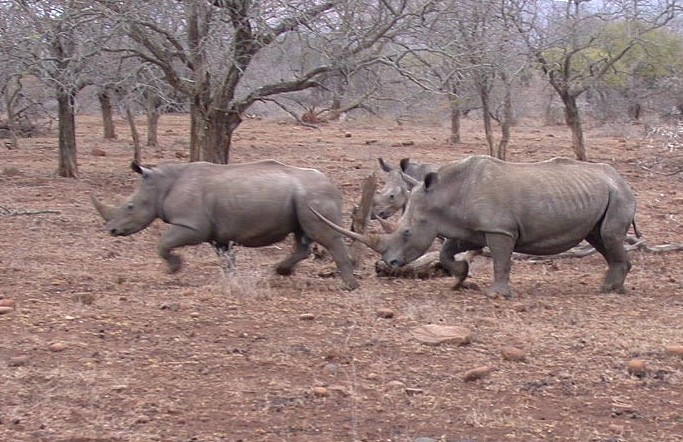
| Never confuse camouflage for combat, with that for hunting. Although they can
look similar, never judge them with a human eye. Check the patterns at 100 to
10Y. It should stay blotchy and fragmented, and never become a blob of a single
colour.
As a last word on camouflage, the best all purpose everywhere camouflage makes
you look like something very well known, totally benign, and that's everywhere -
a rock. If you walk through the field, how much attention do you apply to rocks?
You are always looking at bushes, what's in them, behind them, and as for rocks,
at most what's behind them.
|
Further Reading: Herman Brand, AB&A, Aug 2008, p17, "Become invisible"
Harry Marx, AB&A, May 2008, p58, "Fashion and the hunter"
Harry Marx, AB&A, Jul 2008, p58, "Fashion and the hunter"
Cleve Cheney, AB&A, Oct 2007, p20, "Fooling Animal eyes - Part 1"
Cleve Cheney, AB&A, Nov 2007, p20, "Fooling Animal eyes - Part 2"
Cleve Cheney, AB&A, Dec 2007, p20, "Fooling Animal eyes - Part 3"
Cleve Cheney, AB&A, Jan 2008, p20, "Fooling Animal eyes - Part 4"
Herman Brand, AB&A, Oct 2007, p49, "Wat bokke sien"
Peter Netland, AB&A, Jun 2007, p15, "Human scent and the African bowhunter"
Engee Potgieter, AB&A, May 2007, p57, "How quiet is your bow?"
Cleve Cheney, AB&A, Sep 2007, p14, "Bushcraft: Winning the scent war"
4.7 Waiting Times
 The time you wait before you start tracking an animal is based very much on the shot placement. You should wait at least 15 minutes for a well placed heart or double lung shot, however even 30 minutes is not overdoing it. For a liver or gut shot, you should wait at least an hour before tracking starts. However, some hunters wait even 3 hours before starting.
The time you wait before you start tracking an animal is based very much on the shot placement. You should wait at least 15 minutes for a well placed heart or double lung shot, however even 30 minutes is not overdoing it. For a liver or gut shot, you should wait at least an hour before tracking starts. However, some hunters wait even 3 hours before starting.
 When tracking the shot animal, do it as if you are stalking it - very slowly, and carefully. This is not only for safety for you and your PH or guide, but also should it still be alive, and only resting a bit, a noisy tracking party can scare it into the next farm. The old hunters know it's the dead ones that kill you, or that run the furthest...
The best is to wait longer, and even longer when you are unsure of the shot.
When tracking the shot animal, do it as if you are stalking it - very slowly, and carefully. This is not only for safety for you and your PH or guide, but also should it still be alive, and only resting a bit, a noisy tracking party can scare it into the next farm. The old hunters know it's the dead ones that kill you, or that run the furthest...
The best is to wait longer, and even longer when you are unsure of the shot.
4.8 Following a spoor
| There are long and beautiful stories of trackers, and how with the faintest of
evidences, they can tell you not only where the animal went, but the particular
type, male/female, age, temperament, and of course, where they headed. If only
we could write down the skill ...
|
 There are only 2 rules when it comes to tracking. The first rule is never walk on the spoor. Walk to the side of it. And if you have a whole group of spectators, keep them way back of the tracking. The dust for your shoes can disturb and hide evidences.
The second rule is to leave it to the expert tracker, or tracker dog, to do the job. You can follow them at a few paces, and for educational purposes also try to see the track.
Sometimes a track or bloodspoor is lost. Don't panic.Sit down, take a deep drink from the water bottle. The tracker will circle around the last spot in an ever growing spiral, and soon pick it up again.
There are only 2 rules when it comes to tracking. The first rule is never walk on the spoor. Walk to the side of it. And if you have a whole group of spectators, keep them way back of the tracking. The dust for your shoes can disturb and hide evidences.
The second rule is to leave it to the expert tracker, or tracker dog, to do the job. You can follow them at a few paces, and for educational purposes also try to see the track.
Sometimes a track or bloodspoor is lost. Don't panic.Sit down, take a deep drink from the water bottle. The tracker will circle around the last spot in an ever growing spiral, and soon pick it up again.
| Blood when dried becomes brown. Small spots of blood dry within a minute of two
in the hot sun. So you should be looking for brown and red. The blood normally
is more smeared against the grasses and bushes as the animal walks, unless of
course the bleeding is profuse. The blood gets caught up in the hair much like
paint in a paint brush.
Blood has different colour and consistency. Light red, frothy blood is
indicative of a lung shot. Light, bright blood is usually arterial blood - a
good sign. Dark blood is deoxygenated blood, either coming from the body or
internal organs, and indicative of a liver, or body shot. It can mean you are in
for a long trek. Watery blood, with stomach contents is a bad sign - indicative
of a gut shot. It IS going to be a long trek. If the whole arrow has blood on,
it’s usually a sure sign of a pass through, and usually a good blood spoor.
Antelope and dog blood clots on the ground generally within minutes, while pig
blood clots in 3.5 minutes and equine blood (horses, zebras) in 11.5 minutes. |
 Always remember, it is not the tracker's responsibility to find your trophy - he is doing you a favour. Respect him and show gratitude... and he may just make it his responsibility.
Always remember, it is not the tracker's responsibility to find your trophy - he is doing you a favour. Respect him and show gratitude... and he may just make it his responsibility.
 There is a whole bunch of other rules too, but it's more a case of survival than tracking. Never assume a dead animal to be safe - they are the ones that kill. Never think they are too small to hurt you, or too large to move fast enough. Always keep your eyes open for any other game in your surroundings. With bowhunting, most of the animals will not even know your there - keep it that way. Never assume the animal is dead - the dead ones run the furthest. Do tracking like you would do a walk-and-stalk: slow, looking around, and silent.
Further Reading: Cleve Cheney, AB, Nov/Dec 2000, p23, "Principles of Tracking - Part 2"
There is a whole bunch of other rules too, but it's more a case of survival than tracking. Never assume a dead animal to be safe - they are the ones that kill. Never think they are too small to hurt you, or too large to move fast enough. Always keep your eyes open for any other game in your surroundings. With bowhunting, most of the animals will not even know your there - keep it that way. Never assume the animal is dead - the dead ones run the furthest. Do tracking like you would do a walk-and-stalk: slow, looking around, and silent.
Further Reading: Cleve Cheney, AB, Nov/Dec 2000, p23, "Principles of Tracking - Part 2"
Cleve Cheney, AB, Jan/Feb 2001, p17, "Principles of Tracking: Interpreting Sing - blood trailing - Part 3"
Cleve Cheney, AB, Mar/Apr 2001, p18, "Principles of Tracking: Interpreting Sing - identification of tracks (mammals) - Part 4"
Cleve Cheney, AB&A, Mar 2008, p74, "A Tracking Notebook"
Cleve Cheney, AB&A, Feb 2008, p66, "Tracking by sound"
Cleve Cheney, AB&A, Jan 2008, p74, "Mud Tracking"
Cleve Cheney, AB&A, Nov 2007, p74, "Following a blood trail (Part1)"
Cleve Cheney, AB&A, Dec 2007, p74, "Following a blood trail (Part2)"
Cleve Cheney, AB&A, Oct 2007, p74, "Tracking: ageing sign - scats"
4.9 Caping
Further Reading: Kobus Potgieter, AB&A, Jun 2007, p30, "Slag jou trofee reg af"
Cleve Cheney, AB&A, Feb 2008, p20, "Field dressing a carcass"
Cleve Cheney, AB&A, Mar 2008, p20, "Skinning your trophy for a shoulder mount"
4.10 Ethics
| There are much written about ethics, and SABA will not say the last word on it.
But we (SABA) want to start a process wherewith the bowhunting community can
develop a mature and complete education on all aspects of bowhunting, ethics
included.
Sometimes ethics is very simple, and most of the times very complicated.
Definitely, ethics is subjective, and each hunter has a different view on the
specifics.
For example to define one of the most central and common dilemma, a "fair
chase", is greatly dependent on the hunter's tools and skills. A seasoned
walk-and-stalking bowhunter may see the hunter using a rifle with a scope, who
can shoot a head shot at 200m, as unethical - as there is absolutely no chase
involved. Likewise someone sitting in a hide can be seen as hunting "unethical"
if we require "a fair chase". Likewise, what about from a tree stand, or from
behind a bush? Or should we actually be allowed to use camouflage? All these and
many other issues are woven around a central concept - they are about practices
that make it easier for the hunter to kill. Perhaps a bushman of long ago who
have seen today’s bows, would shudder in his grave - where’s the hunt?
Rifle hunters also just shake their heads in disbelieve. Why would anybody want
to shoot with something that needs to be pulled with 70 pounds that you can only
shoot at over short distances, etc? To them this bowhunting thing seems like we
are trying to make life difficult for ourselves. It is purely a matter of
perspective. Many years ago we hunted with rifles from horseback. Today it is
illegal to hunt from a vehicle.
Therefore neither SABA nor probably anybody else can define "a fair chase". A
really fair chase is probably only when you have to run down your quarry, and
bite it to death.
But this discussion hints to an underlying principle. Perhaps the reason for the
dilemma in these examples is because the fair chase has nothing to do with
ethics? |
 Hunting ethics should be concerned with the following principals: Hunting ethics should be concerned with the following principals:
1) The targeted animal should experience the least amount of pain, and die as quickly as possible with the least stress.
2) It should be hunted without being a danger to any other animals or people (including you)
3) It should be by legal means. |
| If we all can accept these points, we need not have any argument on ethics.
Anything that is not solved by referring back to these principles, becomes
opinions, and is subjective, and most probably will change in time and among
cultures as well. Then a "fair chase" lies outside the scope of ethics, and
becomes one of opinion.
Rean Steenkamp, editor of the African Bowhunter and Archer, has the following to
say:
"Hier is daar twee goed wat teenmekaar opgeweeg word, naamlik etiese jag en
"fair chase". Om met 'n boog 'n dier te bekruip is meer "fair chase" as met 'n
geweer, maar minder eties. Jy kan tog meer sekuur skiet met 'n geweer en 'n
teleskoop. En die geweer bied meer skote op die bok. Kanse om droog te maak met
'n loop-en-bekruip jag is ook meer as vanuit 'n skuiling skiet. Skuilingskiet is
dus meer eties, maar minder "fair chase"."
This illustrates the difference between ethics, opinion and a fair chase. The
most important implication of these principles is that you have to shoot
accurately, not with marginal or inferior equipment, and only if a safe and sure
shot is available. This applies to ALL types of hunting.
Just one small definition before we continue, when is an arrow shot a wound, and
when not? Wounding is when the animal does not die due to loss of blood pressure
(blood loss due to internal or external bleeding, or heart failure),
asphyxiation (internal bleeding into the lungs), direct neural damage (spinal or
brain shot), or cutting off the blood supply to the brain (severing for example
carotid arteries). |
 Before even ethics come the rules of bowhunting. These are simple and leave very little to interpretation.
1) The hunter must know what he/she wants to hunt, and make sure their equipment is adequate.
2) The hunter must be able to demonstrate groupings that support the distance he/she holds forward to hunt a particular species.
3) The hunter must know what species and gender are available, and which are not.
4) The hunter must know and follow the farm rules.
5) No head shots and no shots from directly behind an animal.
6) No alcohol before or during the hunt.
7) If your arrow drew blood, you pay for the hunt.
8) You pay for what you shot, not what you thought you shot.
Before even ethics come the rules of bowhunting. These are simple and leave very little to interpretation.
1) The hunter must know what he/she wants to hunt, and make sure their equipment is adequate.
2) The hunter must be able to demonstrate groupings that support the distance he/she holds forward to hunt a particular species.
3) The hunter must know what species and gender are available, and which are not.
4) The hunter must know and follow the farm rules.
5) No head shots and no shots from directly behind an animal.
6) No alcohol before or during the hunt.
7) If your arrow drew blood, you pay for the hunt.
8) You pay for what you shot, not what you thought you shot.
| On these last rules: SABA supports the very old and universal rule, if you draw
blood, you pay. There is no responsibility on the farmer’s side, or the PH, or
the manager, to find the animal you shot. It was your decision to hunt there,
and you must have inquired on the policy of the farmer, if they have good
trackers, perhaps trained dogs, etc. If you shoot and there is blood on the
scene, you must pay. Likewise if the carcass is only found the next day and
there is not much left. It is the right of the farmer to refuse you any further
hunting or even access to his land, if you do not follow this rule. Likewise, if
you feel you were not treated well, it is your right to hunt elsewhere. And if
you want to shoot an Oryx and the guide/PH or whoever is with you, say go, and
it’s a sable antelope, you pay. If you respect these people, their animals and
their rules, they will make it their responsibility to find your trophy. |
 SABA also supports what can be called good hunting manners:
1) Inform the farmer on the equipment you use. Even the colours of your fletching come to mind.
2) Declare the arrows you take to the hunt, and those you return with.
3) Demonstrate accuracy, and do a few practice shots each day.
4) Discuss shot placement with the farmer or PH, they may have very valuable experience in this regard - never think you know more than they do.
5) When taking photos try to limit the amount of blood. It just creates a nicer picture that way.
6) When you write an article on a hunt, don’t praise yourself. Praise the animal. It died for you.
7) Realize the privilege, and not the right to hunt.
8) Be prepared - you are there to hunt - your set-up should have been done long ago.
SABA also supports what can be called good hunting manners:
1) Inform the farmer on the equipment you use. Even the colours of your fletching come to mind.
2) Declare the arrows you take to the hunt, and those you return with.
3) Demonstrate accuracy, and do a few practice shots each day.
4) Discuss shot placement with the farmer or PH, they may have very valuable experience in this regard - never think you know more than they do.
5) When taking photos try to limit the amount of blood. It just creates a nicer picture that way.
6) When you write an article on a hunt, don’t praise yourself. Praise the animal. It died for you.
7) Realize the privilege, and not the right to hunt.
8) Be prepared - you are there to hunt - your set-up should have been done long ago.
| SABA requires as part of their proficiency program, for hunters to actively
practice and partake in competitions.
And lastly SABA wants all hunters to have done a proficiency certification,
preferably of course SABA’s, but definitely at least any.
Here are a few easy and not so simple situation and opinions regarding hunting
practices:
a) There is another animal standing behind the one you want to shoot.
This clearly violates the safety principal. If you have adequate
equipment and places a good shot, there is a huge probability that the arrow or
bullet will pass right through the targeted animal, and wound the one behind it.
If there is no chance of a pass through, you are maybe using a marginal set-up,
which violates the death principal.
b) There are grasses or twigs in front of the animal you want to shoot.
This would clearly violate your chances of a sure shot, would it not?
Especially if you are using mechanical hunting points, as the grasses can cause
the blades to open prematurely, and unbalance the broadhead, leading to wounding
the animal. Using a heavy hunting point with very heavy arrow, say 800gr, and a
target at 10Y, the effect of a small blade of grass can be questioned. In this
case we are clear that the death principle is involved, but the degree of
violation is in question.
c) The animal is moving.
The arrow is going to take roughly between 0.2 and 0.4 seconds to get to
the animal. If the animal decides to stop when you release the arrow, you could
miss or wound it. Worse, the arrow will be travelling at an angle towards the
animal, which may impede penetration. Remember when it walks it also moves up
and down, and its leg bones changes position. Most bowhunters consider shooting
at a walking animal as unethical as there is a chance of violating the death
principle.
d) Shooting across the wind.
Even if you practiced shooting across a strong wind, and can adjust the
sight precisely to compensate, the arrow will hit the animal at an angle. This
angle SEVERELY impedes penetration. You can test this easily on a butt. It's the
same effect you get when you hit a nail with a hammer, and the nail is not
perpendicular to the hammer's stroke - you end up with a blue thumb and zero
penetration. This issue is to what degree is the death principle being violated.
e) Very alert animals, or animals looking at you.
This increases the animal's readiness to jump. It means that the
reaction time we thought to be safe is now totally inadequate. A sure shot is
highly unlikely. There is therefore a chance of violating the death principle.
f) The animal is standing towards you, or away from you.
Texas heart shots do not work for bow hunting. No further discussion.
Frontal shots require extreme accuracy. And even if you shoot a perfect
shot, and the animal moves 1", you could end wounding it. The average bowhunter
should not consider this shot. Here is a high probability of violating the death
principle.
g) A female animal (cow, ewe or sow) is with dependent young.
Killing it will cause suffering and death to dependent young. This will
be a direct violation of the safety violation - safety to other animals.
h) The animal is on top of a hill.
Even with, and especially with a perfect hit, a possible pass through
can wound or injure anything behind the hill. Even if you know there isn't a
little village within 1000Y behind the hill, there may be a whole gathering
today. Remember that arrows have been shot in access of 1000Y! Therefore a
possibility exists of violating the safety principle.
i) From a vehicle, from a tree stand, from a hide?
None of the listed ethical principles are broken by doing this. The
basis on which people decide the acceptability of these practices is again the
"fair chase" issue. Many years ago we hunted from horseback. Likewise what about
distance, would it be fair to shoot an animal with a sniper's rifle at 500m?
Perhaps you say the hunting technique is not the factor defining a "fair chase",
but the skill of the hunter needed to do the hunt. But what happens if you could
shoot a 4" grouping with a bow at 100Y? Would it not be for you "unfair" to hunt
at a mere 20Y? The same amount of shooting skill is needed whether you shoot
from a hide or a when stalking. When stalking, additional skills are needed.
This is therefore seen as a matter of opinion, and not of ethics. The
more ethical (safe and sure) the shot becomes, the less of chase it was.
j) Hunting at a waterhole / feeding point / with bait
This is again the "fair chase" issue. See item (i) on this. Using bait
for hunting cats is currently illegal. Hunting cats is currently illegal,
without special permits. We can probably all agree that "canned" hunting
involves no chase, but is it unethical? It is also very difficult to draw a line
where the "can" ends and "fair" begins. Is it acceptable to throw veggies for
bush pigs, but not a leg of lamb for a lion?
Therefore it becomes an opinion, and not an issue of ethics.
k) Using a rangefinder:
You can argue that using a rangefinder degreases the "fairness" of the
chase, or that it decreases chances of wounding the animal. Almost all
bowhunters are not able to judge distance within the limits needed by
bowhunting. Therefore it is recommended that you always use a rangefinder or
another method to determine ranges to within required limits.
A typical hunting arrow has a speed of 250 fps. For an Impala, with a
vital area diameter of about 4", and using 1" as a safety factor, you are
allowing only 1" above and below your grouping size. For your grouping to use up
the whole safety margin your estimation only have to be out by 32" at 20Y, 21"
at 30Y and 18" at 40Y. This implies that if you want to hunt safely and surely
an Impala at 40Y, you need a rangefinder that can measure distance to at least
0.5Y accurately.
It is therefore proposed to be unethical to hunt without it - there is a
chance of violating the death principle.
l) To hunt with a very low poundage bow.
Every now and then we hear how an animal was shot with a 24lbs or so
bow. This can be done. A knife can kill a buck. But the chance of this not
succeeding is great. If the hunting point is not extremely sharp, and selected
with maximum penetration in mind, and it glances of even a smallish bone, it can
mean a horrible experience for the hunter and the hunted. SABA and the rest of
the bowhunting community would not want to exclude children, women, traditional
hunters and people with disabilities, from hunting if they are so inclined.
However, the reality is the bigger the chance you take, the bigger the
probability to fail, and the stronger opposition there will be against the whole
of hunting when you do. Minimum requirements are a necessity for bowhunting if
it should continue to exist as a lawful way to hunt.
It creates a degree of violation of the death principal when not
adhering to recommendations based on sound hunting practice.
m) Low light conditions
At first glance this does not break any of the principles. However, if
you wanted to hunt a male steenbok, and ends up shooting a male duiker, you
could be in serious problems. Mistakes on gender are extremely easy where both
sexes have horns, for ex. Oryx (Gemsbok), Blue-wildebeest. And sometimes a farm
rule can be in effect: don't shoot the females, you pay double for them, or
something to that extend. Where the targeted species may be available for
hunting, the shot species may be highly endangered, and it is most probably
illegal to hunt. On second thought, when shooting at an unidentified animal, a
big chance exists for breaking the safety principle. Chances are that if you
could not identify it, you could not see the vital area, and then you violate
the death principle as well.
n) Head, neck and spinal shots
It is quite clear that some none-wounding shots are not considered
"ethical", for example executing spinal shots on purpose. However, such a shot
would in fact lead to a much quicker death, and sometimes a totally painless one
as well. How can such shots be seen as unethical? Very simply, there is a great
probability to miss with such a shot, as the target is very small. The target in
the case of the spinal cord and brain is also protected by strong bones,
creating a probability of not penetrating deep enough. In these cases where the
animal was not killed it would lead to a wound. Therefore even though the shots
would be perfectly effective, they are unethical as the chance of violating the
death principle is too big.
o) Exploding or poisoned points
These practices are illegal. But for argument’s sake, we will ignore
this. It is very much possible to set up an exploding charge in the arrow’s tip.
We also ignore the safety principle for now. It could be set up to be only
strong enough as to impart a systemic shock equal to that of a penetrating
bullet. Would it not then be as ethical as hunting with a rifle? It then becomes
a matter of opinion.
There are various types of "poisons". Some will kill the animal with
pain, some without pain. Some works quickly, some don’t. Some if administered in
a too low dosage will have no side effects, and some will. So clearly, if again
we ignore the legality and safety principles, then we can end up with a chemical
that kills painlessly and quickly, without any after effects if a sub-dosage
occurs. Definitely it becomes a matter of opinion then.
In both these cases however, usage of these methods may lead to the
hunter relying on the chemicals, and not accuracy, to kill. Now it can be a
violation of the death principle for the exploding points, but an opinion for
poisons (they work from anywhere).
Of course both these methods are illegal, due to licensing issues and public
opinion, so they are not ethical.
So in summary, if an act violates any of the ethical principles, it is
unethical. Some acts violate it to a degree, and some acts contain a probability
of violation. In all these cases, the hunter takes the responsibility of his
actions, which can lead from being barred from hunting to legal action. |
 If there is any reason to query the ethics of a shot, query it, for it is probably on the verge of being unethical, and therefore, already so.
If there is any reason to query the ethics of a shot, query it, for it is probably on the verge of being unethical, and therefore, already so.
| One of the biggest issues we just touched is marginal equipment. This subject is
however so large, that it fills almost a whole proficiency program. |
Further Reading: Sampie Stoffberg, AB&A, Sep 2008, p60, "Etiese Jag en boog pioniers"
Dieter Noli, AB&A, Apr 2008, p71, "Canned Hunting"
Dieter Noli, AB&A, Feb 2008, p71, "Should we poison our arrows?"
Cleve Cheney, AB&A, Jul 2006, p37, "The Ethics and morality of bowhunting (Part 1)"
Cleve Cheney, AB&A, Aug 2006, p37, "The Ethics and morality of bowhunting (Part 2)"
Cleve Cheney, AB&A, Sep 2006, p44, "The Ethics and morality of bowhunting (Part 3)"
Cleve Cheney, AB&A, Oct 2006, p45, "The Ethics and morality of bowhunting"
Cleve Cheney, AB&A, Nov 2006, p20, "The Ethics and morality of bowhunting"
Cleve Cheney, AB&A, Dec 2006, p22, "The Ethics and morality of bowhunting"
Cleve Cheney, AB&A, Jan 2007, p34, "The Ethics and morality of bowhunting"
Herman Brand, AB&A, Jun 2007, p29, "Respek"
Anthony C. Ruggeri, AB&A, Dec 2007, p36, "Blinds versus Walk and Stalk"
4.11 Conclusion
| Please take note that although these recommendations are based on hunting
experiences, it does not guarantee a successful hunt. It also follows that it is
possible to hunt successful, although usually not lawful/ethical, by not
adhering to them. Currently the law prescribes some equipment requirements, but
makes no mention of the archer's abilities. The equipment provides penetration,
while the archer provides accuracy, and it is on this point that we base our
recommendations. |
 As best situation, we recommend that the optimum arrow mass always be met. The optimum velocity or momentum as suggested is subject to the hunting point's ability to cut flesh (Ro value). An arrow should ideally exceed the suggested velocity.
As best situation, we recommend that the optimum arrow mass always be met. The optimum velocity or momentum as suggested is subject to the hunting point's ability to cut flesh (Ro value). An arrow should ideally exceed the suggested velocity.

4.12 Some miscellaneous reading
Further Reading: Engee Potgieter, AB&A, Aug 2007, p39, "Take better trophy photos"
Cleve Cheney, AB&A, Oct 2007, p15, "Building blinds for bowhunting"
Louis Stoffberg, AB&A, Jun 2008, p55, "Bou 'n Gawe Skuiling"
Harry Marx, AB&A, Jan 2009, p11, "The cheapest chronograph yet"
Harry Marx, AB&A, Dec 2007, p19, "A 'cheap' Chronograph"
Cleve Cheney, AB&A, Jun 2008, p20, "Bushcraft: Fire"
5 Species
5.1 Species Categories
| The use of any two of KE, mass, momentum and speed, implies the other two as
well. KE and momentum is derived from both and only velocity and mass. Two
different arrows may have similar KE, but one may be unsuitable for hunting due
to low mass and very high velocity. It is therefore mathematical tautology to
use KE and momentum, as it mathematically, and exactly, fixes the mass and
velocity, and therefore a simpler formulation would only have included a minimum
mass and a minimum velocity. Both can be measured, and no mathematical formula
are needed. |
The tables are based on momentum correlating penetration. Ek values of more than 120 are assumed not achievable ("n.a."). .
5.1.1 Categories
5.1.1.1 Category 0
 Small mammals and game Birds, except Ostrich
Animal mass less than 5kg
Recommended Arrow mass 300+ gr
Max hunt distance*** 20Y
Vitals’ diameter**** 2"
Required speed 200 fps
Hunting point Blunts, Judo, broadheads.
Notes:
Small mammals and game Birds, except Ostrich
Animal mass less than 5kg
Recommended Arrow mass 300+ gr
Max hunt distance*** 20Y
Vitals’ diameter**** 2"
Required speed 200 fps
Hunting point Blunts, Judo, broadheads.
Notes:
5.1.1.2 Category 1
 Animals up to size of the Blesbuck, excluding Warthog and Bush pig, including Nyala female but not the male, exclude predators larger than black backed jackal. All game birds except Ostrich. Primates up to baboon.
Animal mass less than 60kg
Recommended Arrow mass 300+ gr
Max hunt distance*** 20Y
Vitals’ diameter**** 4"
Required penetration+ 7.75"
Rib strength 12.5 vt.lbs
For various arrow weights (columns) and broadheads (rows), you need the following speeds to achieve the required penetration:
Animals up to size of the Blesbuck, excluding Warthog and Bush pig, including Nyala female but not the male, exclude predators larger than black backed jackal. All game birds except Ostrich. Primates up to baboon.
Animal mass less than 60kg
Recommended Arrow mass 300+ gr
Max hunt distance*** 20Y
Vitals’ diameter**** 4"
Required penetration+ 7.75"
Rib strength 12.5 vt.lbs
For various arrow weights (columns) and broadheads (rows), you need the following speeds to achieve the required penetration:
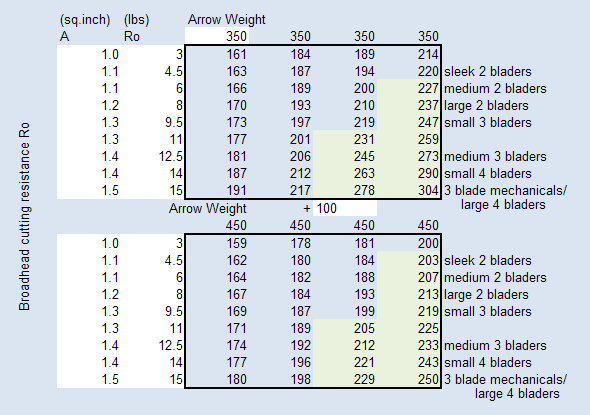 Please note the first column indicate speed needed if no bone is touched, the 2nd column adds energy for 1 rib on entry, the 3 column for 1 rib on exit, and the 4th for 2 ribs. Coulored cells are below, and grey cells above as prescribed by SA-Norms and Standards
Please note the first column indicate speed needed if no bone is touched, the 2nd column adds energy for 1 rib on entry, the 3 column for 1 rib on exit, and the 4th for 2 ribs. Coulored cells are below, and grey cells above as prescribed by SA-Norms and Standards
5.1.1.3 Category 2
 Up to the size of the female Kudu, including the Black Wildebeest, Bush pig, Warthog, all predators except Lion, Leopard, as well as Ostrich, excluding the Gemsbok, and Sable.
Animal mass less than 200kg
Recommended Arrow mass 400 gr
Max hunt distance 25Y
Vitals’ diameter 5"
Required penetration+ 14"
Rib strength 17 vt.lbs
For various arrow weights (columns) and broadheads (rows), you need the following speeds to achieve the required penetration:
Up to the size of the female Kudu, including the Black Wildebeest, Bush pig, Warthog, all predators except Lion, Leopard, as well as Ostrich, excluding the Gemsbok, and Sable.
Animal mass less than 200kg
Recommended Arrow mass 400 gr
Max hunt distance 25Y
Vitals’ diameter 5"
Required penetration+ 14"
Rib strength 17 vt.lbs
For various arrow weights (columns) and broadheads (rows), you need the following speeds to achieve the required penetration:
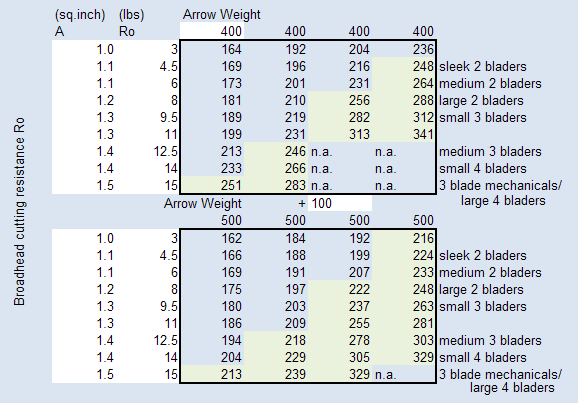 Please note the first column indicate speed needed if no bone is touched, the 2nd column adds energy for 1 rib on entry, the 3 column for 1 rib on exit, and the 4th for 2 ribs. Coulored cells are below, and grey cells above as prescribed by SA-Norms and Standards
Please note the first column indicate speed needed if no bone is touched, the 2nd column adds energy for 1 rib on entry, the 3 column for 1 rib on exit, and the 4th for 2 ribs. Coulored cells are below, and grey cells above as prescribed by SA-Norms and Standards
5.1.1.4 Category 3
 Bigger species up to the Eland, inclusive of the Lion* and Leopard* (where allowed), Blue wildebeest, Kudu bull, Sable and Gemsbok. Excluding Buffalo
Animal mass less than 800kg
Recommended Arrow mass 500 gr
Max hunt distance 30Y
Vitals’ diameter 6"
Required penetration+ 28"
Rib strength 24 vt.lbs
For various arrow weights (columns) and broadheads (rows), you need the following speeds to achieve the required penetration:
Bigger species up to the Eland, inclusive of the Lion* and Leopard* (where allowed), Blue wildebeest, Kudu bull, Sable and Gemsbok. Excluding Buffalo
Animal mass less than 800kg
Recommended Arrow mass 500 gr
Max hunt distance 30Y
Vitals’ diameter 6"
Required penetration+ 28"
Rib strength 24 vt.lbs
For various arrow weights (columns) and broadheads (rows), you need the following speeds to achieve the required penetration:
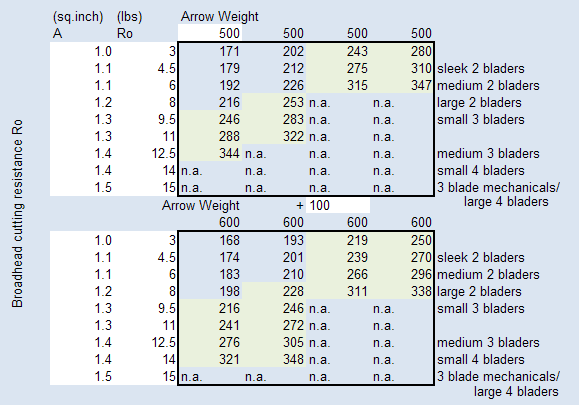 Please note the first column indicate speed needed if no bone is touched, the 2nd column adds energy for 1 rib on entry, the 3 column for 1 rib on exit, and the 4th for 2 ribs. Coulored cells are below, and grey cells above as prescribed by SA-Norms and Standards
Please note the first column indicate speed needed if no bone is touched, the 2nd column adds energy for 1 rib on entry, the 3 column for 1 rib on exit, and the 4th for 2 ribs. Coulored cells are below, and grey cells above as prescribed by SA-Norms and Standards
5.1.1.5 Category 4
Buffalo female, Giraffe female
Animal mass 800-2000kg
Recommended Arrow mass 800 gr
Max hunt distance 40Y
Vitals’ diameter 6"
Required penetration+ 30"
Rib strength 30 vt.lbs
For various arrow weights (columns) and broadheads (rows), you need the following speeds to achieve the required penetration:
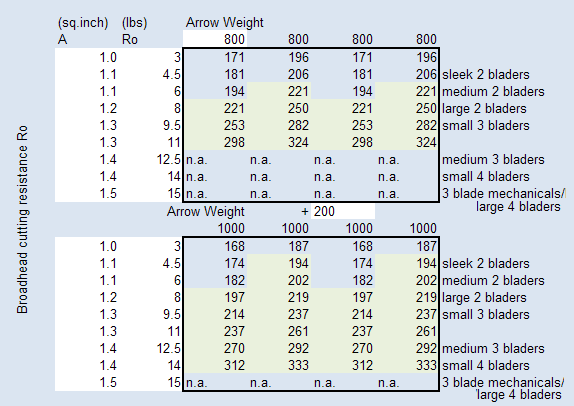 Please note the first column indicate speed needed if no bone is touched, the 2nd column adds energy for 1 rib on entry, the 3 column for 1 rib on exit, and the 4th for 2 ribs. Coulored cells are below, and grey cells above as prescribed by SA-Norms and Standards
Please note the first column indicate speed needed if no bone is touched, the 2nd column adds energy for 1 rib on entry, the 3 column for 1 rib on exit, and the 4th for 2 ribs. Coulored cells are below, and grey cells above as prescribed by SA-Norms and Standards
5.1.1.6 Category 5
Giraffe male, buffalo male, crocodile
Animal mass +1200kg
Recommended Arrow mass 900 gr
Max hunt distance 40Y
Vitals’ diameter 7"
Required penetration+ 40"
Rib strength 40 vt.lbs
For various arrow weights (columns) and broadheads (rows), you need the following speeds to achieve the required penetration:
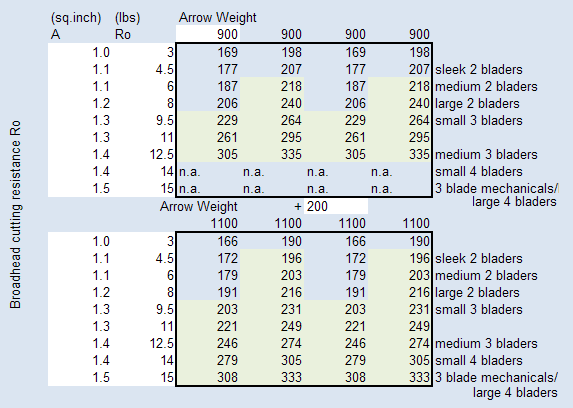 Please note the first column indicate speed needed if no bone is touched, the 2nd column adds energy for 1 rib on entry, the 3 column for 1 rib on exit, and the 4th for 2 ribs. Coulored cells are below, and grey cells above as prescribed by SA-Norms and Standards
Please note the first column indicate speed needed if no bone is touched, the 2nd column adds energy for 1 rib on entry, the 3 column for 1 rib on exit, and the 4th for 2 ribs. Coulored cells are below, and grey cells above as prescribed by SA-Norms and Standards
5.1.1.7 Category 6
Elephant* (where allowed). Black and white rhinoceros* and hippopotamus*.
Animal mass +5000kg
Recommended Arrow mass 1000 gr
Max hunt distance 40Y
Vitals’ diameter 8"
Required penetration+ 50"
Rib strength 40 vt.lbs
For various arrow weights (columns) and broadheads (rows), you need the following speeds to achieve the required penetration:
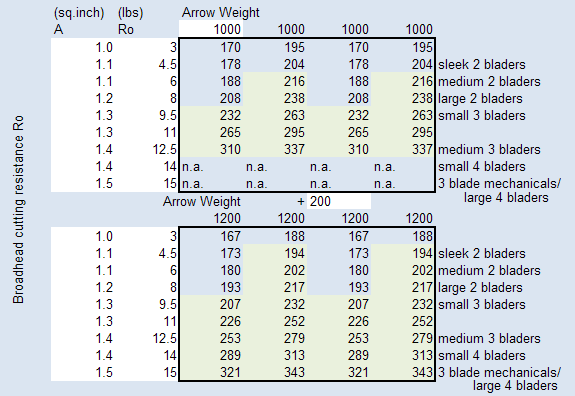 Please note the first column indicate speed needed if no bone is touched, the 2nd column adds energy for 1 rib on entry, the 3 column for 1 rib on exit, and the 4th for 2 ribs. Coulored cells are below, and grey cells above as prescribed by SA-Norms and Standards
Please note the first column indicate speed needed if no bone is touched, the 2nd column adds energy for 1 rib on entry, the 3 column for 1 rib on exit, and the 4th for 2 ribs. Coulored cells are below, and grey cells above as prescribed by SA-Norms and Standards
Category 1-3 should have a point with blade heights of at least Ř 0.35" (9mm)
(cutting diameter 1")
Category 4 and above should have two blades with blade heights of at least Ř 0.4" (10mm),
with a cut-on-contact tip (cutting diameter 1.1").
Category 6 no bleeder blades.
 *According to South African legislation, at the date of this writing, no bowhunting of the listed, threatened or protected species, and pachyderms or chick-skinned animals is allowed in South Africa, except in the case of controlling damage causing animals. These species include:
*According to South African legislation, at the date of this writing, no bowhunting of the listed, threatened or protected species, and pachyderms or chick-skinned animals is allowed in South Africa, except in the case of controlling damage causing animals. These species include:
- elephant
- hippopotamus
- rhinoceros
- cape mountain zebra
- cheetah
- crocodile
- lion
- leopard
- caracal
- porcupine
- common duiker
- Cape fox
- swart poot kat
- small spotted cat
- hartman's zebra
- all primates
- otter
- aardvark
- ietermago/pangolin
It is important to note that bowhunters must adhere to the various provincial rules and regulations, as well as national rules and regulations.
As said, these animals are protected in South Africa, but maybe not in the rest of Africa, where other species may be under protection there. Therefore we include them here for reference, should they be available were hunted, but you will have to as ethical hunter, make sure you have local and up to date information.
**Velocity is subject to a PI of 1 for the hunting point, a shaft factor of 1, and a mass factor of 1.
***Maximum yardage is based on a reaction time from animals and an arrow velocity of 250fps.
****The Vitals’ Area Diameter (VAD) is defined as the diameter of the largest circle that fits inside the shot window to the vital organs (heart and lungs) that miss all the major bones.
+ Required Penetration Depth (RPD) is the depth to which a fieldpoint on an arrow with this speed and weight, according to Poncelet, would have penetrated in flesh.
5.2 Common species names and proposed category
 Categories are based on the animal's weight, and to a degree on what could be considered its "toughness" and the "danger" of hunting it, and as such is fairly arbitrary. It stands to reason therefore that for young animals of a species a lower category would be more applicable, and for some exceptional large individuals, a higher general category may be more appropriate.
Categories are based on the animal's weight, and to a degree on what could be considered its "toughness" and the "danger" of hunting it, and as such is fairly arbitrary. It stands to reason therefore that for young animals of a species a lower category would be more applicable, and for some exceptional large individuals, a higher general category may be more appropriate.
 Temperament is if course a highly subjective issue, for the hunter and the hunted. There are some species differences, but a bigger difference is due to circumstances. It is suggested you take cognizance of the animal's behavior to determine temperament, and to adjust maximum yardages accordingly.
In general the temperament can be compared to reaction times, and the following is suggested:
Temperament is if course a highly subjective issue, for the hunter and the hunted. There are some species differences, but a bigger difference is due to circumstances. It is suggested you take cognizance of the animal's behavior to determine temperament, and to adjust maximum yardages accordingly.
In general the temperament can be compared to reaction times, and the following is suggested:
- reasonably calm use table as is
- cautious about halfway between animal's category and one smaller
- nervous use one categories smaller - about a 20% reduction
See the table on maximum distances based on reaction times for the effect this should have on your shooting. Temperament should override any other species or accuracy concerns.
Average mass is provided as a range, a carcass %, and carcass weight, in kg.
5.2.1 Black Wildebeest (Connochaetes gnou)
category #2
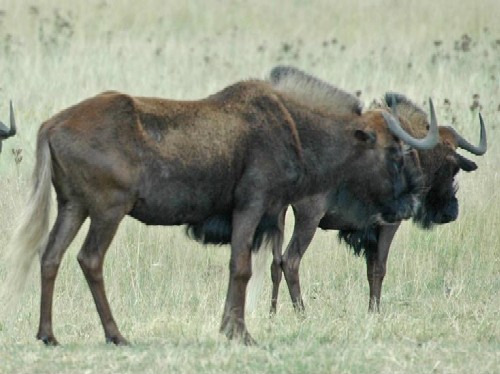
Average Mass: 90-160, 55%, 50-80
Temperament: Cautious
Average Shoulder Height: F:110cm
M:120cm (47")
Rowland Ward: 58.11cm (22 7/8")
max 29 3/8"
SCI: 72 Points max 29 1/2
Track: 89mm (3 1/2") x 61mm (2 3/8")
Equipment: 400gr @ 250fps, Ro<12 |  |
Further Reading: Engee Potgieter, AB&A, Jan 2008, p27, "Black Wildebeest:Icon of the open plains"
5.2.2 Blesbuck (Damaliscus dorcas phillipsi)
category #1
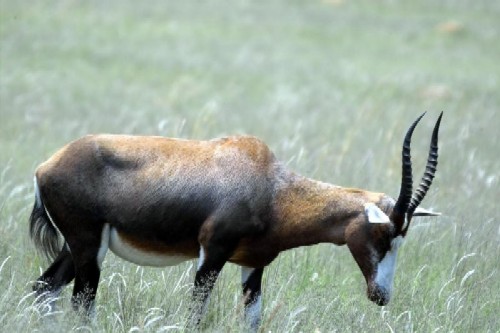
Average Mass: 60-80, 53, 32-44
Temperament: Cautious
Average Shoulder Height: 95cm (37")
Rowland Ward: 41.91cm (16 1/2")
max 20 5/8"
SCI: 39 Points max 54 7/8
Track: 64mm (2 1/2") x 45mm (1 3/4")
Equipment: 350gr @ 250fps, Ro<16 |  |
Further Reading: Cleve Cheney, AB&A, Sep 2007, p8, "Hunting Blesbok"
Engee Potgieter, AB&A, Sep 2007, p10, "Bowhunting the boring blesbok"
Anthony C. Ruggeri, AB&A, Sep 2007, p20, "Blesbok: The Plain's game little big man"
5.2.3 Blue Wildebeest (Connochaetes taurinus taurinus)
category #3
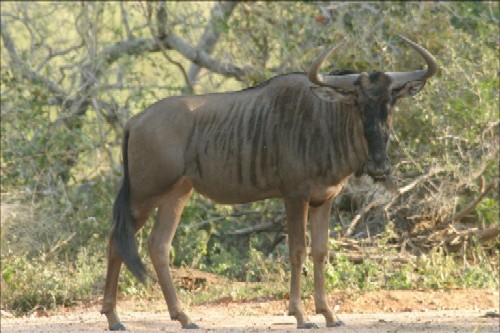
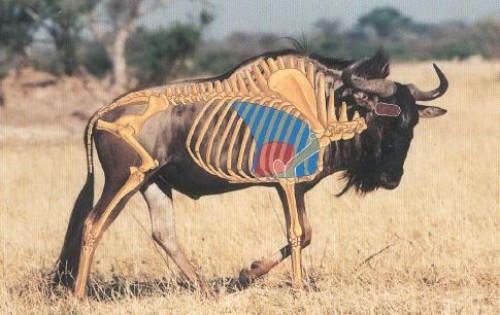
Average Mass: 215-250, 58, 125-145
Temperament: Reasonably calm
Average Shoulder Height: F:135cm
M:150cm
Rowland Ward: 72.39 cm (28 1/2")
max 33 7/8
SCI: 70 Points max 94 3/4
Track: 86mm (3 3/8") x 61mm (2 3/8")
Equipment: 600gr @ 250fps, Ro<12 |  |
Further Reading: Cleve Cheney, AB, Jan/Feb 2001, p8, "Bowhunting Blue Wildebeest"
Cleve Cheney, AB&A, Jun 2008, p8, "Hunting Blue Wildebeest"
Jerry Pilling, AB&A, Jun 2008, p12, "Waiting for a wildebeest"
5.2.4 Buffalo (Syncerus caffer caffer)
female:category #4, male:/>category #5
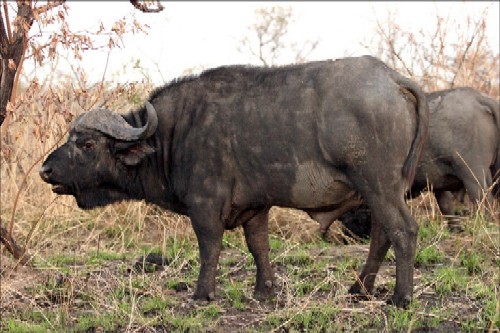
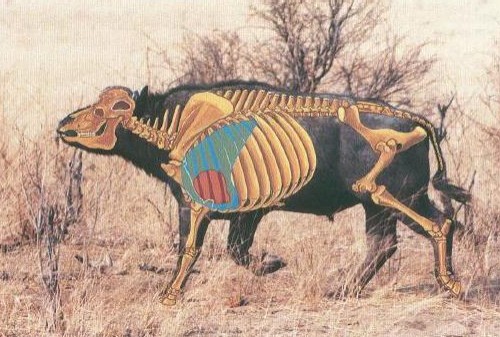
Average Mass: 680-820, 50, 340-410
Temperament: Reasonably calm
Average Shoulder Height: 170 cm (67")
Rowland Ward: 114.30 cm (45")
SCI: 100 Points
Track: 152mm (6") x 152mm (6")
Equipment: 800 gr @ 220, 900gr @ 215fps, Ro<8 | 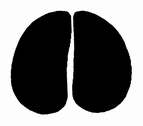 |
Further Reading: Piet Lombard, AB&A, Apr 2007, p9, "Buffalo hunt on the run"
5.2.5 Bush Buck (Tragelaphus scriptus sylvaticus)
category #1
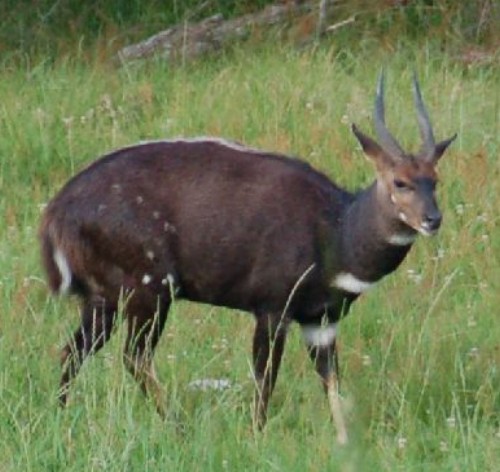
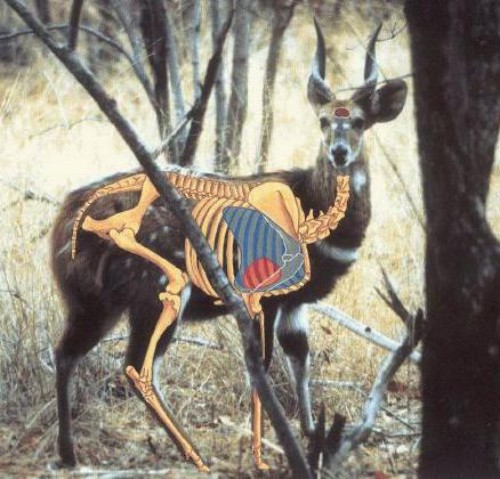
Average Mass: 63-73, 55, 35-40
Temperament: nervous
Average Shoulder Height: 80 cm (31")
Rowland Ward: 38.10 cm (15")
SCI: 31 Points
Track: 41mm (1 5/8") x 25mm (1")
Equipment: 350gr @ 250fps, Ro<12 | 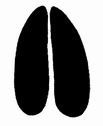 |
Further Reading: Cleve Cheney, AB&A, Jul 2008, p8
5.2.6 Bushpig (Potamochoerus porcus)
category #2
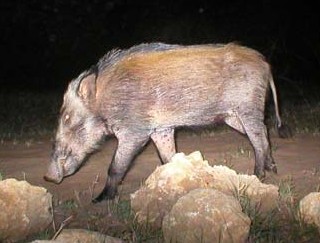
Average Mass: 65
Temperament: nervous
Average Shoulder Height: 75 cm (30")
Rowland Ward: 13.97 cm (5 1/2")
SCI: 11 Points
Track: 41mm (1 5/8") x 38mm (1 1/2")
Equipment: 400gr @ 250fps, Ro<10 | 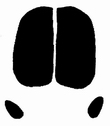 |
Further Reading: Engee Potgieter, AB&A, Oct 2008, p28
Cleve Cheney, AB&A, Dec 2007, p8, "Hunting the Feral Pig"
Adrian de Villiers, AB&A, Dec 2007, p27, "Bowhunting Feral Pigs"
5.2.7 Caracal(rooikat) (Caracal caracal)
category #2
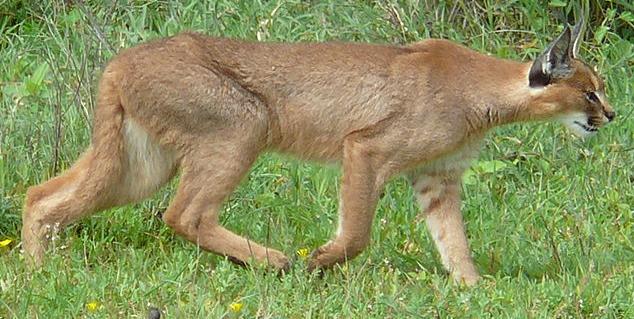
Average Mass: 7 - 19 kg
Temperament: nervous
Average Shoulder Height: 40 - 45 cm (17")
Rowland Ward: 19.05 cm (7 1/2")
SCI: 6 Points
Track: 51 x 51 mm(2")
Equipment: 350gr @ 250fps, Ro<12 | 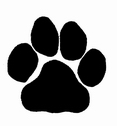 |
5.2.8 Cheetah (Acinonyx jubatus)
category #2
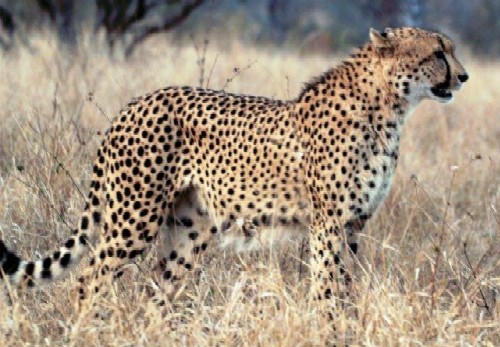
Average Mass: 63
Temperament: nervous
Average Shoulder Height: 86 cm (34")
Rowland Ward: 31.44 cm (12 3/8")
SCI: 12 Points
Track: 105mm (4 1/8") x 86mm (3 3/8")
Equipment: 400gr @ 250fps, Ro<12 |  |
5.2.9 Crocodile (Crocodilus nilotica)
category #5
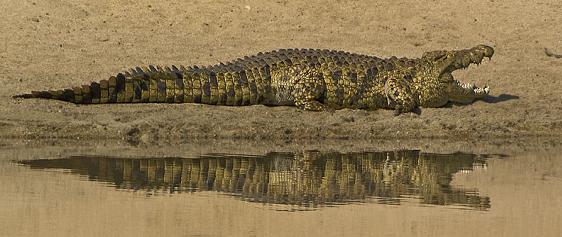
Average Mass: 910
Temperament: Reasonably calm
Average length: 5.5m + (18 '+)
Rowland Ward: 4.27m (14') length
SCI: 2.75 m (9 ')
Track:
Front: 180mm (4 1/4") x 150mm (4 1/4")
Hind: 180mm (4 1/4") x 150mm (4 1/4")
Equipment: 900gr @ 200fps, Ro<10 | 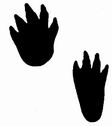 |
5.2.10 Duiker (Cephalophus monticola)
category #1
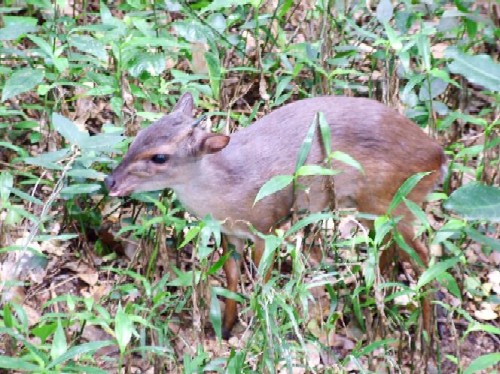
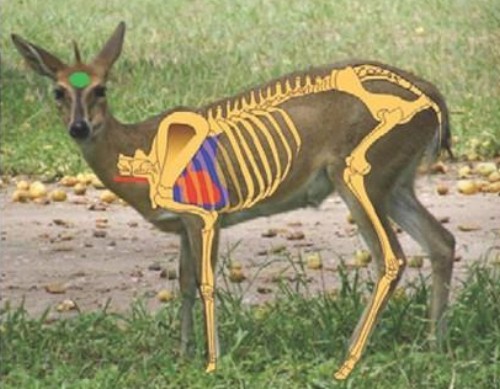
Average Mass: 10-14, 55, 6-8
Temperament: Cautious
Average Shoulder Height: 30 cm (12")
Rowland Ward: 4.44 cm (1 3/4")
SCI: 4 Points
Track: 41mm (1 5/8") x 25mm (1")
Equipment: 350gr @ 250fps, Ro<12 | 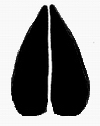 |
Further Reading: Cleve Cheney, AB&A, Jan 2007, p8, "Hunting the Blue Duiker"
Cleve Cheney, AB&A, Nov 2008, p8
5.2.11 Eland (Taurotragus oryx livingstonii)
category #3
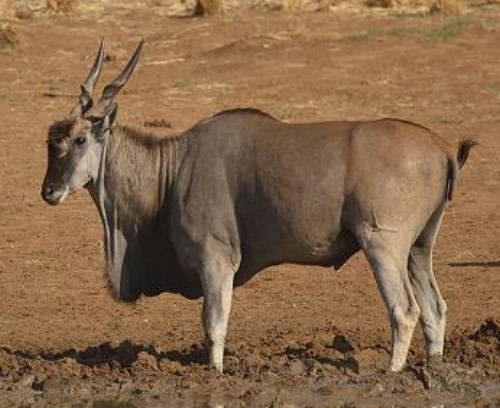
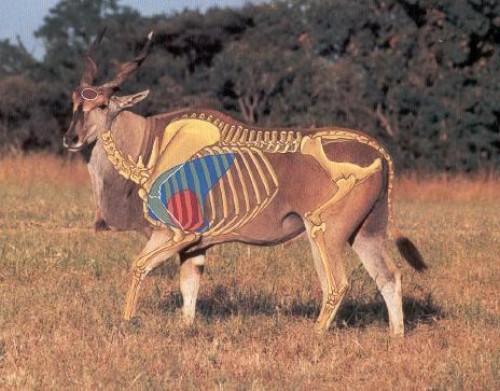
Average Mass: 460-910, 51, 235-464
Temperament: Cautious
Average Shoulder Height: 170 cm (67")
Rowland Ward: 88.90 cm (35")
SCI: 77 Points
Track: 114mm (4 1/2") x 95mm (3 3/4")
Equipment: 600gr @ 250fps, Ro<10 | 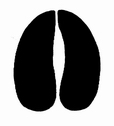 |
Further Reading: Cleve Cheney, AB&A, Oct 2008, p8
Anthony C. Ruggeri, AB&A, Jan 2007, p27, "Eland"
5.2.12 Elephant (Loxodonta africana)
category #6
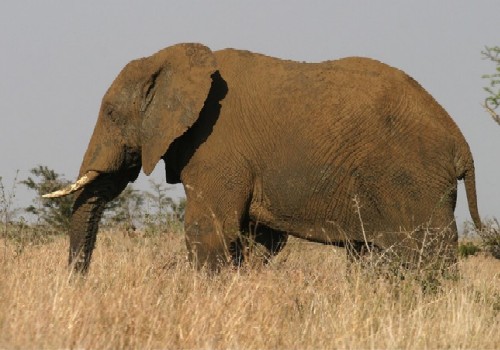
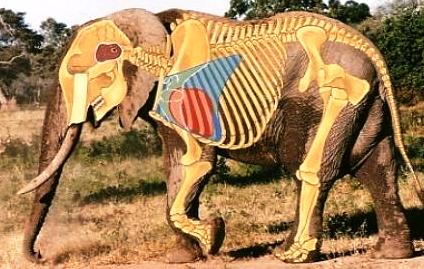
Average Mass: 5700
Temperament: Reasonably calm, but can be
nervous
Average Shoulder Height: 350cm (138")
Rowland Ward: 36.36kg (80lb)
SCI: 100 Points
Track: 533mm (21") x 483mm (19")
Equipment: 1200gr @ 200fps, Ro<5 | 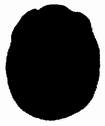 |
Further Reading: Fritz Rabe, AB&A, Oct 2006, p36, "Elephant Bowhunt"
Hendrik Von Wielligh, AB&A, Aug 2007, p19, "Musth in Male African Elephants"
5.2.13 Fallo Deer (Cervus dama dama)
category #1
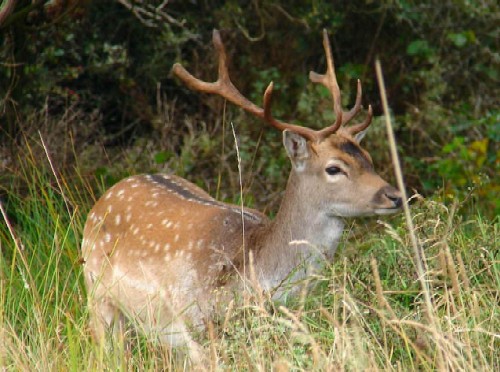
Average Mass: 68
Temperament:
Average Shoulder Height: 91 cm (36")
Rowland Ward: 64.13 cm (25 1/4")
SCI: 130 Points
Track: 73mm (2 7/8") x 44mm (1 3/4 ")
Equipment: 350gr @ 250fps, Ro<12 | 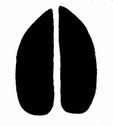 |
5.2.14 fox (Otocyon megalotis)
category #1

Average Mass: 3 - 4.5kg
Temperament: shy, nervous
Average Shoulder Height: 35-40 cm (16")
Rowland Ward:
SCI:
Track:
Equipment: 350gr @ 250fps, Ro<12
5.2.15 Gemsbok (Oryx gazella gazella)
category #3
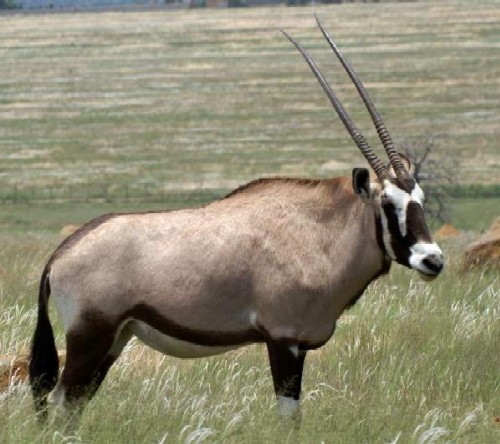
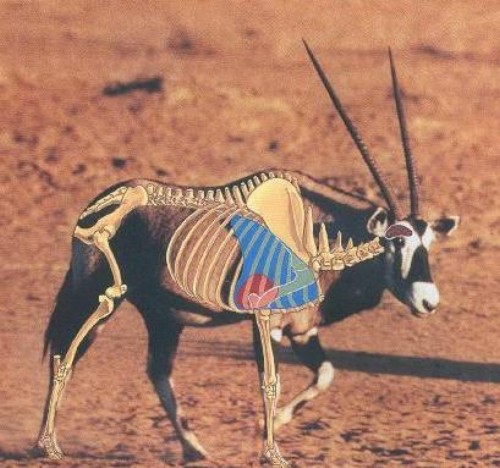
Average Mass: 180-210, 55, 99-118
Temperament: Cautious
Average Shoulder Height: 120 cm (47")
Rowland Ward: 101.60 cm (40")
SCI: 88 Points
Track: 95mm (3 3/4") x 70mm (2 3/4")
Equipment: 500gr @ 250fps, Ro<10 |  |
Further Reading: Cleve Cheney, AB&A, Aug 2007, p8, "Hunting Gemsbok"
5.2.16 Giraffe (Giraffa camelopardalis giraffa)
female:category #4, male: category #5
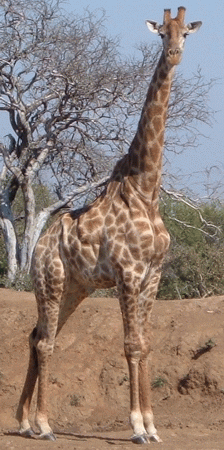
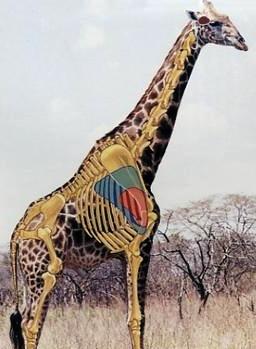
Average Mass: 600-1400, 55, 330-770
Temperament: Reasonably calm - Cautious
Average Shoulder Height: 5 -6 m (16 - 19 ft)
Rowland Ward: nc
SCI: nc
Track: 190mm (7") x 150mm (6")
Equipment: 900gr @ 210fps, Ro<5 |  |
Further Reading: Gideon Van Niekerk, AB&A, Jul 2006, p30, "My Giraffe"
5.2.17 Grey Rhebok (Palea capreolus)
category #1
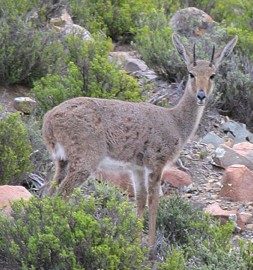
Average Mass: 25
Temperament: nervous
Average Shoulder Height: 81 cm (32")
Rowland Ward: 20.01 cm (7 7/8 ")
SCI: 18 Points
Track: 64mm (2 1/2") x 41mm (1 5/8")
Equipment: 350gr @ 250fps, Ro<12 | 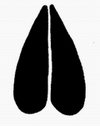 |
5.2.18 Grysbbok (Raphicerus melanotis)
category #1
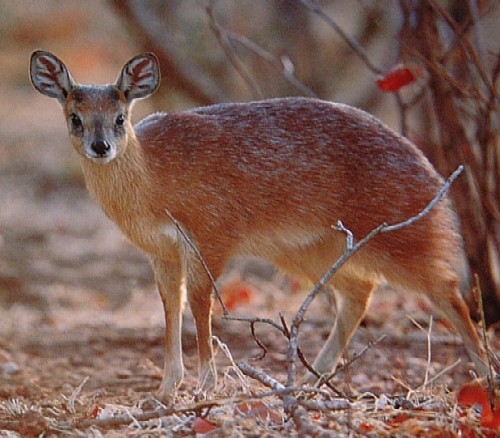
Average Mass: 8-14, 55, 4-8
Temperament:
Average Shoulder Height: 54 cm (21")
Rowland Ward: 7.62 cm (3")
SCI: 7 Points
Track: 32mm (1 3/4") x 19mm (3/4")
Equipment: 350gr @ 250fps, Ro<12 |  |
Further Reading: Cleve Cheney, AB&A, Nov 2006, p8, "Hunting Cape Grysbok"
Engee Potgieter, AB&A, Nov 2006, p25, "Bowhunting the Cape Grysbok"
5.2.19 Hartebees (Alcelaphus buselaphus)
category #2
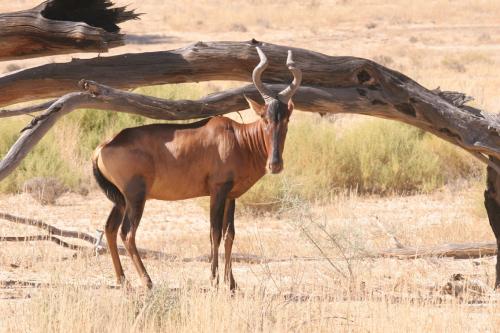
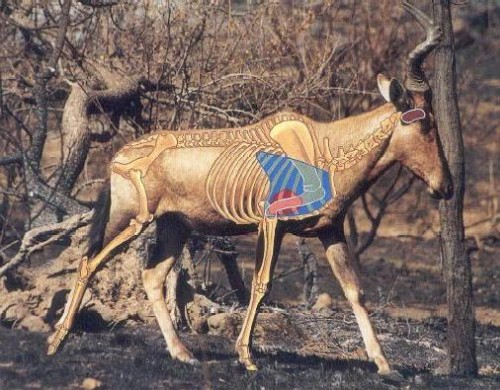
Average Mass: 160-182, 55, 88-100
Temperament: Cautious
Average Shoulder Height: 124 cm (49")
Rowland Ward: 58.42 cm (23")
SCI: 62 Points
Track: 98mm (3 7/8") x 67mm (2 5/8")
Equipment: 450gr @ 250fps, Ro<12 |  |
Further Reading: Cleve Cheney, AB&A, Aug 2008, p8 (Red)
Cleve Cheney, AB&A, Mar 2007, p8, "Hunting Lichtenstein Hartbees"
5.2.20 Hippo (Hippopotamus amphibius)
category #6
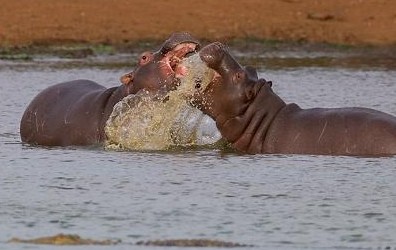
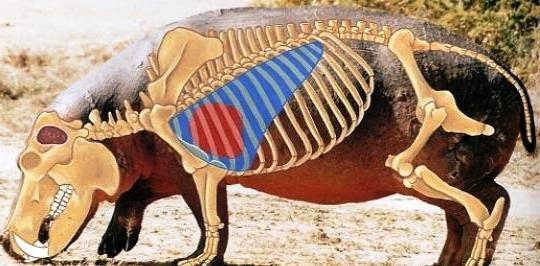
Average Mass: 2000
Temperament: Caution to nervous
Average Shoulder Height: 150 cm (60")
Rowland Ward: 75.89 cm (29 7/9")
SCI: 50 Points
Track: 254mm (10 ") x 254mm (10 ")
Equipment: 1000gr @ 205fps, Ro<5 | 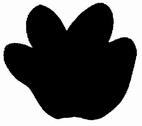 |
Further Reading: Fritz Rabe, AB&A, Mar 2009, p17
5.2.21 Hyaena (Crocuta crocuta)
category #2
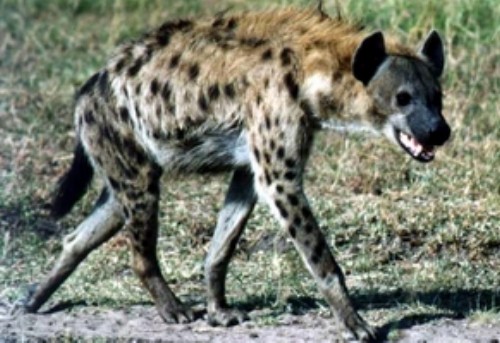
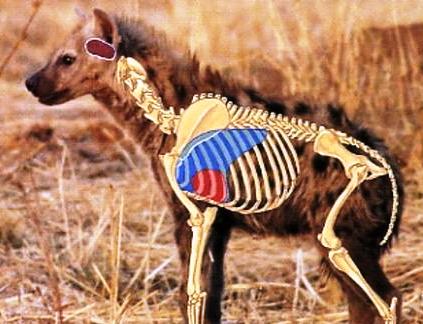
Average Mass: 70
Temperament: Reasonably calm
Average Shoulder Height: 80 cm (31")
Rowland Ward: -----
SCI: 15 Points
Track: 110mm (4") x 110mm (4")
Equipment: 350gr @ 250fps, Ro<12 | 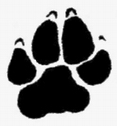 |
Further Reading: Cleve Cheney, AB&A, Sep 2009, p8, "Hunting Hyena"
5.2.22 Impala/Rooibok (Aepyceros melampus melampus)
category #1
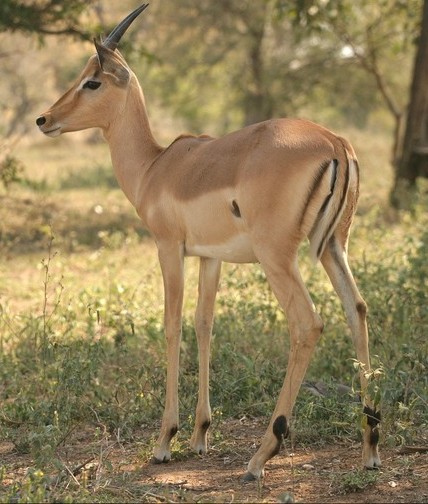
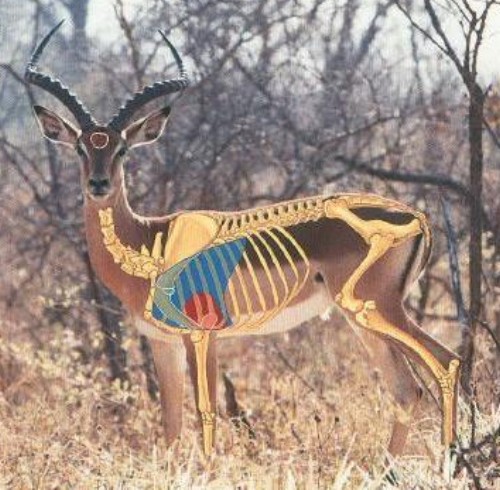
Average Mass: 39-80, 58, 22-46
Temperament: Cautious
Average Shoulder Height: 90 cm (36")
Rowland Ward: 60.02 cm (23 5/8")
SCI: 54 Points
Track: 60mm (2 3/8") x 41mm (1 5/8")
Equipment: 350gr @ 275fps, Ro<12 |  |
Further Reading: Cleve Cheney, AB, Nov/Dec 2000, p8, "Bowhunting the Impala"
Cleve Cheney, AB&A, Jul 2007, p8, "Hunting Impala"
Eddie Muller, AB&A, Jul 2007, p19, "Impala Hunt at Elandskloof"
Gerhard Delport, AB&A, Mar 2009, p34
5.2.23 Jackals
category #1
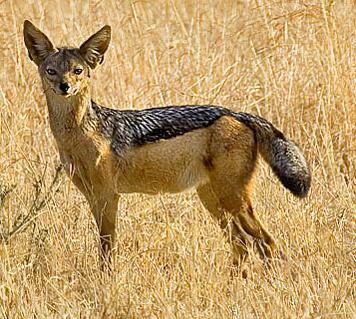
Average Mass: 4 - 8kg
Temperament: Cautious
Average Shoulder Height: 30 cm (12")
Rowland Ward:
SCI:
Track:
Equipment: 350gr @ 250fps, Ro<12 |
Further Reading: Cleve Cheney, AB&A, Apr 2007, p6, "Hunting Black Back Jackal"
5.2.24 Klipspringer (Oreotragus oreotragus)
category #1
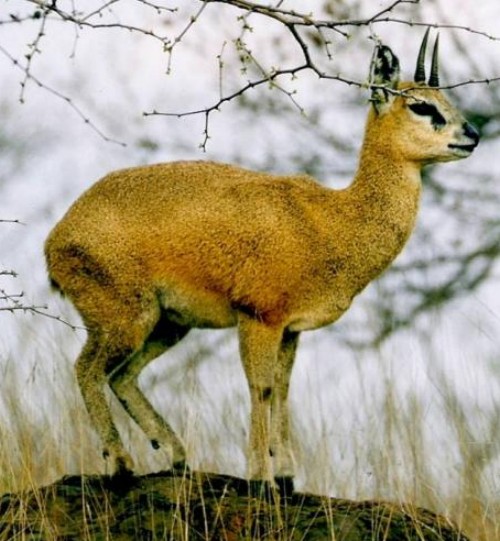
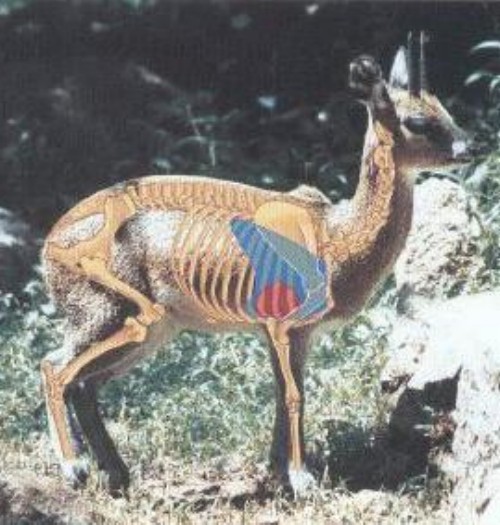
Average Mass: 11-16, 55, 6-9
Average Shoulder Height: 53 cm (21")
Rowland Ward: 10.49 cm (4 1/8 ")
SCI: 11 Points
Track: 22mm (7/8") x 13mm (1/2")
Equipment: 350gr @ 250fps, Ro<12 | 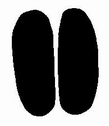 |
5.2.25 Kudu (Tragelaphus strepsiceros strepsiceros)
female category #2, male category #3
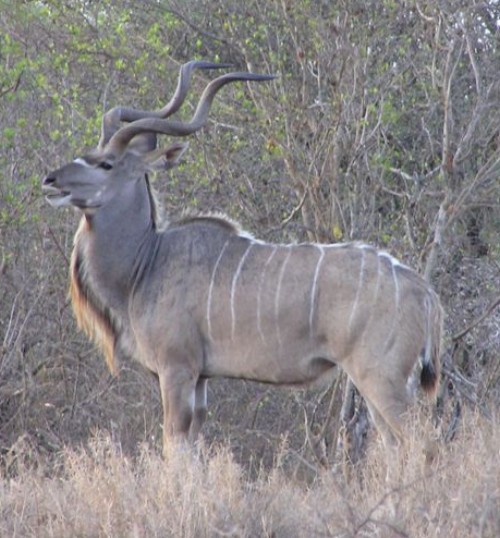
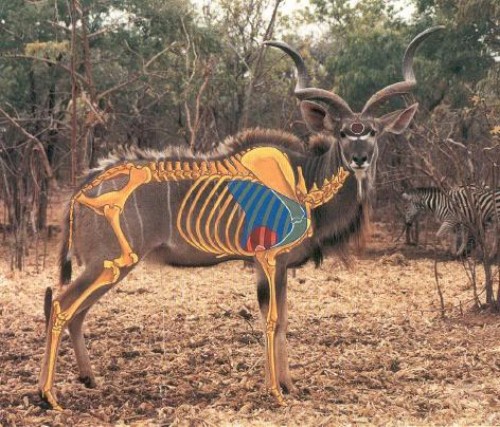
Average Mass: 150-300, 57, 86-172
Temperament: Cautious
Average Shoulder Height: 150 cm (59")
Rowland Ward: 136.85 cm (53 7/8 ")
SCI: 121 Points
Track: 111mm (4 3/8") x 51mm (2")
Equipment: 500gr @ 250fps, Ro<10 |  |
Further Reading: Cleve Cheney, AB&A, Sep 2006, p8, "Hunting Kudu"
5.2.26 Leopard (Panthera pardus)
category #3
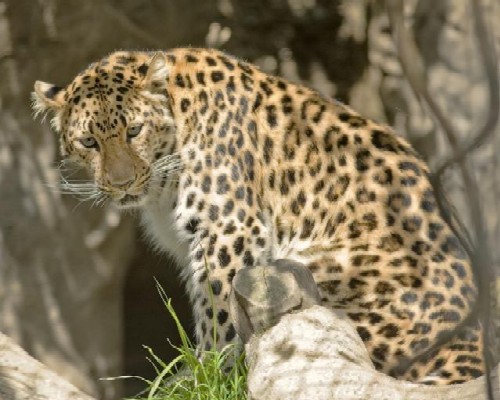
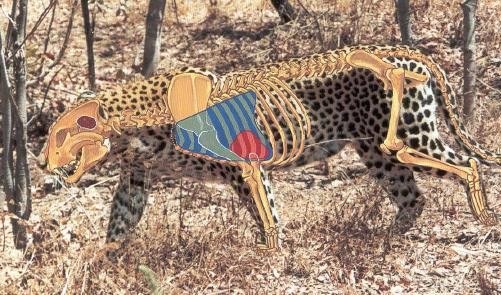
Average Mass: 82
Temperament: Reasonably calm
Average Shoulder Height: 71 cm (28")
Rowland Ward: 39.06 cm (15 3/8")
SCI: 14 Points
Track:108mm (4 1/4") x 108mm (4 1/4")
Equipment: 500gr @ 250fps, Ro<12 |  |
5.2.27 Lion (Panthera leo)
category #3
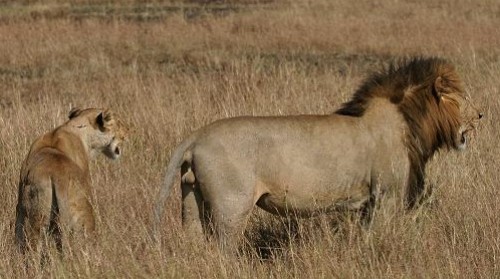
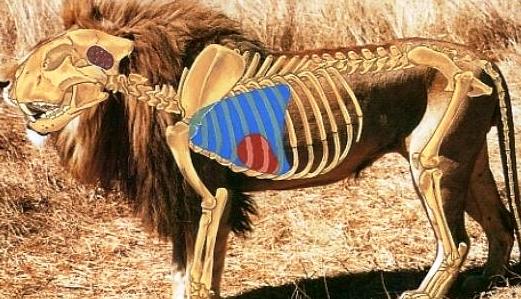
Average Mass: 210
Temperament: Reasonably calm
Average Shoulder Height: 106 cm (42")
Rowland Ward: 60.96 cm (24 ")
SCI: 23 Points
Track: 146mm (5 3/4") x 127mm (5")
Equipment: 500gr @ 250fps, Ro<12 | 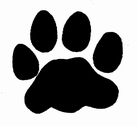 |
Further Reading: George Tsaparis, AB, Jan/Feb 2001, p22, "Lion Hunt"
Smit Craill, AB&A, Feb 2008, p50, "Om 'n leeu met 'n boog te jag"
5.2.28 Nyala (Tragelaphus angasii)
female category #1, bull category #2

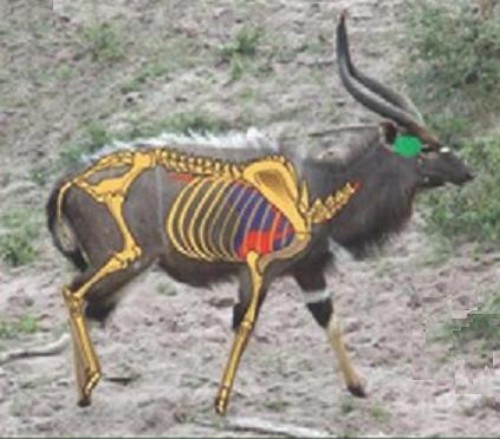
Average Mass: 90-136, 55, 50-75
Temperament: Cautious
Average Shoulder Height: 112 cm (44")
Rowland Ward: 68.58 cm (27")
SCI: 63 Points
Track: 60mm (2 3/8") x 41mm (1 5/8 ")
Equipment: 450gr @ 250fps, Ro<12 | 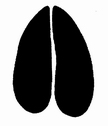 |
5.2.29 Oribi (Ourebia ourebia)
category #1
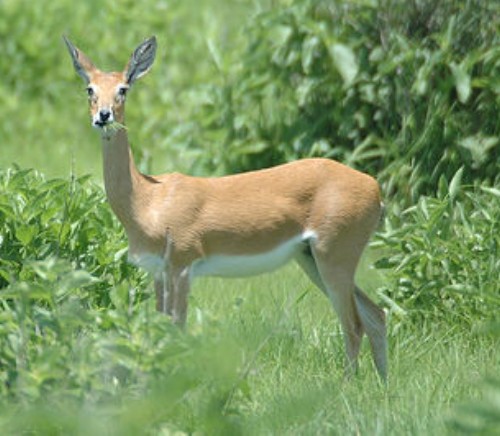
Average Mass: 14-20, 55, 8-11
Temperament:
Average Shoulder Height: 58 cm (23")
Rowland Ward: 14.93 cm (5 7/8 ")
SCI: 13 Points
Track: 35mm (1 3/8") x 19mm (3/4")
Equipment: 350gr @ 250fps, Ro<12 |  |
5.2.30 Ostrich (Stuthio camelus)
category #2

Average Mass:
Temperament:
Average Shoulder Height:
Rowland Ward:
SCI:
Track:
Equipment: 400gr @ 250fps, Ro<12 |  |
Further Reading: Cleve Cheney, AB&A, Feb 2008, p8, "Hunting Ostrich"
5.2.31 Porcupine ()
category #1
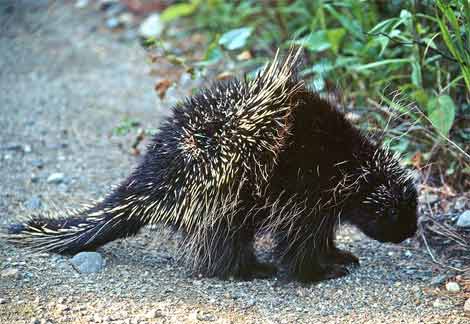
Average Mass: 10-24kg
Temperament:
Average Shoulder Height: 10 - 15 cm (6")
Rowland Ward:
SCI:
Track:
Equipment: 350gr @ 250fps, Ro<12
Further Reading: Cleve Cheney, AB&A, Jan 2008, p8, "Hunting Porcupine"
5.2.32 Puku (Kobus vardonii)
category #2
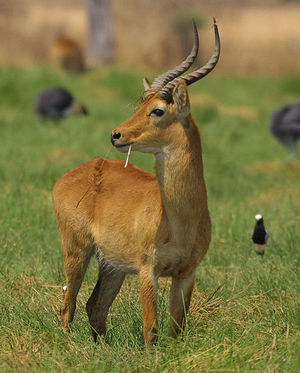
Average Mass: 62-74kg
Temperament:
Average Shoulder Height: 80 cm (31")
Record: 56,2 cm
SCI:
Track:
Equipment: 450gr @ 250fps, Ro<12
Further Reading: Cleve Cheney, AB&A, Jul 2006, p8, "Hunting the Puku"
5.2.33 Reedbuck (Redunca arundinum)
category #2
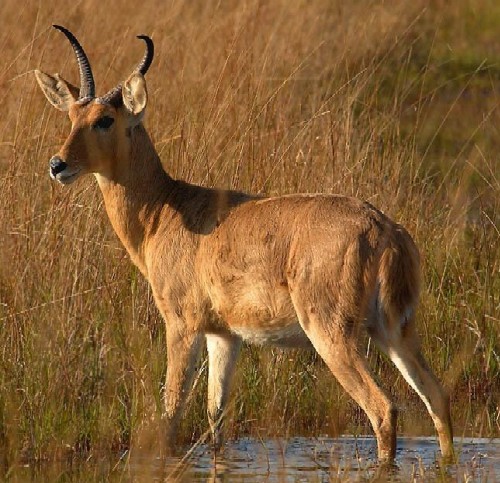
Average Mass: 50-80, 55, 28-44
Temperament: nervous
Average Shoulder Height: 91.44 cm (36")
Rowland Ward: 35.56 cm (14")
SCI: 21 Points
Track: 64mm (2 1/2") x 41mm (1 5/8")
Equipment: 450gr @ 250fps, Ro<12 |  |
5.2.34 Rhino (Ceratotherium simum simum)
category #6
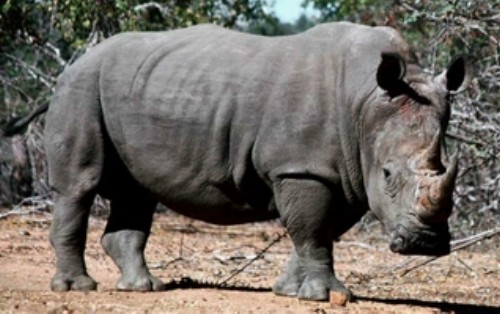
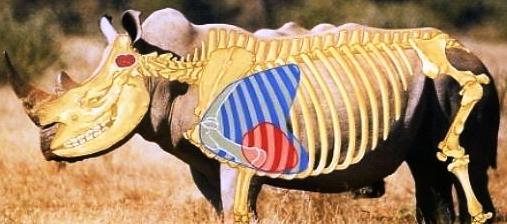
Average Mass: 2150
Temperament:
White: Reasonably calm; Black: nervous
Average Shoulder Height: 170cm (67")
Rowland Ward: 71.12cm (28")
SCI: 70 Points
Track: 279mm (11") x 229mm (9")
Equipment: 1200gr @ 200fps, Ro<5 | 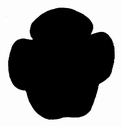 |
Further Reading: Cleve Cheney, AB&A, Apr 2006, p8, "Hunting White Rhino"
5.2.35 Roan Antelope / Bastergemsbok (Hippotragus equinus equinus)
category #3
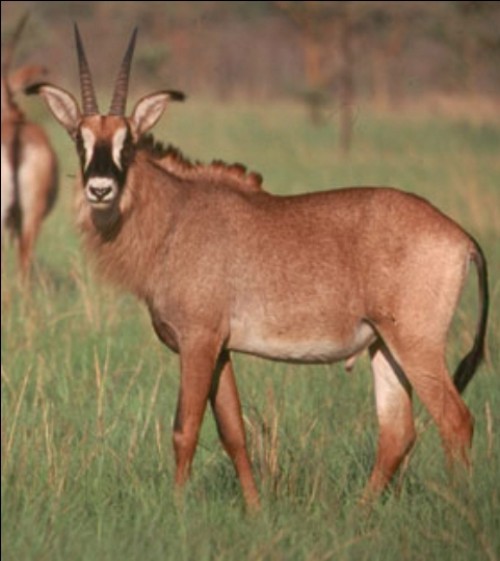
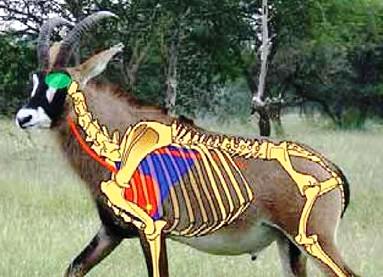
Average Mass: 227-272, 55, 125-150
Temperament: Cautious
Average Shoulder Height: 143 cm (56")
Rowland Ward: 68.58 cm (27")
SCI: 68 Points
Track: 121mm (4 3/4") x 89mm (3 1/2")
Equipment: 600gr @ 250fps, Ro<10 |  |
Further Reading: Cleve Cheney, AB&A, Jan 2009, p8
5.2.36 Sable (Hippotragus niger niger)
category #3
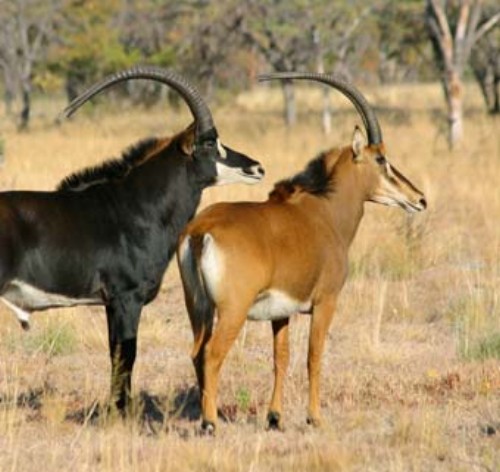
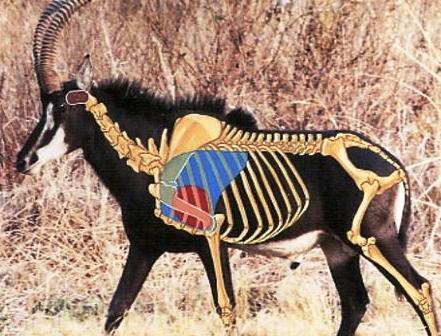
Average Mass: 180-230, 55, 100-127
Temperament: Cautious
Average Shoulder Height: 140 cm (55")
Rowland Ward: 106.37 cm (41 7/8 ")
SCI: 100 Points
Track: 114mm (4 1/2") x 76mm (3")
Equipment: 600gr @ 250fps, Ro<10 |  |
Further Reading: Cleve Cheney, AB&A, Nov 2007, p8, "Hunting Sable"
Carl Hager, AB&A, Nov 2007, p13, "Fable of a Sable"
5.2.37 Sitatunga / Waterkoedoe (Tragelaphus spekei)
category #2
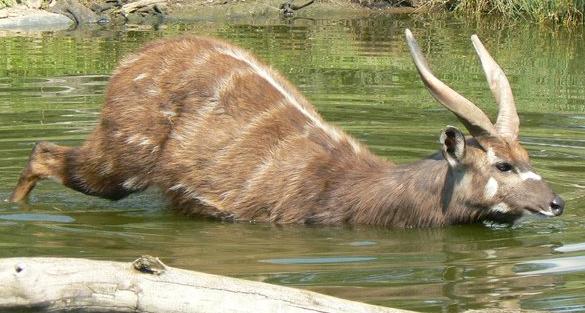
Average Mass: 55-115kg
Temperament:
Average Shoulder Height: 75-125 cm (29")
Record: 92.4 cm
SCI:
Track:
Equipment: 400gr @ 250fps, Ro<12
Further Reading: Cleve Cheney, AB&A, Jun 2007, p8, "Hunting Sitatunga"
5.2.38 Soenie/Suni (Neotragus moschatus)
category #1
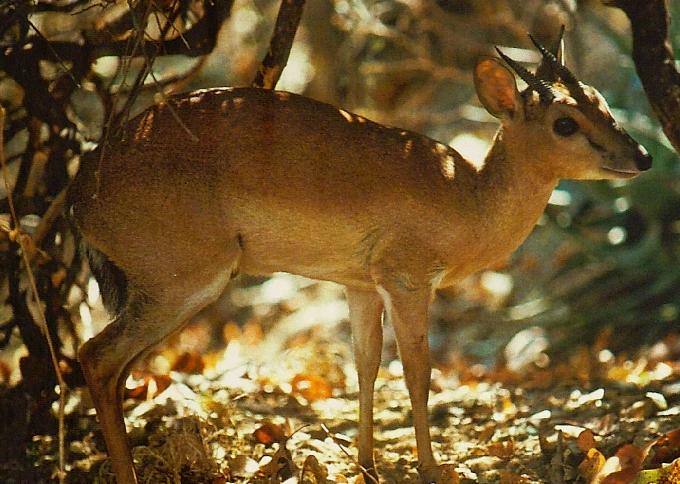
Average Mass: 5kg
Temperament:
Average Shoulder Height: 35 cm (14")
Rowland Ward:
SCI:
Track:
Equipment: 350gr @ 250fps, Ro<12
Further Reading: Cleve Cheney, AB&A, Oct 2006, p8, "Hunting Suni"
5.2.39 Springbuck (Antidorcas marsupialis)
category #2
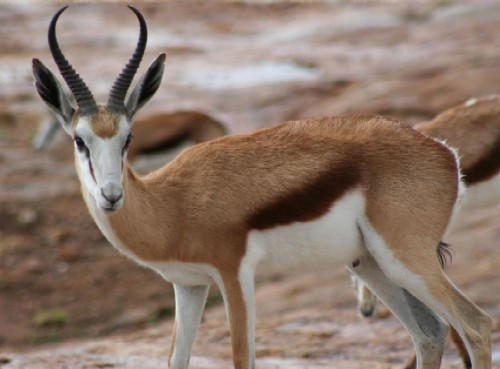
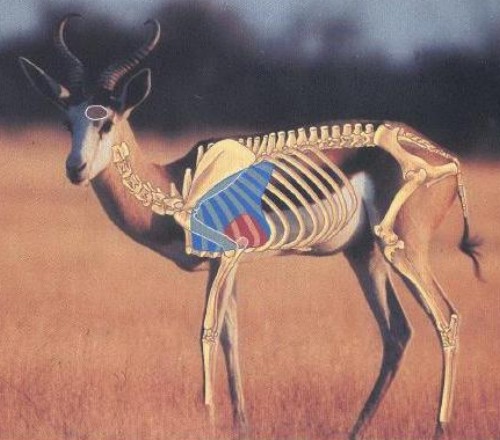
Average Mass: 33-48, 51-58, 18-26
Temperament: nervous
Average Shoulder Height: 74 cm (29")
Rowland Ward: 35.56 cm (14")
SCI: 30 Points
Track: 51mm (2") x 35mm (1 3/8")
Equipment: 350gr @ 275fps, Ro<12 |  |
Further Reading: Cleve Cheney, AB&A, May 2008, p8, "Hunting Springbuck"
Frank Berbuir, AB&A, May 2008, p27, "Springbuck with bow and arrow"
5.2.40 Steenbok (Raphicerus campestris)
category #1
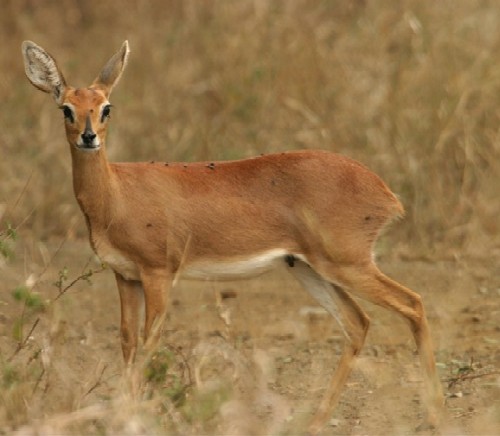
Average Mass: 9-14, 55, 5-8
Temperament: Cautious
Average Shoulder Height: 52 cm (20")
Rowland Ward: 11.43 cm (4 1/2")
SCI: 11 Points
Track: 32mm (1 1/4") x 19mm (1 3/4")
Equipment: 350gr @ 250fps, Ro<12 | 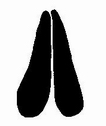 |
5.2.41 Tsessebe (also Topi)(Damaliscus lunatus lunatus)
category #2
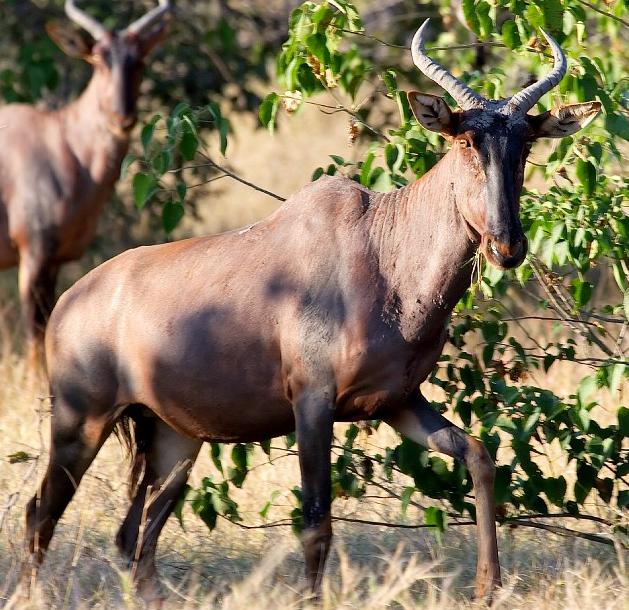
Average Mass: 126 - 140 kg
Temperament: Cautious
Average Shoulder Height: 120 cm (47")
Record: 46.99 cm
SCI:
Track:
Equipment: 450gr @ 250fps, Ro<12 |
Further Reading: Cleve Cheney, AB&A, Mar 2009, p8
5.2.42 Warthog (Phacochoerus africanus)
category #2
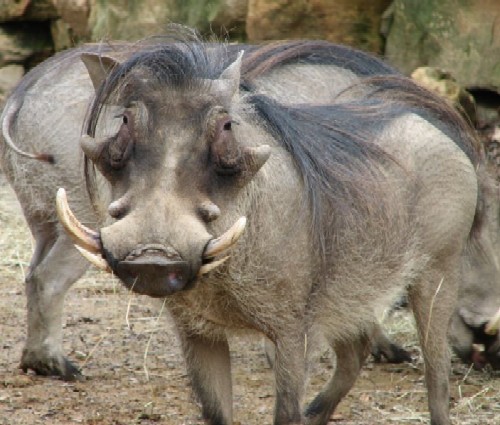
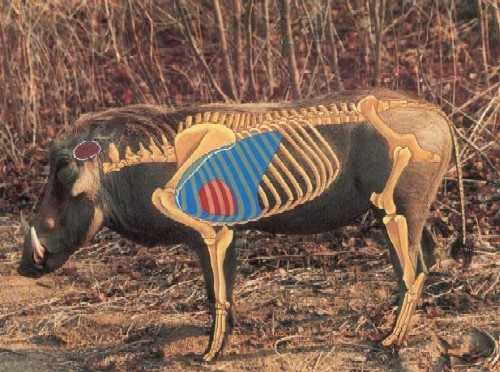
Average Mass: 80
Temperament: Cautious
Average Shoulder Height: 70 cm (28")
Rowland Ward: 33.02 cm (13")
SCI: 30 Points
Track: 51mm (2") x 44mm (1 3/4")
Equipment: 450gr @ 250fps, Ro<12 |  |
5.2.43 Waterbuck (Kobus ellipsiprymnus)
category #3
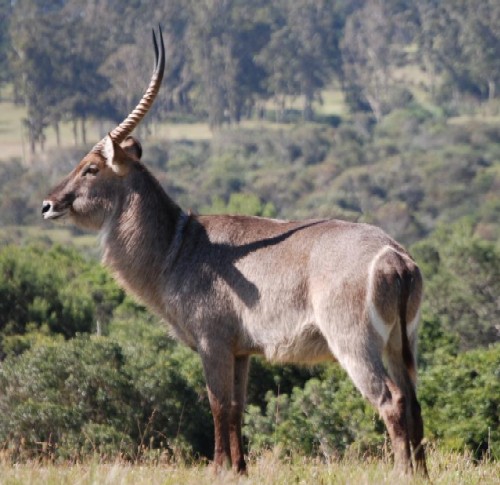
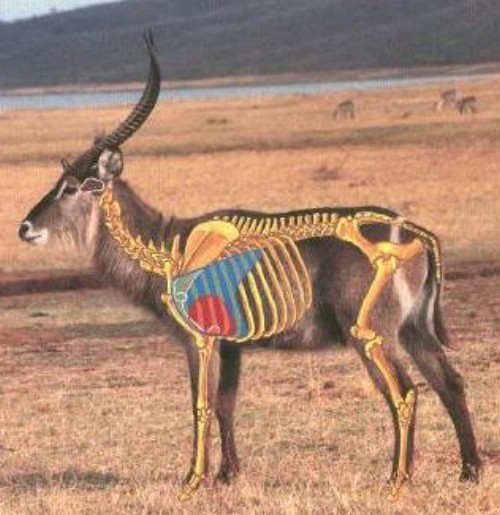
Average Mass: 240-270, 55, 112-150
Temperament: Cautious
Average Shoulder Height: 127 cm (50")
Rowland Ward: 71.12 cm (28")
SCI: 70 Points
Track: 51mm (2") x 44mm (1 3/4")
Equipment: 500gr @ 250fps, Ro<10 |  |
Further Reading: Cleve Cheney, AB&A, Oct 2007, p8, "Hunting Waterbuck"
Adrian De Villiers, AB&A, Oct 2007, p13, "Defassa Waterbuck"
5.2.44 Wild Boar (Sus scrofa barbarus)
category #5
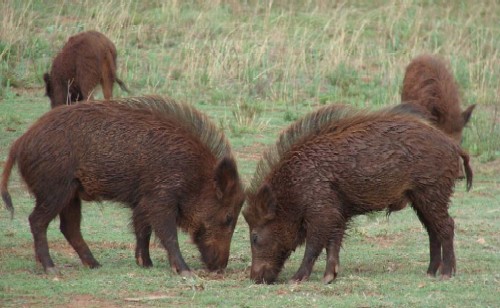
Note: The reason for its high category is its
grizzle pad, a collagen shield that protects
the vitals.
Average Mass: 50 to 350
(big difference in sub-species)
Temperament: nervous
Average Shoulder Height: 91 cm (36")
Rowland Ward:
SCI:
Track:
Equipment: 800gr @ 250fps, Ro<5 |  |
Further Reading: Engee Potgieter, AB&A, Dec 2007, p13, "An Eurasian Wild Boar Hunt"
5.2.45 Zebra (Equus quagga antiquorum)
category #3
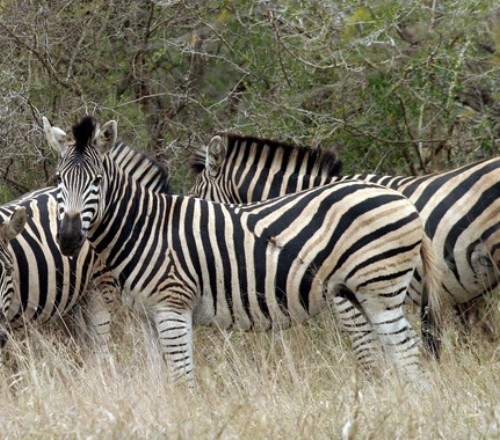
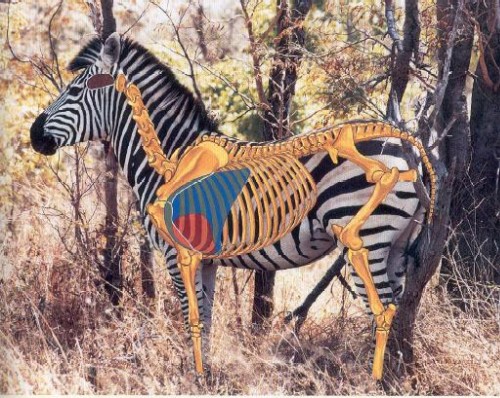
Average Mass: 270-350, 55, 150-200
Temperament: Reasonably calm
Average Shoulder Height: 130 cm (51")
Track: 127mm (5") x 102mm (4")
Equipment: 500gr @ 250fps, Ro<8 | 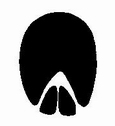 |
Further Reading: Cleve Cheney, AB&A, Apr 2008, p8, "Hunting Burchell's Zebra"
Cleve Cheney, AB&A, Sep 2009, p46, "Tracking Zebra"
Cleve Cheney, AB&A, Aug 2006, p8, "Hunting the Hartman's Zebra"
5.3 Gender Recognition Using Horns
 The females of the following animals:
The females of the following animals:
| does NOT have horns: | DOES have horns: |
|---|
| Impala | Springbok |
| Soenie | Eland |
| Dik dik | Buffel |
| Klipspringer | Blou/Rooi duiker |
| Oorbietjie | Bastergemsbok (Roan) |
| Steenbok | Swartwitpens (Sable) |
| Grysbok | Gemsbok (Oryx) |
| Bosbok | Rooihartbees |
| Njala | Swart/Blou-wildebees |
| Koedoe | Blesbok |
| Grysduiker | Bontebok |
| Vaalribbok | Basterhartbees |
| Rooiribbok | |
| Rietbok | |
| Waterbok | |
Further Reading: Fritz Rabe, AB&A, Dec 2008, p25, "The Tiny Ten"
Fritz Rabe, AB&A, Sep/Oct/Nov 2008, p17, "Dangerous Game"
5.4 Synopsis on legislation in other Southern African Countries
5.4.1 Namibia
| Namibia have a recent legislation on Bowhunting, all antelopes can be hunted
with bow and arrow. The guide must have a special permit to accompany bow
hunters. Just as RSA, Namibia has chosen the arrows kinetic energy as a rule for
the various sizes of game. (we expanded it to include mass and velocity) |
Category : Small antelopes ex. Blesbuck
mass(gr) : 300
velocity(fps) : 200
Kinetic Energy : 25
momentum% : 27
Category : Midsize antelopes ex. Kudu, Warthog
mass(gr) : 350
velocity(fps) : 230
Kinetic Energy : 40
momentum% : 36
Category : Large antelopes ex. Eland, Gemsbok
mass(gr) : 500
velocity(fps) : 235
Kinetic Energy : 60
momentum% : 52
5.4.2 Botswana
| In 1995 was the first modern bow hunts allowed. Hunting with bow and arrow is
only allowed on plains game.
Minimum (400gr@240fps) 50FtLbs 68 Joule for the following game: Bushbuck,
Duiker, Reedbuck, Red Lechwe, Impala, Oribi, Wildebeest, Zebra, Tsessebe, Kudu,
Sable, Hartebeest, Gemsbok. |
5.4.3 Zimbabwe
| In Zimbabwe Bowhunting has been legal with special regulation since 1989. The
legislation has recently been changed and from 1999 according to Park and
Wildlife General Amendment Regulation no 3 i.e. Bowhunting is allowed on
"Alienated land" i.e. private and federal land excluding the concessions
bordering the Zambezi or other areas were a concession is in effect. |
Category B-D including lion and leopard Least pull is 25kg or 55 pound
Larger antelope Minimum pull 35Kg or 77 pound min arrow weight 615gr (40 grams)
Giraffe and Eland Minimum pull 35Kg or 77 pound min arrow weight 700gr (45 grams)
All animal, except Rhino, can be hunted with bow and arrow. The big game species require permits.
5.4.4 Some American Guidelines
Small Game (rabbit, groundhog, etc.)
mass(gr) : 300
velocity(fps) : 200
Kinetic Energy : 25
Momentum% : 27
Medium Game (deer, antelope, etc.)
mass(gr) : 350
velocity(fps) : 230
Kinetic Energy : 40
Momentum% : 36
Large Game (elk, black bear, wild boar, etc.)
mass(gr) : 500
velocity(fps) : 240
Kinetic Energy : 65
Momentum% : 53
Toughest Game (Grizzly, etc.)
mass(gr) : 500
velocity(fps) : 240
Kinetic Energy : 65
Momentum% : 53
6 Assessing the Bowhunter's proficiency
6.1 Bowhunting Education and Certification Objectives
The objectives of this book are:
- To provide an excellent and responsive skills development service to bowhunting and bowhunting ethics in general.
- To enhance a culture of self regulation, and to instill in the reader a conscious decision to take responsibility for his own personal growth with regard to ethical bow hunting, in order to determine his strengths and weaknesses coupled with ability.
- To create an in-depth equipment knowledge and hunting competence to enable the reader to identify skills and areas of development appropriate to his/her current and future shooting, archery and hunting abilities, which includes understanding and knowledge.
- To provide the reader with specific outcomes and a range of learning with regard to knowledge and understanding.
- To foster ethical and responsible actions while hunting. To improve competency levels in ethical standards through reading this to prevent unethical and immoral acts.
- To create a culture of bow hunters as responsible and conscientious people to act responsibly towards people, the wildlife and environment in which they shoot and hunt.
6.2 General suggestions on the certification process
The Assessor should ideally make use of a projector and notebook/laptop computer, since there are numerous colour pictures. The questionnaire should also be printed in colour.
The assessment should be done in the following order:
- Grouping measurement
- Discussion and Q&A on all aspects
- Theoretical test
- Practical Shot Placement test
In order to do the certification, the hunter requires the following:
- A bow, and at least 3 arrows with broadheads
- A rangefinder (optional)
- A pen and calculator
- A ID photograph
- Clothed in hunting gear. Practical assessment will be done in full hunting gear.
6.3 Suggestions for placing the 3D targets
For the purpose of standardization, the following rules for the placing of the targets should be followed:
- It should include two of the following animals: warthog, impala, blesbok, gemsbok, lion.
- If 2 of each are not available, placing 2 directional pegs for one animal is suggested. These pegs only show the direction the shot must be taken at, and the peg can be at a convenient distance. The shooting distance will be on the maximum as calculated during the theoretical test. Please take note that this can be as far as 60Y.
- Two unethical situations should be set up. These could involve:
multiple animals - with target in front of another,
obstructions (grass/twigs),
animal standing at very oblique angle.
- Two targets must be uphill shots, at least 10 degrees.
- Two targets must be downhill shots, at least 10 degrees.
- At least one target each where the hunter have to sit on the ground,
and kneel to shoot.
6.4 Recommendations in relation to accuracy and its assessment
| In assessing accuracy there are more ideas than hunters. If we can agree on the
basic outline of accuracy then the particular method is not of great importance.
There are three aspects of what we generally call accuracy. The first is on line
with the statistical meaning thereof, how close to the centre of the target you
shoot.
The second is consistency or precision, which involves grouping sizes - how
close are your shots to each other. The third, shot placement is of course where
the bowhunter decided to aim at.
When defining a hunter's accuracy, the parameters within which assessment is
done are the number of shots and the distance to the target. It is
statistically advantageous to do the assessment with as many shots as possible.
However in any probabilistic occurrence, the more shots used, the larger the
grouping will become. So in order to standardize an assessment, we need to
either accept arbitrary parameters, or be able to remove its effect. For
example, the effect of the distance used in assessment can be largely removed by
dividing with it, since grouping size is proportional to distance. The effect of
the number of shots is not that easy.
Using an average distance of each shot from the centre, or from each other,
involves many and physically difficult measurements. The simplest measurement
involves wrapping a tape measure around all the arrow shafts. This way you
measure the smallest polygon's circumference that would cover all the shots. It
is a fairly accurate measurement in that it measures circumference, which is
generally about 3x larger than the diameter of the smallest circle around them.
This measurement in effect ignores all the good shots, and takes all the worst
shots into account. You cannot "make up" for a few bad shots, by doing lots of
good ones.
Compensating for the number of shots taken in the assessment, on average, the
circumference grows after 500 shots to about twice that of the first 6 shots. It
is therefore that we proposed the safety factor that uses double the grouping
size.
The proposed accuracy assessment involves 2 tests. The first test would be 6
shots at a distance comfortable to the hunter, in a "broadhead butt", using the
intended hunting points.
(Since the hunter may not have 6 arrows, or may not want to run the risk of
damaging his hunting arrows, you can use markers for each shot, a short piece of
shaft material comes to mind.) The circumference is divided with 3 (p is about
3) to calculate diameter. The accuracy is then expressed in terms of the
grouping diameter divided by the distance of assessment. This results in units
for the value of inches per yard, or mm/m.
The second test of accuracy is done only after the theoretical section of the
program, since information calculated during this section is needed for the 2nd
practical test.
The second phase of the test is the theoretical discussion and "open book" test.
Each hunter should be encouraged to make their own decisions, but discussion
during the test is not prohibited.
The objectives of this phase are to educate firstly, and then test the hunter
on:
1) Identification of species
2) Classification of animals into categories
3) Compensating for angled shots
4) Assessment of the temperament of the animal
5) Identification of Gender
6) Assessment of ethical situation
7) Shot Placement
8) Evaluation of hunting equipment re suitability
9) Calculating maximum ethical hunting distances
10) Showing general knowledge on bowhunting technique and practice
Each objective is to be scored separately. A score sheet is provided for this.
Objectives 1 to 6 are tested in Part 1 of the test, answers (a) to (f)
respectively.
Objective 7 is scored on where the aiming point is indicated on the image of the
animal.
Objective 8 is scored on the first subsection of Part B.
Objective 9 is scored on the second subsection of Part B.
Objective 10 is scored on Part C.
The tests are to be marked by collecting all the papers, and then randomly
distributing them among all the participants. The marking is then done as a
group effort, with full discussion of all answers.
The third phase involves a practical accuracy and shot placement assessment.
This involves 10 shots at 3D targets in the field, set up using a particular
colour stake indicating direction of the shot. The distance shot at should be
the maximum distance as calculated by the hunter during the test, for this
animal. This maximum yardage will be based on the first test's accuracy alone,
and do not take reaction time into account.
The hunter gets only one shot at each target. This is the closest we can get to
put some pressure on the hunter.
The bowhunter must:
1) Identify the species,
2) Measure the distance using a rangefinder
3) Discuss the shot placement and ethics of the shot and
4) If deciding to take the shot, do so.
The assessor should also discuss the 3D position of vital organs.
If it is an ethical shot in relation to the hunter's set-up and ability, the
shot is scored with 10 for hitting the vital area, and 0 for missing it. If the
bowhunter decided not to take a shot even though it was ethical, it does not
count towards the assessment.
If it is not an ethical shot, and is taken by the hunter, the shot is scored 0
irrespective of it hitting the vital area. If the hunter decided not to take an
unethical shot, a score of 10 is awarded. Making 5 errors out of 10 targets will
result in 50% total score, or a probability of about 50% of wounding at the
proposed hunting distances.
The fourth phase of the BProC is a requirement to "stay in practice", and
involves a hunter to do at least three SABA hunting point competitions per year.
It is proposed that the above scores on accuracy (in the form of max distances
per category), shot placement and accuracy at SABA competition, be printed on
the bowhunting certificate. The purpose of this assessment should not provide a
"pass" result, but rather a record with an accuracy evaluation for the farmer
and hunter. After each SABA competition the hunter receives a printed
certificate with these scores and the scores for the last 3 competitions on it
as well. The dates of the assessments should also be printed. Of course not all
3 of these competition scores are available after the first competition, and
should print "unavailable". Only competitions done within the last 6 months will
be printed.
When presenting the certificate at a venue with the purpose of hunting, the
PH/owner/manager (called PH from here on) can then in addition to any other on
site assessment, make a more informed decision on how to present the hunt to the
hunter.
All hunts, and animals shot at, should be logged by the PH in the hunter's log,
with a copy of the log page sent to SABA by the PH. This is not with the
intention to police the hunter, but to keep statistics of all hunts, and to
verify the hunting results with the proficiency evaluation. For example if
hunters have no problem in shot placement in the field, while this test show's
they should have had a problem, the test is too stringent, and should be
altered.
The hunter should get a printed and signed certificate, and a badge for apparel,
indicating they've done the BProC, and a CDRom with this manual. |

The Bow Hunters Oath:
"I, as a bow hunter, have a responsibility to nature and the sport of bow hunting to practice ethical harvests with minimum suffering."
Quick harvests and easy game recovery can be obtained with accurate shot placement.
The three main ingredients of a quick harvest are knowledge of how a bow kills game, shooting only within one's own ability, and knowing the game animal's internal anatomy. The future of bow hunting and a hunter's own self-respect depends on his or her ability to efficiently and ethically hunt.
7 Bibliography
Harry Marx, AB&A, in press, , "Dynamic Spine II"
Koert Pretorius, AB, Nov/Dec 2000, p19, "Jumping the string"
Dave Holt, AB, Nov/Dec 2000, p7, "Arrows - Heavy versus light"
Johnny Snyman, AB, Nov/Dec 2000, p28, "Making a Flemish Splice Bowstring"
Cleve Cheney, AB, Nov/Dec 2000, p23, "Principles of Tracking - Part 2"
Cleve Cheney, AB, Nov/Dec 2000, p8, "Bowhunting the Impala"
Cleve Cheney, AB, Jan/Feb 2001, p24, "Arrow penetration - Is there more to it than kinetic energy and momentum?"
Johnny Snyman, AB, Jan/Feb 2001, p14, "Making a Flemish Splice Bowstring - Part 2"
Dave Holt, AB, Jan/Feb 2001, p7, "Testing broadhead accuracy"
Cleve Cheney, AB, Jan/Feb 2001, p17, "Principles of Tracking: Interpreting Sing - blood trailing - Part 3"
Cleve Cheney, AB, Jan/Feb 2001, p8, "Bowhunting Blue Wildebeest"
George Tsaparis, AB, Jan/Feb 2001, p22, "Lion Hunt"
Dave Holt, AB, Mar/Apr 2001, p9, "The Downrange decay of Arrow Velocity"
Cleve Cheney, AB, Mar/Apr 2001, p13, "Optimum Range - knowing when to shoot"
Cleve Cheney, AB, Mar/Apr 2001, p18, "Principles of Tracking: Interpreting Sing - identification of tracks (mammals) - Part 4"
Fritz Rabe, AB&A, Apr 2006, p25, "Hunting the heavies"
Roy Gaylard, AB&A, Apr 2006, p36, "Instructions for beginners"
Cleve Cheney, AB&A, Apr 2006, p8, "Hunting White Rhino"
Rean Steenkamp, AB&A, Jun 2006, p43, "Who says a longbow isn't good enough?"
Johan Smit, AB&A, Jun 2006, pi, "Sorg vir jou Tradisionele Boog"
Cleve Cheney, AB&A, Jun 2006, p8, "Hunting Waterfowl"
Engee Potgieter, AB&A, Jun 2006, p23, "Hunting Waterfowl with bow and arrow"
Cleve Cheney, AB&A, Jul 2006, p37, "The Ethics and morality of bowhunting (Part 1)"
Gideon Van Niekerk, AB&A, Jul 2006, p30, "My Giraffe"
Cleve Cheney, AB&A, Jul 2006, p8, "Hunting the Puku"
Johan Smit, AB&A, Aug 2006, p ii, "Watter jagpunt is die beste een vir tradisionele boogjag?"
Herman Brand, AB&A, Aug 2006, p iv, "Hoe skerp is skerp?"
Cleve Cheney, AB&A, Aug 2006, p37, "The Ethics and morality of bowhunting (Part 2)"
Cleve Cheney, AB&A, Aug 2006, p8, "Hunting the Hartman's Zebra"
Johan Smit, AB&A, Sep 2006, p51, "Traditional bows - stronger than you may believe"
Herman Brand, AB&A, Sep 2006, p vii, "Hoe maak mens 'n jaglem bangskerp?"
Cleve Cheney, AB&A, Sep 2006, p44, "The Ethics and morality of bowhunting (Part 3)"
Cleve Cheney, AB&A, Sep 2006, p8, "Hunting Kudu"
Herman Brand, AB%A, Oct 2006, p50, "Visskietseisoen is hier"
Seppie Celliers, AB&A, Oct 2006, p51, "Hoe kan ek beter skiet? (Part 1)"
Cleve Cheney, AB&A, Oct 2006, p45, "The Ethics and morality of bowhunting"
Fritz Rabe, AB&A, Oct 2006, p36, "Elephant Bowhunt"
Cleve Cheney, AB&A, Oct 2006, p8, "Hunting Suni"
Herman Brand, AB&A, Nov 2006, pi, "Beste Boog?"
Dieter Noli, AB&A, Nov 2006, p59, "Bow evaluation methods"
Johan Smit, AB&A, Nov 2006, pi, "Watter Traditionele toerusting is reg vir my?"
Seppie Celliers, AB&A, Nov 2006, p50, "Hoe kan ek beter skiet? (Part 2)"
Cleve Cheney, AB&A, Nov 2006, p20, "The Ethics and morality of bowhunting"
Cleve Cheney, AB&A, Nov 2006, p8, "Hunting Cape Grysbok"
Engee Potgieter, AB&A, Nov 2006, p25, "Bowhunting the Cape Grysbok"
Cleve Cheney, AB%A, Dec 2006, p8, "Bowhunting Fish"
Herman Brand, AB&A, Dec 2006, p50, "Voorreg om vis te skiet"
Seppie Celliers, AB&A, Dec 2006, p49, "Hoe kan ek beter skiet? (Part 3)"
Cleve Cheney, AB&A, Dec 2006, p22, "The Ethics and morality of bowhunting"
Cleve Cheney & Jan Burger, AB&A, Jan 2007, p39, "Close shooting makes good sense"
Seppie Celliers, AB&A, Jan 2007, p42, "Boogterme"
David Guthrie, AB&A, Jan 2007, p10, "The G-Shot"
Cleve Cheney, AB&A, Jan 2007, p34, "The Ethics and morality of bowhunting"
Cleve Cheney, AB&A, Jan 2007, p8, "Hunting the Blue Duiker"
Anthony C. Ruggeri, AB&A, Jan 2007, p27, "Eland"
Herman Brand, AB&A, Mar 2007, p30, "Die pyl in pyl en boog"
Johan Smit, AB&A, Mar 2007, p29, "Tradisionele boog en die spoedmite"
Cleve Cheney, AB&A, Mar 2007, p8, "Hunting Lichtenstein Hartbees"
Cleve Cheney, AB&A, Apr 2007, p27, "What is TPI?"
Engee Potgieter, AB&A, Apr 2007, p25, "Bowhunting Bread and Butter"
Rean Steenkamp, AB&A, Apr 2007, p47, "Eye Dominance"
Herman Brand, AB&A, Apr 2007, p31, "Jag uit 'n Skuiling"
Piet Lombard, AB&A, Apr 2007, p9, "Buffalo hunt on the run"
Cleve Cheney, AB&A, Apr 2007, p6, "Hunting Black Back Jackal"
Herman Brand, AB&A, May 2007, p32, "Minder Bloed"
Engee Potgieter, AB&A, May 2007, p27, "Pre-season preperation"
Johan Smit, AB&A, May 2007, p30, "Oorkom plukskiet"
Engee Potgieter, AB&A, May 2007, p57, "How quiet is your bow?"
Peter Netland, AB&A, Jun 2007, p15, "Human scent and the African bowhunter"
Kobus Potgieter, AB&A, Jun 2007, p30, "Slag jou trofee reg af"
Herman Brand, AB&A, Jun 2007, p29, "Respek"
Cleve Cheney, AB&A, Jun 2007, p8, "Hunting Sitatunga"
Engee Potgieter, AB&A, Jul 2007, p52, "Rooibok - die snaarspringkoning"
Willie Oosthuizen, AB&A, Jul 2007, p17, "Shot placement for trophy purposes"
Cleve Cheney, AB&A, Jul 2007, p8, "Hunting Impala"
Eddie Muller, AB&A, Jul 2007, p19, "Impala Hunt at Elandskloof"
Johan Steenkamp, AB&A, Aug 2007, p25, "My First Hunt"
Cleve Cheney, AB&A, Aug 2007, p14, "Bushcraft: Walk and Stalk"
Engee Potgieter, AB&A, Aug 2007, p31, "The ABC of bowhunting for birds"
Engee Potgieter, AB&A, Aug 2007, p39, "Take better trophy photos"
Hendrik Von Wielligh, AB&A, Aug 2007, p19, "Musth in Male African Elephants"
Cleve Cheney, AB&A, Aug 2007, p8, "Hunting Gemsbok"
Herman Brand, AB&A, Sep 2007, p13, "Paper tuning your bow"
Pieter Oberholzer, AB&A, Sep 2007, p49, "Die Onderskatter Boonstoel"
John Dudley, AB&A, Sep 2007, p38, "Maximizing you hunting accuracy"
Cleve Cheney, AB&A, Sep 2007, p14, "Bushcraft: Winning the scent war"
Cleve Cheney, AB&A, Sep 2007, p8, "Hunting Blesbok"
Engee Potgieter, AB&A, Sep 2007, p10, "Bowhunting the boring blesbok"
Anthony C. Ruggeri, AB&A, Sep 2007, p20, "Blesbok: The Plain's game little big man"
Seppie Celliers, AB&A, Oct 2007, p51, "Hoe kies ek 'n boog wat my pas?"
Johannes Schabort, AB&A, Oct 2007, p30 , "Getting into bow range"
John Dudley, AB&A, Oct 2007, p25, "Shooting Accurate Constantly"
Cleve Cheney, AB&A, Oct 2007, p20, "Fooling Animal eyes - Part 1"
Herman Brand, AB&A, Oct 2007, p49, "Wat bokke sien"
Cleve Cheney, AB&A, Oct 2007, p74, "Tracking: ageing sign - scats"
Cleve Cheney, AB&A, Oct 2007, p15, "Building blinds for bowhunting"
Cleve Cheney, AB&A, Oct 2007, p8, "Hunting Waterbuck"
Adrian De Villiers, AB&A, Oct 2007, p13, "Defassa Waterbuck"
Herman Brand, AB&A, Nov 2007, p52, "Feite en Opinies"
John Dudley, AB&A, Nov 2007, p30, "Walk-back tuning with broadheads"
Seppie Celliers, AB&A, Nov 2007, p55, "Stel jagpunte in - maklik"
Cleve Cheney, AB&A, Nov 2007, p20, "Fooling Animal eyes - Part 2"
Cleve Cheney, AB&A, Nov 2007, p74, "Following a blood trail (Part1)"
Cleve Cheney, AB&A, Nov 2007, p8, "Hunting Sable"
Carl Hager, AB&A, Nov 2007, p13, "Fable of a Sable"
Herman Brand, AB&A, Dec 2007, p51, "Swaar of Ligte Jagpyle?"
Seppie Celliers, AB&A, Dec 2007, p56, "Pyle maak 'n groot verskil"
Seppie Celliers, AB&A, Dec 2007, p30, "Arrow Spine"
Cleve Cheney, AB&A, Dec 2007, p20, "Fooling Animal eyes - Part 3"
Cleve Cheney, AB&A, Dec 2007, p74, "Following a blood trail (Part2)"
Anthony C. Ruggeri, AB&A, Dec 2007, p36, "Blinds versus Walk and Stalk"
Harry Marx, AB&A, Dec 2007, p19, "A 'cheap' Chronograph"
Cleve Cheney, AB&A, Dec 2007, p8, "Hunting the Feral Pig"
Adrian de Villiers, AB&A, Dec 2007, p27, "Bowhunting Feral Pigs"
Engee Potgieter, AB&A, Dec 2007, p13, "An Eurasian Wild Boar Hunt"
Cleve Cheney, AB&A, Jan 2008, p30, "Long shots - why not?"
John Dudley, AB&A, Jan 2008, p15, "Curing Buck Fever and Target Panic"
John Dudley, AB&A, Jan 2008, p15, "Curing buck fever and target panic"
Cleve Cheney, AB&A, Jan 2008, p20, "Fooling Animal eyes - Part 4"
Cleve Cheney, AB&A, Jan 2008, p74, "Mud Tracking"
Engee Potgieter, AB&A, Jan 2008, p27, "Black Wildebeest:Icon of the open plains"
Cleve Cheney, AB&A, Jan 2008, p8, "Hunting Porcupine"
Engee Potgieter, AB&A, Feb 2008, p19, "Why Bowhunt?"
JP de Villiers, AB&A, Feb 2008, p58, "FAQ's"
Seppie Celliers, AB&A, Feb 2008, p56, "Hoe om pyle te kies en te 'tune'"
Herman Brand, AB&A, Feb 2008, p47, "Wat maak 'n bok dood?"
Cleve Cheney, AB&A, Feb 2008, p66, "Tracking by sound"
Cleve Cheney, AB&A, Feb 2008, p20, "Field dressing a carcass"
Dieter Noli, AB&A, Feb 2008, p71, "Should we poison our arrows?"
Smit Craill, AB&A, Feb 2008, p50, "Om 'n leeu met 'n boog te jag"
Cleve Cheney, AB&A, Feb 2008, p8, "Hunting Ostrich"
John Dudley, AB&A, Mar 2008, p30, "The Best Fletching For your Arrows"
JP de Villiers, AB&A, Mar 2008, p48, "FAQs"
Harry Marx, AB&A, Mar 2008, p14, "Compensating for shooting at a slope"
Schalk van der Merwe, AB&A, Mar 2008, p51, "Vlieg jou pyle reguit?"
Dieter Noli, AB&A, Mar 2008, p71, "Extreme Bowhunting"
Cleve Cheney, AB&A, Mar 2008, p8, "In the Zone"
Seppie Celliers, AB&A, Mar 2008, p54, "Maklike oefen tegnieke om gou beter te skiet"
Cleve Cheney, AB&A, Mar 2008, p74, "A Tracking Notebook"
Cleve Cheney, AB&A, Mar 2008, p20, "Skinning your trophy for a shoulder mount"
Herman Brand, AB&A, Apr 2008, p54, "Waar is die pret?"
Seppie Celliers, AB&A, Apr 2008, p30, "FOC - Front of centre balance"
Johannes Schabort, AB&A, Apr 2008, p56, "Hoe goed moet jy klan skiet?"
Dieter Noli, AB&A, Apr 2008, p71, "Canned Hunting"
Cleve Cheney, AB&A, Apr 2008, p8, "Hunting Burchell's Zebra"
Seppie Celliers, AB&A, May 2008, p59, "Presteer jou pyle?"
John Dudley, AB&A, May 2008, p30, "Pre-season arrow building"
Herman Brand, AB&A, May 2008, p56, "Wenke vir daardie eerste keer"
JC Botha, AB&A, May 2008, p68, "The art of Walk and Stalk"
Harry Marx, AB&A, May 2008, p58, "Fashion and the hunter"
Cleve Cheney, AB&A, May 2008, p8, "Hunting Springbuck"
Frank Berbuir, AB&A, May 2008, p27, "Springbuck with bow and arrow"
Engee Potgieter, AB&A, Jun 2008, p58, "Stadig deur die bosse"
Louis Stoffberg, AB&A, Jun 2008, p55, "Bou 'n Gawe Skuiling"
Cleve Cheney, AB&A, Jun 2008, p20, "Bushcraft: Fire"
Cleve Cheney, AB&A, Jun 2008, p8, "Hunting Blue Wildebeest"
Jerry Pilling, AB&A, Jun 2008, p12, "Waiting for a wildebeest"
Engee Potgieter, AB&A, Jul 2008, p15, "What do you expect from a broadhead?"
Herman Brand, AB&A, Jul 2008, p61, "Jagpunte ... en jagpunte"
Harry Marx, AB&A, Jul 2008, p58, "Fashion and the hunter"
Cleve Cheney, AB&A, Jul 2008, p8
Herman Brand, AB&A, Aug 2008, p17, "Become invisible"
Cleve Cheney, AB&A, Aug 2008, p8 (Red)
JP de Villiers, AB&A, Sep 2008, p52, "FAQ"
Sampie Stoffberg, AB&A, Sep 2008, p60, "Etiese Jag en boog pioniers"
JP de Villiers, AB&A, Oct 2008, p52, "FAQ"
Engee Potgieter, AB&A, Oct 2008, p28
Cleve Cheney, AB&A, Oct 2008, p8
Harry Marx, AB&A, Nov 2008, p30, "Comparing Bows with bows: virtual mass"
JP de Villiers, AB&A, Nov 2008, p52, "FAQ"
Herman Brand, AB&A, Nov 2008, p57, "Stop en Verbeter"
Sampie Stoffberg, AB&A, Nov 2008, p57, "Jaagskote in die Jagveld"
Cleve Cheney, AB&A, Nov 2008, p8
Fritz Rabe, AB&A, Sep/Oct/Nov 2008, p17, "Dangerous Game"
Sampie Stoffberg, AB&A, Dec 2008, p61, "Die keuse van 'n jagpunt"
Fritz Rabe, AB&A, Dec 2008, p25, "The Tiny Ten"
Sampie Stoffberg, AB&A, Jan 2009, p56, "Die keuse van vere"
Harry Marx, AB&A, Jan 2009, p11, "The cheapest chronograph yet"
Cleve Cheney, AB&A, Jan 2009, p8
Ricardo Rademeyer, AB&A, Feb 2009, p27, "Respect your quarry"
Harry Marx, AB&A, Mar 2009, p30, "Dynamic Spine and Building Heavy Arrows"
Sampie Stofberg, AB&A, Mar 2009, p42, "Wanneer om te skiet"
Fritz Rabe, AB&A, Mar 2009, p17
Gerhard Delport, AB&A, Mar 2009, p34
Cleve Cheney, AB&A, Mar 2009, p8
Seppie Celliers, AB&A, Apr 2009, p53, "Jy moet eers kruip voor jy kan loop"
Mark Slatter, AB&A, Sep 2009, p19, "Assembling Arrows for maximum penetration"
Cleve Cheney, AB&A, Sep 2009, p8, "Hunting Hyena"
Cleve Cheney, AB&A, Sep 2009, p46, "Tracking Zebra"
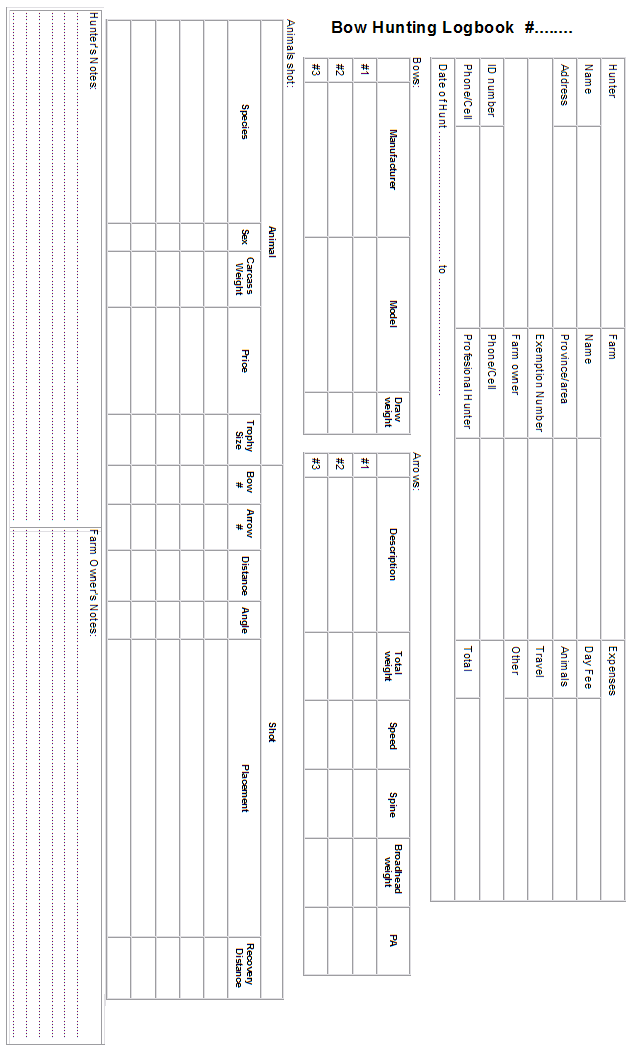
In memoriam...
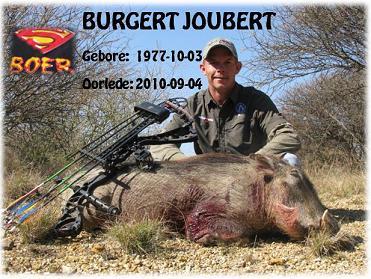


 A note on conventions: All the text that is marked like this, is considered as crucial to bowhunting.
A note on conventions: All the text that is marked like this, is considered as crucial to bowhunting.

 If you alter just the blade height, you also alter the blade angle, or as
If you alter just the blade height, you also alter the blade angle, or as
 St is the frontal surface area of the tip,
At the angle of the tip,
As the blade’s sharpened angle,
H the blade’s height,
L the length of the cutting edge
Ats, is At for chisel points and As for cut on contact points, and the result is
St is the frontal surface area of the tip,
At the angle of the tip,
As the blade’s sharpened angle,
H the blade’s height,
L the length of the cutting edge
Ats, is At for chisel points and As for cut on contact points, and the result is





 where Wt is the total arrow weight,
Wi is the weight of each component,
L is the length of the arrow, and
Li is the distance of the component's center of gravity from the nock point.
Further Reading: Seppie Celliers, AB&A, Apr 2008, p30, "FOC - Front of centre balance"
where Wt is the total arrow weight,
Wi is the weight of each component,
L is the length of the arrow, and
Li is the distance of the component's center of gravity from the nock point.
Further Reading: Seppie Celliers, AB&A, Apr 2008, p30, "FOC - Front of centre balance" In this graph we have for different resistance values, the approximate momentum
In this graph we have for different resistance values, the approximate momentum Imagine you were satisfied to hunt with the suggested minimum requirements - 187
Imagine you were satisfied to hunt with the suggested minimum requirements - 187 The best way in which to compare bows in relation to efficiency, using this last
The best way in which to compare bows in relation to efficiency, using this last The serrations on such a blade do allow it to cut/tear slightly faster through
The serrations on such a blade do allow it to cut/tear slightly faster through


 Further Reading: Seppie Celliers, AB&A, Oct 2007, p51, "Hoe kies ek 'n boog wat my pas?"
Further Reading: Seppie Celliers, AB&A, Oct 2007, p51, "Hoe kies ek 'n boog wat my pas?" A - Standard mechanicals, opening backwards,
B - Two bladed broadheads with smaller "bleeder" blades,
C - Newer type of mechanical, blades opening forward on impact,
D - Mechanicals opening only once inside target,
E - Three bladed broadheads with short to long blade lengths,
F - Judo and Blunt, for use on birds, rodents etc.,
G - Four bladed broadheads,
Also shown is the sliding action of broadhead opening with blades sliding
backwards, and only opening once inside the target.
A - Standard mechanicals, opening backwards,
B - Two bladed broadheads with smaller "bleeder" blades,
C - Newer type of mechanical, blades opening forward on impact,
D - Mechanicals opening only once inside target,
E - Three bladed broadheads with short to long blade lengths,
F - Judo and Blunt, for use on birds, rodents etc.,
G - Four bladed broadheads,
Also shown is the sliding action of broadhead opening with blades sliding
backwards, and only opening once inside the target.





 (Dw draw weight, DL draw length, Bh brace height, Wp pile weight, L shaft length, Ws shaft weight, S spine)
(Dw draw weight, DL draw length, Bh brace height, Wp pile weight, L shaft length, Ws shaft weight, S spine)
 Now let's look at traditional bows and dynamic spine...
How these factors influences the frequency of vibration, is even more complicated. The closest we are able to describe the first fundamental frequency measured by Fourier analysis of a sound recording, is:
Now let's look at traditional bows and dynamic spine...
How these factors influences the frequency of vibration, is even more complicated. The closest we are able to describe the first fundamental frequency measured by Fourier analysis of a sound recording, is:
 Wp is the pile weight of the arrow, L the shaft length, S the s-spine, and Ws the shaft’s weight per inch (as GPI).
Wp is the pile weight of the arrow, L the shaft length, S the s-spine, and Ws the shaft’s weight per inch (as GPI).

 D is draw length, B brace height, F draw weight, and Wt is the total arrow weight.
D is draw length, B brace height, F draw weight, and Wt is the total arrow weight.












 Further Reading: Harry Marx, AB&A, Mar 2008, p14, "Compensating for shooting at a slope"
Further Reading: Harry Marx, AB&A, Mar 2008, p14, "Compensating for shooting at a slope"













 Please note the first column indicate speed needed if no bone is touched, the 2nd column adds energy for 1 rib on entry, the 3 column for 1 rib on exit, and the 4th for 2 ribs. Coulored cells are below, and grey cells above as prescribed by SA-Norms and Standards
Please note the first column indicate speed needed if no bone is touched, the 2nd column adds energy for 1 rib on entry, the 3 column for 1 rib on exit, and the 4th for 2 ribs. Coulored cells are below, and grey cells above as prescribed by SA-Norms and Standards
 Please note the first column indicate speed needed if no bone is touched, the 2nd column adds energy for 1 rib on entry, the 3 column for 1 rib on exit, and the 4th for 2 ribs. Coulored cells are below, and grey cells above as prescribed by SA-Norms and Standards
Please note the first column indicate speed needed if no bone is touched, the 2nd column adds energy for 1 rib on entry, the 3 column for 1 rib on exit, and the 4th for 2 ribs. Coulored cells are below, and grey cells above as prescribed by SA-Norms and Standards
 Please note the first column indicate speed needed if no bone is touched, the 2nd column adds energy for 1 rib on entry, the 3 column for 1 rib on exit, and the 4th for 2 ribs. Coulored cells are below, and grey cells above as prescribed by SA-Norms and Standards
Please note the first column indicate speed needed if no bone is touched, the 2nd column adds energy for 1 rib on entry, the 3 column for 1 rib on exit, and the 4th for 2 ribs. Coulored cells are below, and grey cells above as prescribed by SA-Norms and Standards
 Please note the first column indicate speed needed if no bone is touched, the 2nd column adds energy for 1 rib on entry, the 3 column for 1 rib on exit, and the 4th for 2 ribs. Coulored cells are below, and grey cells above as prescribed by SA-Norms and Standards
Please note the first column indicate speed needed if no bone is touched, the 2nd column adds energy for 1 rib on entry, the 3 column for 1 rib on exit, and the 4th for 2 ribs. Coulored cells are below, and grey cells above as prescribed by SA-Norms and Standards
 Please note the first column indicate speed needed if no bone is touched, the 2nd column adds energy for 1 rib on entry, the 3 column for 1 rib on exit, and the 4th for 2 ribs. Coulored cells are below, and grey cells above as prescribed by SA-Norms and Standards
Please note the first column indicate speed needed if no bone is touched, the 2nd column adds energy for 1 rib on entry, the 3 column for 1 rib on exit, and the 4th for 2 ribs. Coulored cells are below, and grey cells above as prescribed by SA-Norms and Standards
 Please note the first column indicate speed needed if no bone is touched, the 2nd column adds energy for 1 rib on entry, the 3 column for 1 rib on exit, and the 4th for 2 ribs. Coulored cells are below, and grey cells above as prescribed by SA-Norms and Standards
Please note the first column indicate speed needed if no bone is touched, the 2nd column adds energy for 1 rib on entry, the 3 column for 1 rib on exit, and the 4th for 2 ribs. Coulored cells are below, and grey cells above as prescribed by SA-Norms and Standards
































































































